Vietnam
last update: 13 April 2022
Vietnam (Việt Nam), is the birthplace of my French wife. This webpage it's just my attempt to better understand what that meant, and at the same time to work out how to identify and tag people, dates and locations of old family photographs taken in different places in Vietnam.
And this meant understanding where places like Bình Đông, Chợ Lớn were? In addition, we also needed to find the present-day locations for addresses dating back to the French occupation.
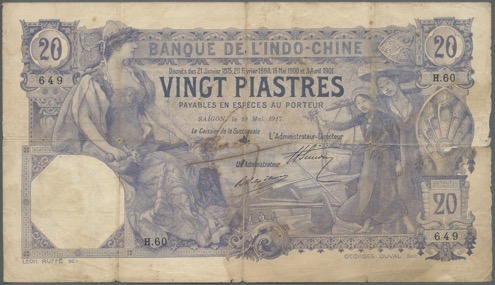
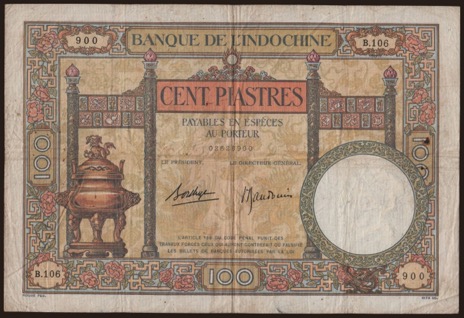
During this text we will encounter both the French franc and the French Indochinese piastre. Initially in the Cochinchina a coin similar to those used in China was already in circulation, probably originally based upon the Spanish silver dollar. When Cambodia became a French protectorate the French introduced a Cambodian franc, and a little later in Cochinchina they introduced the 'cent', a subsidiary coinage of the Spanish dollar unit already in use. With the integration of Annam (central Vietnam) and Tonkin (northern Vietnam) the French introduced in 1885 both the silver piastre de commerce (around 24 grams of silver), and copper-alloy 'cent' coins.
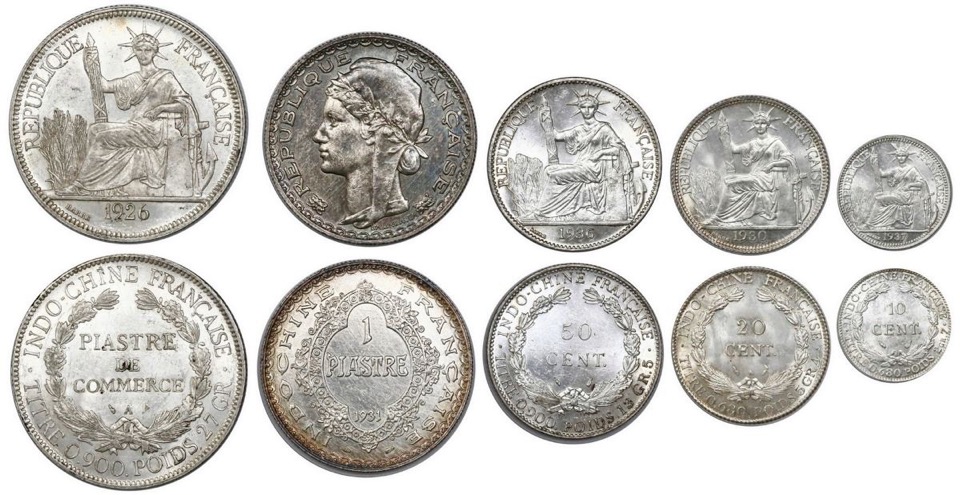
Initially the silver content was the same as the silver dollar, but in 1895 the silver content was dropped a little to stop people hoarding the coin, and the coin just became known as the piastre (but remained on the silver standard until 1930). In 1930 the piastre was again pegged but to the franc at the rate 1 piastre = 10 francs. In 1946 the North Vietnamese đồng, Laos kip, Cambodian riel, and South Vietnamese đồng were introduced on par with the piastre.
So what might those francs or piastre be worth in todays € (say 2015). One franc in 1900 would buy the same good and services as €4.5 in Europe (actually in Sweden) in 2015, whereas the relative worth of one franc in 1930 would only be €0.5 in terms of 2015 prices, and that same one franc in 1950 would be worth only €0.03 in 2015 (remember the 'new franc' was introduced in 1960). The piastre was pegged to the silver dollar until 1930, and was then pegged again as equally to 10 francs. A piastre in 1900 was worth probably more than €11 in 2015 prices, based on the silver content. So it's not surprising to see prices quoted as 0.1 piastre, or the equivalent of around €1 in 2015. But the piastre in 1930 was worth only about €5 in terms of 2015 prices.
On the banknotes you can clearly see the Banque de l’Indochine, which was a privileged bank with a monopoly on the issue of banknotes in the colonies. It was therefore invested with an official mission consisting of financial collaboration in the development policy of the colonies implemented by Paris (initially limited to agriculture). But it was, on the other hand, a commercial enterprise since it was built entirely on private equity capital and had a general meeting of shareholders with supreme decision-making power. So the Banque was partially a tool of French colonial policy, and partly an example of French capitalism in Asia.
So we start by understanding what the map of Vietnam looked like in the early 20th century. Wikipedia has an extensive series of articles on the History of Vietnam, French Indochina, History of Vietnam during WW I, French Indochina in WW II and the French in Indochina (1940-1946).
Introduction
In 1858 Napoleon III ordered Rigault de Genouilly to attack the port of Đà Nẵng (baptised Tourane by the French). In the end he decided to sail south and capture the area around the poorly defended city of Gia Định (present-day Ho Chi Minh City). From 1859 to 1867, French troops expanded their control over all six provinces on the Mekong Delta and in 1871 all the territories formed a colony known as Cochinchina. In 1887, the colony became a confederal member of the Union of French Indochina. Unlike the protectorates of Annam (central Vietnam) and Tonkin (northern Vietnam), Cochinchina was ruled directly by the French, both de jure and de facto, and was represented by a deputy in the National Assembly in Paris.
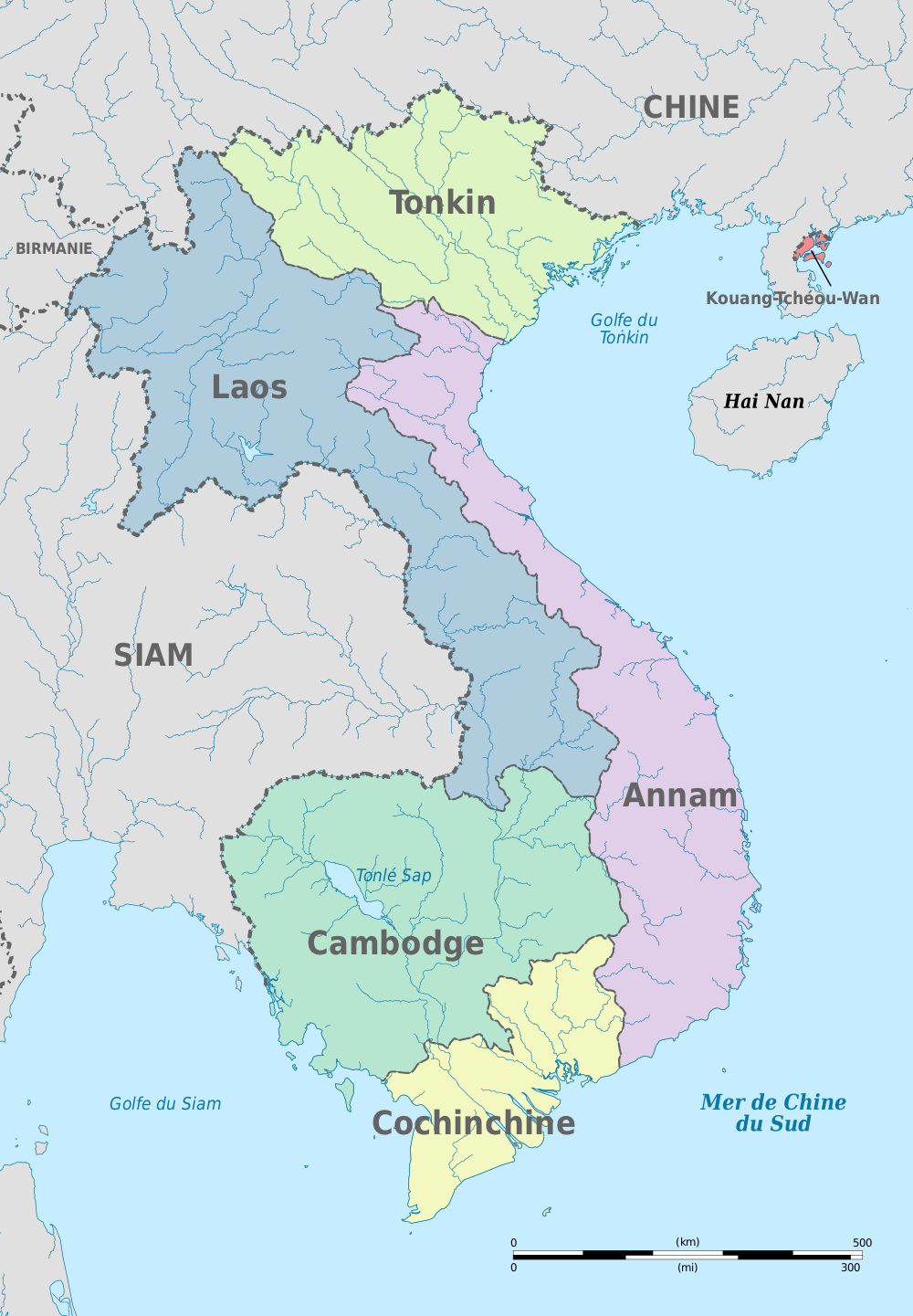
The story goes that Rigault de Genouilly was sent to make a military demonstration on the coast of Annam. French nationals were being persecuted, and the honour of France needed to be defended. It was a simple operation which, obviously, was not to have any sequel. The small numbers (2,000 men) available to the admiral left no doubt about the meaning of this expedition. Yet it was from this brief and limited mission that the initial possession of Saigon resulted. The admiral first attacked 'Tourane' in 1858 and, after having taken the forts of the peninsula and those which blocked the entrance to the river, he had encamped his troops in front of the conquered positions. A rapid victory that was followed by an order to march on Huế. He very wisely considered this undertaking impossible because of the limited troops at his disposal and his ignorance of the countryside. His small troop that were camped around Tourane suffered the terrible attacks of the climate and epidemics and melted away day by day. He wrote "Saigon is on a river accessible to our war corvettes and our transports. The troops, on disembarking, will be on the point of attack. They will therefore have neither steps to take, nor bags, nor food to carry. Saigon is the warehouse of the rice which partly feeds Huế and the Annamese army and which must go north in March. We will stop the rice, and the blow struck in Saigon will prove to the government that, while retaining Tourane, we are capable of external action, and we will humiliate it in its pride, vis-à-vis the kings of Siam and Cambodia, its neighbours who hate and who will not be sorry to find the opportunity to take back what was taken from them".
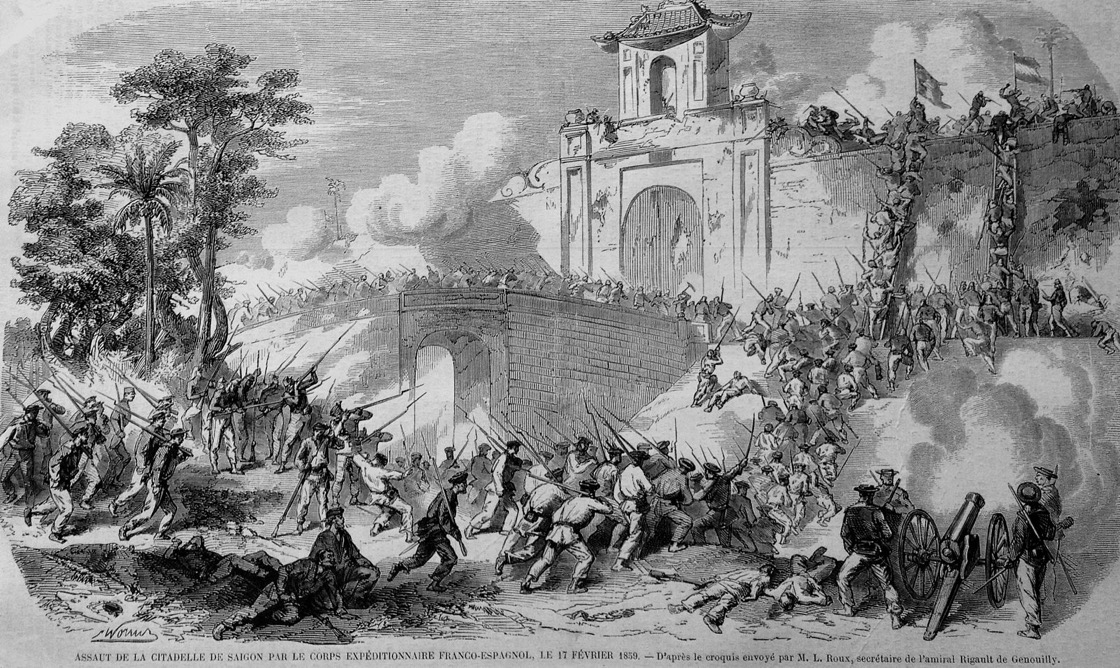
The admiral therefore sailed towards Cochinchina and a couple of weeks later he was in Saigon. He took and destroyed the citadel, and set fire to the rice warehouses where the province's tax in kind was piled up. He certainly did not believe then that this conquest would be preserved, otherwise he would not have destroyed these riches. But Tourane still remained in his mind the main post, and he sent the troops back there, leaving a few hundred men and a few Tagalogs in Saigon. When the war in China began again he looked to put an end to the Annam expedition. He only asks for the opening of a few ports, religious tolerance and the presence of European consuls. He got nothing, so he returns to France without suspecting that it would be Saigon that would bring a glorious end to his expedition. After his departure, Tourane was evacuated. The hostilities in China called all available forces north, leaving a small garrison of barely eight hundred men in Saigon under siege by an Annamese army of twelve thousand men. Finally, in 1860 the China campaign over, part of the expeditionary force was transferred back to Cochinchina. The result is the story of Indochina.
After conquering Cochinchina, the French resumed in 1883 their expansion in Southern Asia. With the Treaty of Tientsin in 1885, China recognised the French protectorate over Annam (Chữ Nôm) and Tonkin (Bắc Kỳ) and implicitly abandoned her own claims to suzerainty over Vietnam. With Cochinchina, Annam and Tonkin became part of French Indochina in 1887. In 1863 a treaty was signed acknowledging Cambodia as a French protectorate, and it also became part of French Indochina in 1887. Laos was also a French protectorate from 1893, and became part of French Indochina in 1899. In 1898 the French leased the Chinese territory of Guangzhouwan for 100 years, and it also became part of French Indochina (it was returned to the Chinese in 1945).
Often Annam was used in the West to refer to Vietnam as a whole, and the Vietnamese people were referred to as Annamites.
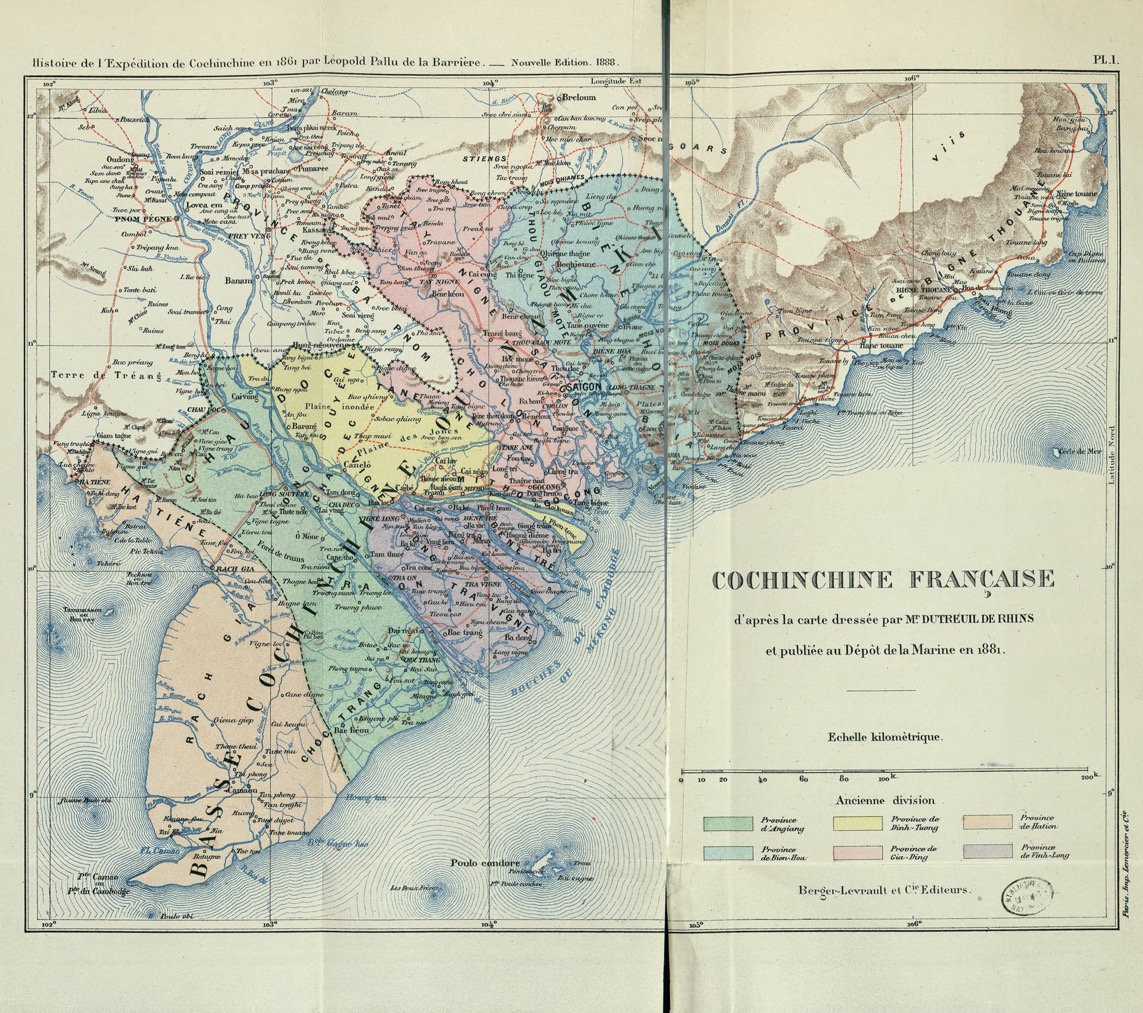
Above we have a map of Cochinchina dated 1861, where we can see the six provinces, namely An Giang, Biên-Hòa (now Đồng Nai), Định Tường (Ding-Tong), Gia Định (Gia-Ding), Hà Tiên (Hatien), and Vīne Long. We can see that Sài Gòn (Saigon) was in the province of Biên-Hòa, whereas Chợ Lớn (Cholon) was in the province of Gia Định.
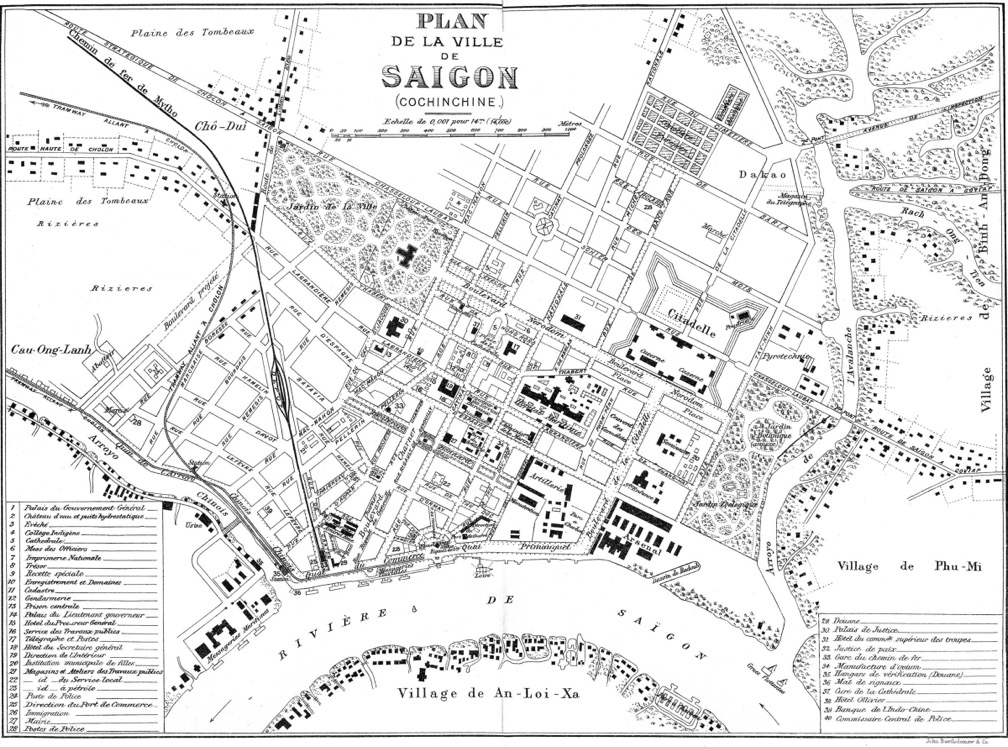
Sài Gòn (Saigon or the French spelling Saïgon) was ceded to France in the 1862 Treaty of Saigon, and the French transformed it into a large town with various French-style buildings, including a botanical garden, Notre-Dame Cathedral (see below), and the Bến Thành Market, etc.
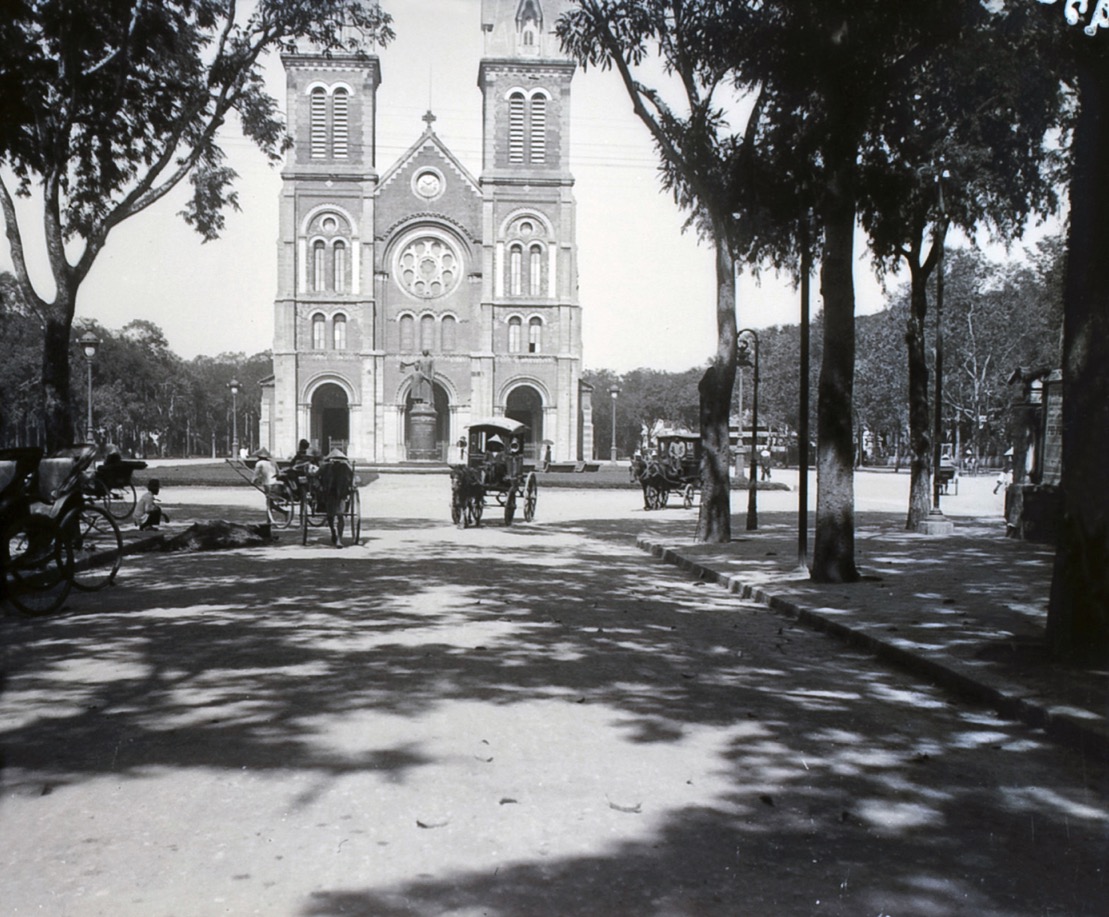
Today Saigon is called Ho Chi Minh City, and is the largest city in Vietnam (the capital remains Hanoi). The above map is from 1896, and in the below view from 1898 we can see that Saigon was acquiring all the features of a traditional European city.
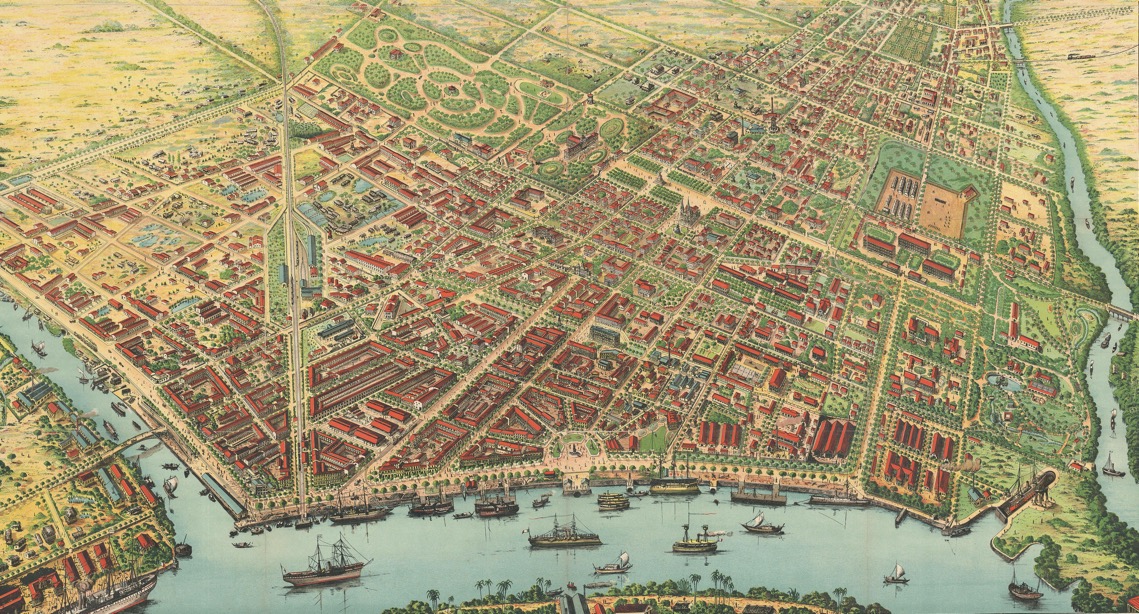
This "Sepia-Toned Tour of 1902 Saigon" includes some photographs of the Zoo and Botanical Garden. There is also a slideshow on Notre-Dame Cathedral in Saigon, and in "A Shopping Trip in Ben Thanh Market in 1938" there are also some interesting historic photographs.
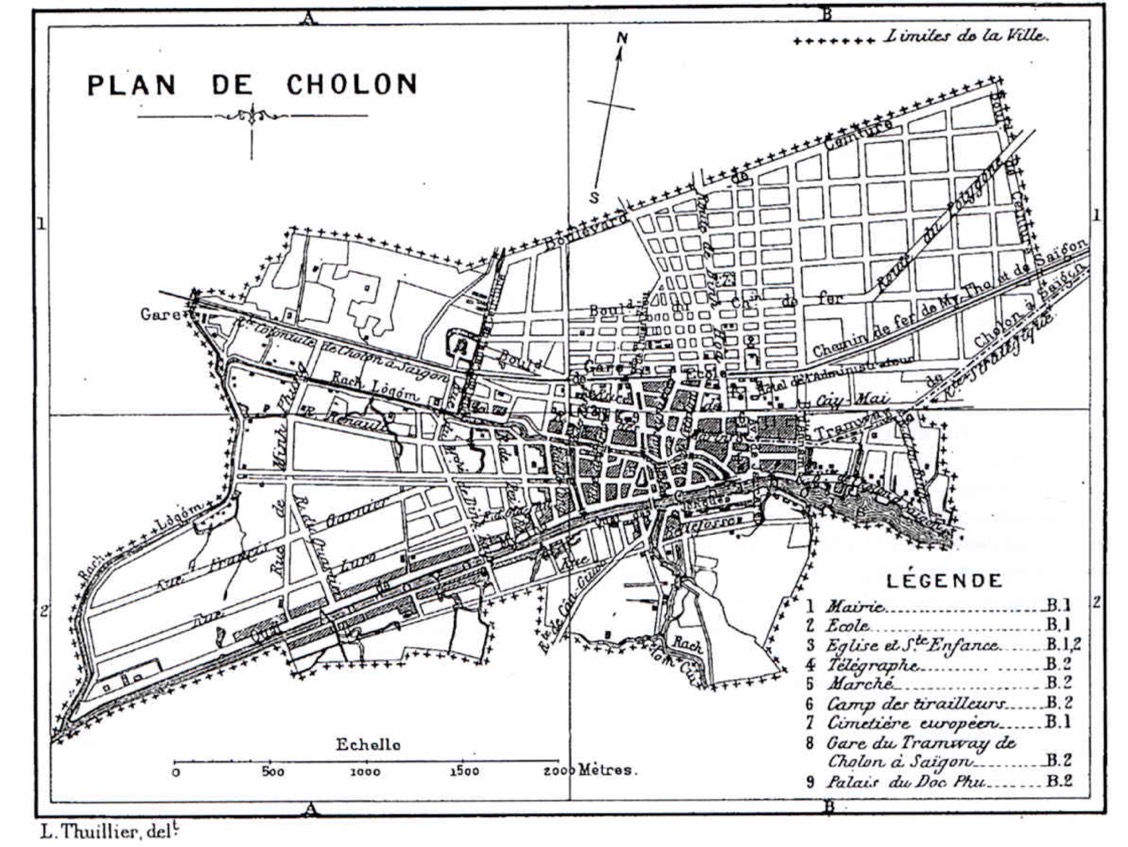
Today Cholon (Chợ Lớn) is also part of Ho Chi Minh City, but originally Cholon and Saigon were two separate places with different parallel destinies. Wikipedia tells us Cholon was inhabited by the Vietnamese Chinese (or the Hoa people), and it suggests that it was originally called Tai-Ngon, meaning "embankment" in Cantonese (French quais), i.e. an area protected by high embankments against the flow of the Saigon River (Sông Sài Gòn). Another suggestion is that the area was more or less defined by the old, and later the new, Bình Tây Market (Chợ Bình Tây), and that Chợ Lớn directly translates as "big market" when it was first established in 1778 (not surprising since the early French called Cholon the "Bazar Chinois"). From that time Cholon was an integral part of Saigons' economy. When Cholon was incorporated as a city in 1879 it lay 11 km from Saigon, today it composes much of Districts 5 and 6 of Ho Chi Minh City.
The French moved into Cholon from 1859 and reinforced the link between the two cities with the construction of two roads and a tram line. Cholon kept its autonomy until the creation in 1931 of a unique urban entity called "Saigon-Cholon", name which was simplified to "Saigon" in 1956.
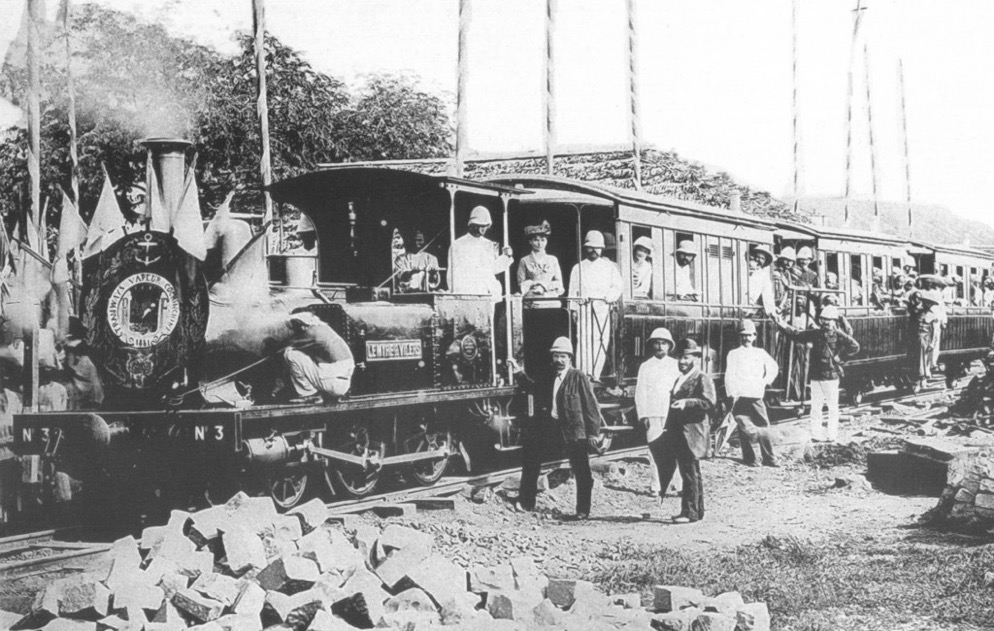
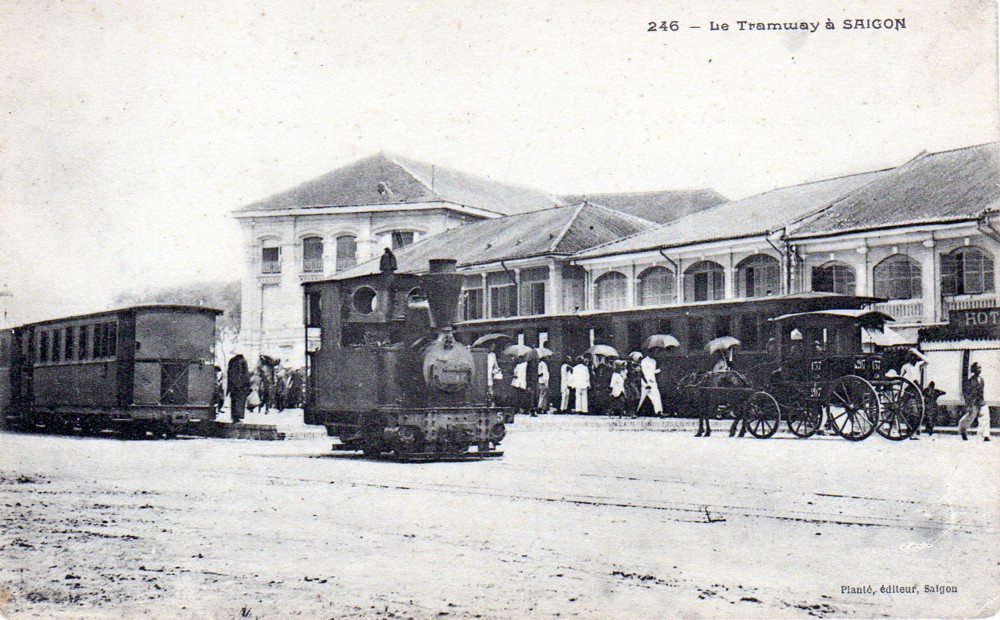
Railways in Vietnam notes that the first steam-tram from Saigon to Cholon ran in 27 December 1881 (above photograph), and at that time the terminal in Saigon was opposite the Bến Thành Market. It was electrified in 1923 (see below), and closed down in 1953.
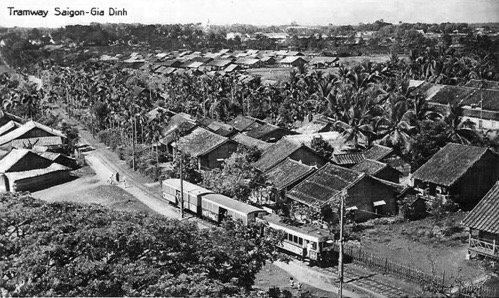
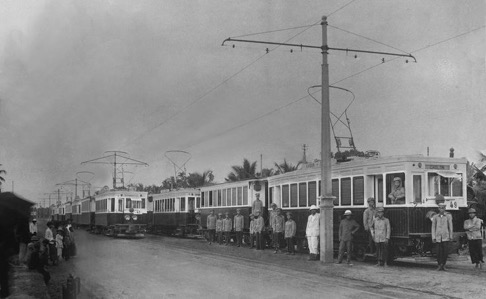
The prices below were taken from the "annuaire général" for the year in question, and I can't explain why the drop in prices in 1906.
In 1900 a 1st class ticket Cholon-Saigon cost 0.30 piastre, 2nd class only 0.20 piastre, for a trip of 14 minutes. And for the transport of merchandise (camionnage) the price was 0.02 piastre for 0-60 kg, and 0.035 piastre for 60-100 kg, and for every 100 kg over that. The value of the piastre in 1900 has been estimate at nearly €15 in 2015 prices.
In 1906 a 1st class ticket Cholon-Saigon cost only 0.10 piastre, and a 3rd class cost 0.03 piastre. For the 2nd class Saigon-Cholon cost 0.08 piastre, whereas Cholon-Saigon cost only 0.04 piastre. And for the transport of merchandise (camionnage) the price was 0.05 francs for 0-60 kg, and 0.10 francs for 60-100 kg, and for every 100 kg over that. To situate these prices, at the time the piastre in 1906 was probably worth around €10 in 2015 prices, so 0.10 piastre would have been the equivalent of €1 today.
It was nice to see that train travel was becoming more 'democratic', for example, there was a 4th class on the line Saigon-Xuân Lộc, and you could also transport your favourite buffalo for 0.06 piastre/km, but with a minimum charge of 1 piastre, or you could transport a dangerous animal (properly caged) for 0.25 piastre/km, with a minimum charge of 5 piastre. I thought a buffalo on a train might be considered dangerous, but apparently not. Naturally you could also take the train with your bicycle, a pousse-pousse, an automobile, and even a cercueil (coffin), which I suppose are all means of transport in themselves.
Check out this very informative article "A Throwback to Saigon's Original Tramway Network" about how the Saigon-Cholon tramway evolved through to 1957.
The Colonial View in 1902
Below we have an extract more or less verbatim from the guide to the Exposition de Hanoï 1902. This is as much an insight of the arrogance of colonial powers at that time, as it is a summary of the peoples living in the region.
"The population of Tonkin can be estimated at around 12 million inhabitants, 10 million of whom live in the Red River Delta. That of Annam can be estimated at 5 million and that of Cochinchina at 2 million inhabitants. Indochina contains, besides, about a million Chinese, as many Thổ, and about ten thousand Europeans. Its total population certainly exceeds 20 million inhabitants. The Tonkinese is taller and more robust than the Cochinchinese, he has more initiative and is more active. The Chinese emigrated in such large numbers to Lower Cochinchina, where they monopolise industry and commerce almost exclusively, rarely go to Tonkin, where the native element struggles energetically against their infiltration.
The Cambodians, naturally apathetic, gradually let the Chinese and the Annamites take their place in the trade and fishing on the Great Lakes (i.e. Tonlé Sap). Laotians and Mois have a reputation for being inactive, fearful and defiantly they cultivate only as much as their food needs require. The Nùng and the Thổ occupy the northernmost part of Tonkin, the former resemble the Chinese type, while the latter seem to belong to the Khmer race.
Despite his many faults, he is secretive, somewhat monotone, occasionally unscrupulous, and an inveterate gambler, the Annamese form the only practical labour force in Indochina, but he is of a gentle character and easy to direct and learns very easily the culture and the handling of machines. His character is submissive, his temperament sober. Under intelligent direction, free from brutality, and on the condition of being paid very regularly, he even sometimes becomes industrious. He excels above all in culture, although he does not emigrate far away, he travels willingly to countries neighbouring his own, but then does not mingle with the local population. This is what happens in Cambodia, where Annamese immigration is relatively high.
The Chinese, more numerous day on day, mainly supply merchants and commercial employees. Many of them also engage in agriculture and fishing in the arroyos. The cultivation of pepper in Hà Tiên occupies a large number of them. The spirit of association and endurance, joined to sobriety, constitute above all their strength. The role of the "Célestes" is mainly to serve as intermediaries between small producers and traders. They are spread throughout Cochinchina, where there is not so small a village that does not have at least one Chinese merchant. They buy everything, and in any quantity, either for their own account or for houses which have made advances to them. Their main source of income is nevertheless constituted by the interest on the usurious loans which they make to the always needy natives. Rarely does the Chinese come to settle in Indochina without hoping to return home, he is almost always only a temporary guest for the colony, and it is in China that he hastens to return back with his earnings".
My wife's father, and his family
According to his French birth certificate, my wife's father, Paul Car…, was born in Bình Đông, Chợ Lớn. And we know my wife's father, Paul, had an older brother, presumably also born in Bình Đông.
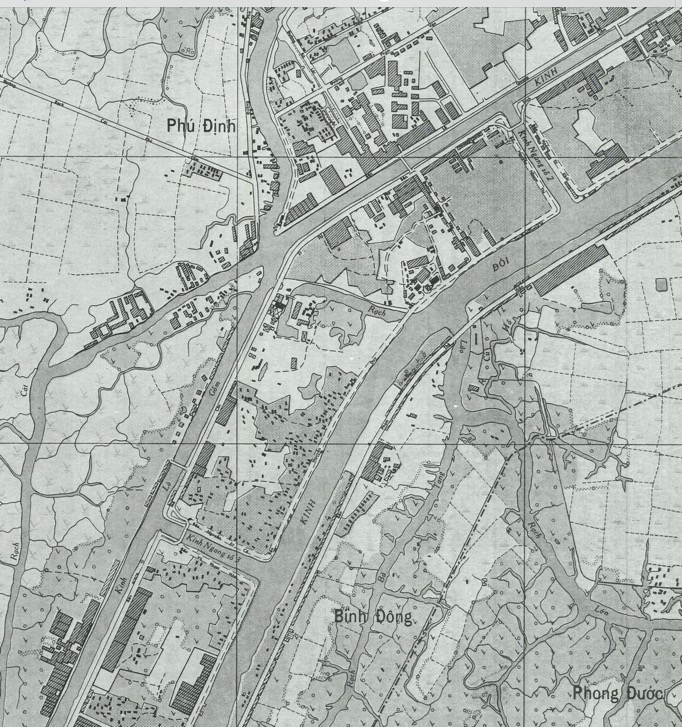
In 1897 the whole Cholon province was divided into 12 cantons (tổng), one called Tân Phong Hạ had 5 villages (làng), one of which was called Bình Đông. From 1899 there was considerable reorganisation of the regions, and the 5 villages were merged into Tân Phong Hạ. In 1939, Bình Đông was no longer mentioned in the four districts (quận) that made up Cholon. But today Bình Đông is alive and kicking. Still today the Tàu Hủ Canal that runs through Ho Chi Minh City is also known as the Bình Đông. This was a canal originally built in the early 1800's, and dredged in 1889 under French rule. There is a mention of it being used to transport fruit and vegetables into Saigon. The wharf-road that runs along the south side of canal is also called Bình Đông and is a stop on some bus routes. A bit further out of the city, Bình Đông is also the name of the local parish church. So we can make a good guess as to where my wife's father was born. A map covering the early 1900's indicated that Bình Đông was just at the edge of Cholon, about 3 km from the centre of the town. One early description of Bình Đông mentioned an important poste de miliciens (military post) and a usine à riz (rice factory and shops). In a map of 1923 it shows that in that area of Cholon there was already a Commissariat of Police, the Distillery Fontaine (see below), six different factories, a market, and the abattoir of Bình Đông.
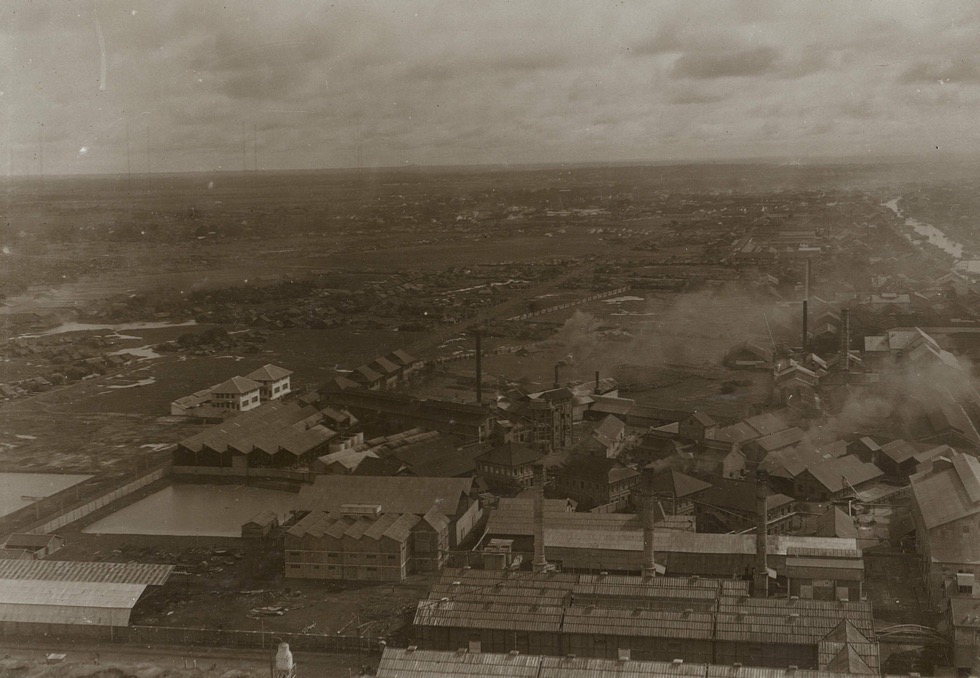
Auguste Raphael Fontaine obtained the monopoly of alcohol production in Cochinchina, undertaking at the same time to buy the existing Chinese distilleries (see photograph above). The Chinese organised campaigns hostile to the French company, which led to a boycott of Fontaine/Calmette alcohol by the Vietnamese. The sale of alcohol, hitherto taxed directly, was subsequently conceded to the Chinese, and the boycott was dropped. The alcohol monopoly, like the opium and salt monopolies, was one of "trois bêtes de somme" (beasts of burden), i.e. the basis of a stable taxation systems essential to maintaining the fiscal health of the local regime. Have a look at this article "A History of Rice Wine - Family Stills, Prohibition and Colonial Bloodshed".
It's interesting to read that at the same time as alcohol was seen, with opium and salt, as one of the three key pillars of a stable tax system in the colony, there were notices posted about the dangers of alcohol. "Avant toute chose il faut observer que la condition essentielle pour conserver un bon état de santé est d'eviter soigneusement tout excès, l'excès de boissons surtout est particulièrement néfaste" (First of all, it should be noted that the essential condition for maintaining a good state of health is to carefully avoid any excess, the excess of drinking especially is particularly harmful).
A "Commissariat" is a local precinct of the French "police nationale", and a "commissaire de police" is in charge of both the administrative and investigative roles in a "Commissariat".
My wife's paternal grandfather was René Car…, and her paternal grandmother (i.e. the mother of my wife's father), was from Sóc Trăng, on the Mekong Delta (we don't know where and when she passed away). René Car… finished his career as a Commissaire 1re classe de Police Municipale in Saigon. I will spend a little time looking at the police in Indochina because it just so happens that my wife's maternal grandfather, Eugène Fis…, was also in the police in Saigon, and it's very likely that my wife's parents met because of that connection.
Sóc Trăng is today the name of a city and province, but in earlier times it was known for the quality of its rice and for the production of lac, which provides a scarlet resinous secretion often called shellac.
In the early 1900's a René Car…, almost certainly my wife's paternal grandfather, was an “agent temporaire” in the “bureau comptabilité” in the Administration des Travaux Publics de l'Indo-Chine in Saigon. During the 1910's, René Car…, joined the police in Indochine, but first appeared on the roster of the Police Municipale in Phnom-penh, Cambodia, where he remained in service for around 7 years. During that time he rose to agent 1re classe, and near the end of that period he was détaché to the Police de Sureté du Cambodge. Also during that same period he changed from the Police Municipale to the Police Urbaine. After his secondment he appears to have transferred to the Police Urbaine in Saigon, with a promotion to commissaire 3e classe. He would spend a period as commissaire de Police in Bình Tây (the market area of Cholon) before returning to Saigon, where he would rise through the ranks to commissaire 1re classe before retiring from the Police Municipale.
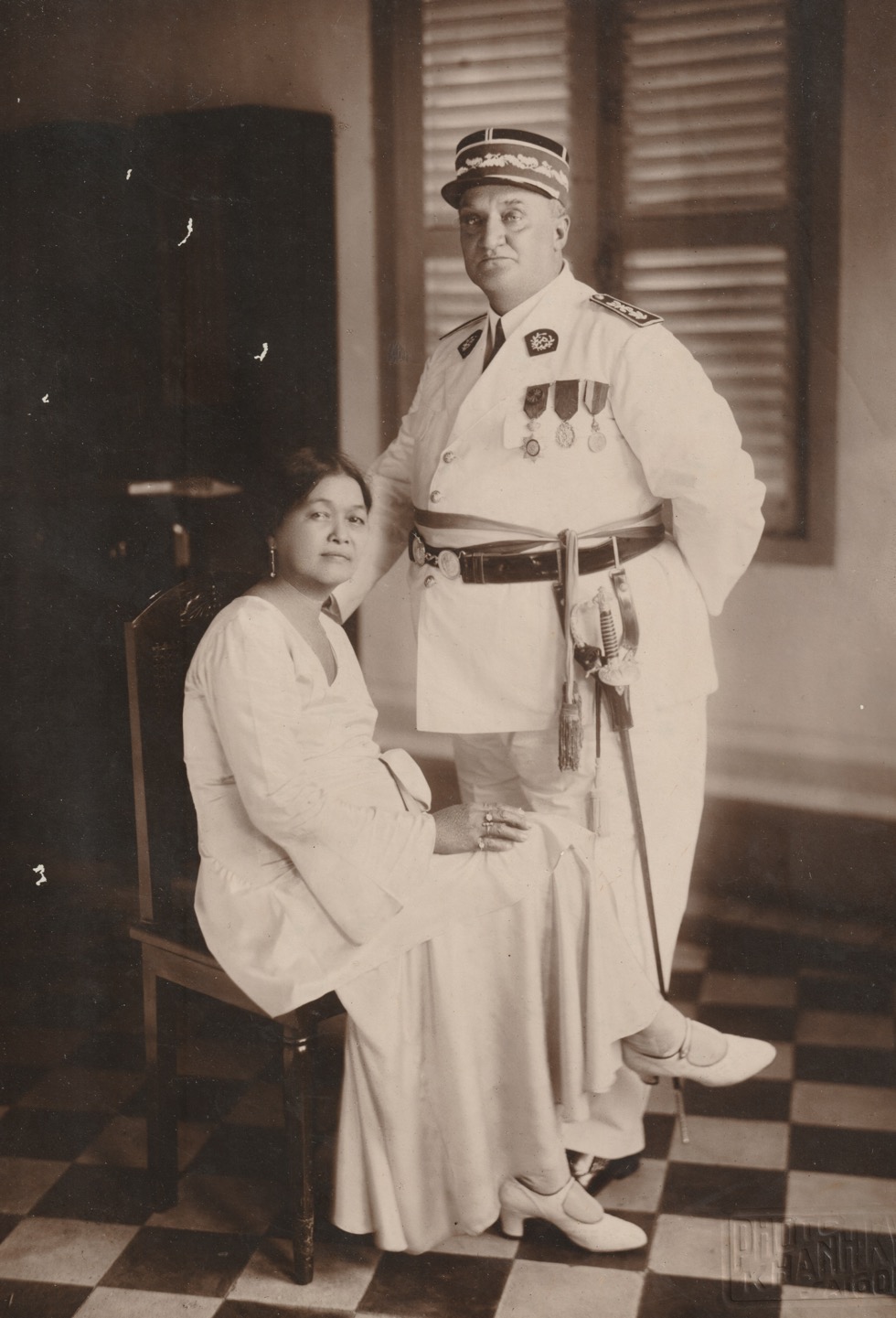
Above we have René Car… and his wife Louise. Very much helped by this description, it would appear that the because he still wears the képi this would date the photograph to before 1933 (when the képi was replaced by a cap or caquette).
https://www.passionmilitaria.com/t198669-uniforme-commissaire-de-la-surete-general-en-indochine-1933-1945
Removable badge in silver cannetille with the "arms of the Republic".
It is embellished with a removable tray cover in white canvas "with a window", allowing the macaroon to be seen.
"English" jacket with 4 pockets bearing silver buttons "with the arms of the Republic", they are identical to those of the prefectural body and the metropolitan police.
The "blue silk" belt is in fact in very dark blue mohair, almost black. 55mm silver buckle with button patterns.
"Scarf of police commissioner with silver tassels with large twists".... Again, these two accessories are similar to those worn in mainland France on the same date.
Silver-embroidered facings with a 4 cm wide band of cannetille embroidery with silver sequins (group of oak leaves) silver-embroidered on both sides. They are positioned on the tunic in such a way as to simulate the wearing of white cuffs.
Ditto shoulder pads, here simple shoulder loops.
Chest decorated with the orders of Knight of the Legion of Honor, Officer of the Dragon of Annam, Knight of the Royal Order of Cambodia and Order of Miniseraphon (Indochinese Academic Palms)
On the collar, insignia like those of the cap badge (here absent)
White pants.
Metropolitan police commissioner's sword, silver-mounted with its black mohair strap with large twisted silver tassel.
The uniform will soon be completed with its removable collar tabs and embroidered flat shoulder pads....
The one thing I find difficult to understand is that René Car… spent time, according to official records, initially in the Police Municipale in Phnom-penh, before moving to the Police Urbaine in both in Phnom-penh and Saigon, and then finishing his career again in the Police Municipale in Saigon, but what was the difference?
Firstly, according to one source the Police de Sureté du Cambodge was charged with the surveillance of the population including foreigners. They were involved in complex judicial police investigations, they checked the correspondence of French and Cambodian administrators, verified the personal administrative files of Cambodian civil servants, and analysed the tax declarations of key individuals.
I've not been able to isolate a set of clear definitions nor their exact jurisdictions for either the Police Municipale or the Police Urbaine in Indochine. Today France still has a Police Municipale, but not a Police Urbaine. The French Police Municipale are a form of "police de proximité" (local police), under the authority of a mayor of a municipality. The Police Municipale obey the decrees of the mayor, whilst the national police follows and applies the instructions and directives of the French Ministry of the Interior. Today a municipal police officer has the quality of assistant judicial police officer, and his principle role is to ensure good order, safety, security and public health (including traffic offences).
Hints from the past suggest that the Police Municipale in Indochina performed a multitude of activities from the surveillance of 'drinking establishments', through the repression of fraud, to ensuring the cleanliness of the city and avoiding damage to public buildings (assurer les bon ordre, la sûreté et la salubrité publiques). In the past the Police Municipale in Indochina appears to have been associated with the many problems deriving from the movement of indigenous populations, and their spatial segregation inside colonial cities. It is my understanding that the mayor (maire) could nominate les agents de la Police Municipale, except for the commissaires de police, but could not later suspend or revoke their nomination. Interestingly, if a mayor decided not to allocate sufficient funds for the Police Municipale they could be forced to change the budget, i.e. the cost of Police Municipale, except for the commissaires de police, was covered by the municipality.
As far as I can understand things, Police Urbaine in Indochina were uniformed civil servants that maintained public order, had powers associated with population control, securing sensitive buildings, residences and public buildings, and acted to prevent and repress criminal offences. There appears to have been a kind of transfer of responsibilities, procedures and personnel from the colonial army to the Police Urbaine in terms of maintaining order, and even including the "service des renseignements" (intelligence services). There is mention on the need to "monitor the turbulent elements of the cities" and the surveillance of "foreigners, religious propagandist and individual who come to carry out evil actions". This included maintaining order in public places (symbols of the new power), guaranteeing the security of communication routes, surveillance of the press, and prevention and repression of crime, all in one way or another linked to urban areas and cities.
Given the not inconsiderable movement of indigenous peoples into urban areas, there was for both police forces a "civilising mission", i.e. the education of a colonised population in the principles of urban norms, making them "city-dwellers". Behind the scenes there was also the need to control the distribution of colonial spaces between the French/European populations and the indigenous peoples, i.e. ensuring that everyone had a place, and also "knew their place".
One worrying point is that the police in Indochina is mentioned in numerous texts, often not in a complimentary way, but I must question some of the comments and conclusions when not one of those texts draws the minimum distinction between Police Urbaine and Police Municipale, and for that matter makes no mention of the role of the Secrétariat de Police. I'm not sure what the differences were, and this appears to be the case for everyone else.
I might add that in 1932 in addition to the Police de la Sûreté générale (who's work was simply defined as "renseignements politiques"), and the Police Urbaine and Police Municipale, there were a whole series of other 'police' forces operating in Indochina. A certainly incomplete list included:-
Police sanitaire maritime (protection de la santé publique, vaccine et prophylaxie des maladies transmissibles)
Police sanitaire (l'assistance médicale, les épidémies, l'hygiène, la protection de la santé publique et les hôpitaux, lazarets, asiles, sanatoria et établissements diverse d'instruction médicale autres que l'Ecole de Médecine de Hanoi)
Police des étrangers de la Bureau des Affaires Politiques et Indigènes (interdictions de séjour, expulsions, questions concernant la défense nationale)
Laboratoires et Services d'Identité des Polices
Police Générale (Gendarmerie, police de la circulation, contrôle des automobiles)
Police Frontière
Police Locales
Police de la Navigation (sécurité, accidents de mer, assistance et sauvetage, épaves).
The Gendarmerie is a branch of the French army, and as such they are soldiers. Whilst the police operate in cities, the gendarme normally operates in all places that are not urban areas/agglomerations/communes of 25,000 inhabitants or more, i.e. in rural and suburban areas.
According to some reports the Gendarmerie (re)appeared in Indochina in the last quarter of 1946. Deducted from the troops deployed in Germany, Austria, then, as a last resort, from those in mainland France, they consisted of three "Legions of March" or Republican Guards. The 1st Legion supervises the Cochinchina Civil Guard, the 2nd Legion was deployed around Saigon, and the 3rd Legion was initially deployed in Tonkin. Between 1946 and 1956 there were nearly 14,000 men who succeeded each other on the peninsula, with an average stay of 24 months. Their presence concluded in 1956 with the training of the armies of the new associated States.
However, looking though the administrative accounts of Indochine it is clear that the Gendarmerie was always present outside the urban areas, because you often saw reference to a figure of authority as "Gendarme, faisant fonctions de commissaire de Police".
The problem in looking though the accounts is that you encounter "la police urbane, la garde indigéne, fonctionnaires municipaux, personnel militarie, police communles, police générale, police et prison", with no description and no coherent structure.
We mentioned that my wife's father, Paul Car…, was born in Bình Đông, Cholon. However my wife's paternal great-grandfather (Léon Car…, father of René Car…, and grandfather to Paul Car…), was born in Paris, and later moved to Indochina. He first lived in Cholon, is thought to have retired in Thủ Đức, but he died in Saigon (all now part of Ho Chi Minh City). We know only a little of his life.
In 1910's there was a direct reference to a Léon Car… as a "tanneur" in Saigon, as well as a reference to a Maurice Car…, also a "tanneur" in Saigon. In a separate reference for the same year it showed Léon Car… “tanneur” living at 33 rue Amiral-Dupré, Saigon. Interestingly at 29 rue Amiral-Dupré there was Maurice Car…, but with the note “cycles”.
Later there was a "Léon Car…, corroyeur, Saigon" registered in the "liste les électeurs consulaires". And also there was a separate reference to a L. Car… registered as a "corroyeur" Au Roi des Jungles, 165, Boulevard Charner. Along side this there was a M. L. Car…, mentioned as "tanneur, corroyeur, repassage d'instruments". We all know what a tanner was (and still is), but a "corroyeur" (currier) is actually someone who dresses, finishes and colours a tanned hide to make it strong, flexible and waterproof. "Repassage d'instruments" is an odd expression, but it appears to have something to do with hospitals. It was a relatively limited budget line, and it was classed along with office equipment and repair of tables and the repair and soldering of instruments. Almost certainly it meant the re-sharpening of knives, etc. using a soft stone (which is a tool also used in currieries). I have no idea what "Au Roi des Jungles" refers to.
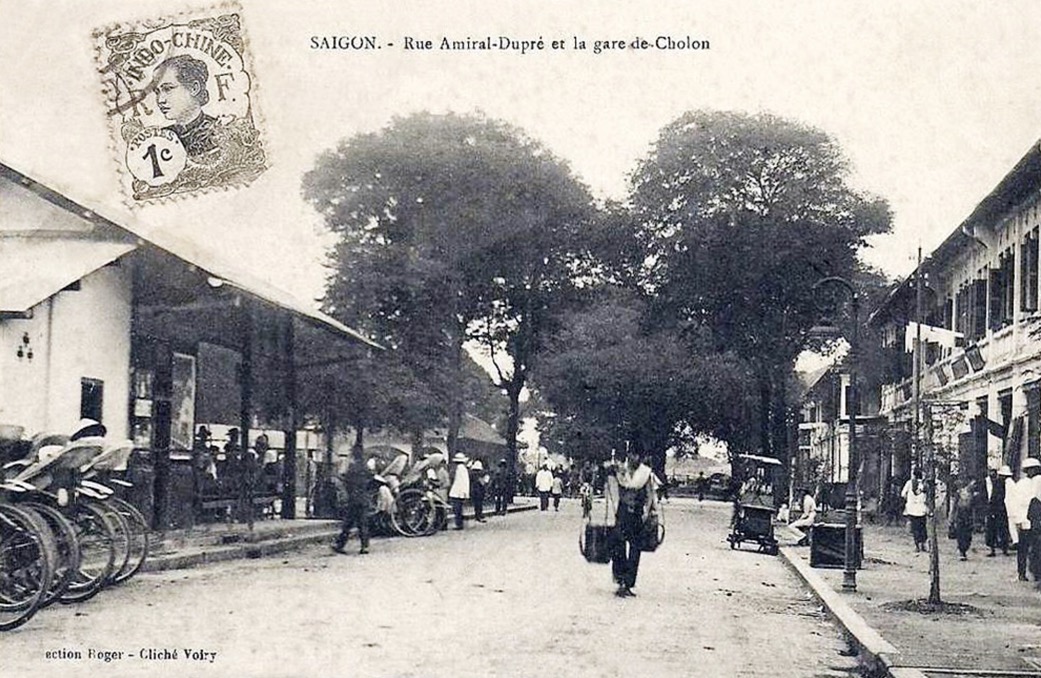
Rue Amiral-Dupré (now Đông Du, Bến Nghé, Quận 1, Thành phố Hồ Chí Minh) was named after Marie Jules Dupré and occupied a prime position in 'down-town' Saigon, just off rue Catinat. The street was quite commercial with restaurateurs, barbiers, joailliers, blanchisseurs, boulangers, charcutiers (restaurants, barbers, jewellers, launderers, bakers, butchers), an unusually number of gargotiers (innkeepers) and loueurs en garni (furnished rentals), a marchand de vin (wine merchant), and a selliers-carrossiers (saddlers-bodybuilders). This last company was at N° 33, the same address as Léon Car…, which may not be surprising given his profession as a tanner (tanneur).
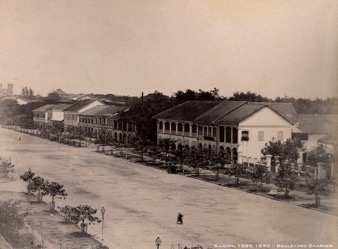

Boulevard Charner (now called Nguyễn Huệ, Bến Nghé, Quận 1, Thành phố Hồ Chí Minh) was named after Léonard Charner, once commander in chief of the land and sea forces in Cochinchina. Before being filled in, this was called le Grand Canal. Originally the canal was flanked by two streets, one named rue Charner and the other rue Rigault-de-Genouilly. Given the pestilential odours that emanated from the canal, the residents asked for it to be filled. It took 18 years but finally the "Canal Charner" became "Boulevard Charner". Above left dates from 1890 and on the right from ca. 1925. At the time it was one of the most important streets in Saigon, and was home to the Hôtel de Ville (City Hall) as well as the Café Coq d'Or (N°62), the Comptoir d'Extreme-Orient (N°125), Galeries Lafayette (N°14), Pathé-Orient (N°10), as well as several garages, and several traders in salt. Aurélien Pestel (1655-1897), pioneering photographer, died at 10 Bd. Charner. Saïgon/Vietnam has an interesting article on le Boulevard Charner, and VnExpress looks at how Saigon's iconic street has changed over the past 150 years.
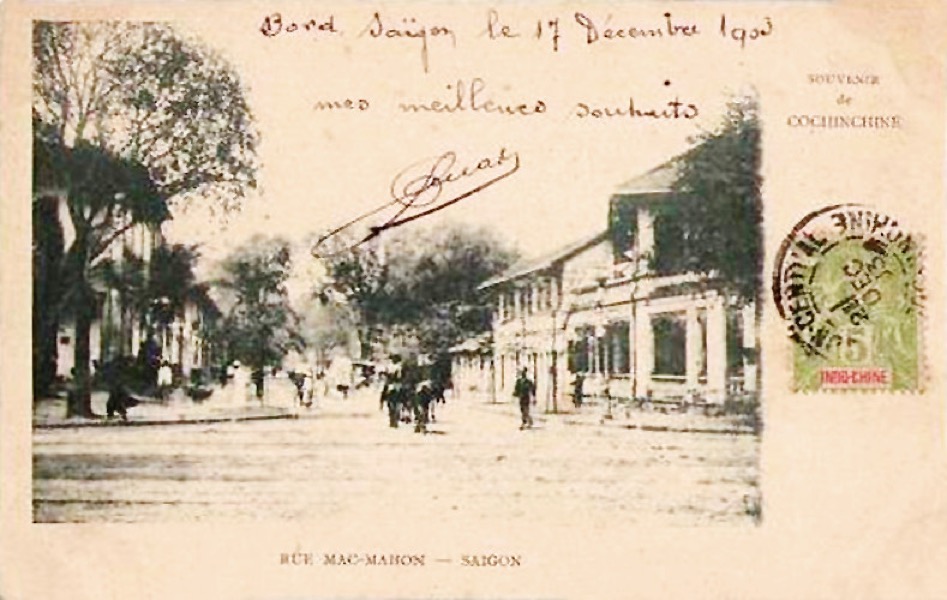
Later still there was a reference to a Car… (corroyeurs), living at 96 rue Mac-Mahon (now Đ. Nam Kỳ Khởi Nghĩa, Thành phố Hồ Chí Minh). This road is mentioned in an article by Saigoneer on the former Nestlé headquarters in the 1930's. The original street was named after Patrice de MacMahon, in honour of his role as Maréchal, because at the time he had not yet become President of France. It looks like the road would later be renamed rue General de Gaulle.
A few years later L. Car… (corroyeur) would be registered at Bd Luro (now Đ. Tôn Đức Thắng, Bến Nghé, Quận 1, Thành phố Hồ Chí Minh). Bd Luro was once one of the old Annamese roads in Saigon. It was the one which, from the river, led to the citadel, and it was used when the French took the citadel. The name was given in 1901 as a public tribute to the memory of Eliacin Luro, the founder and director of the college of trainee administrators of Saigon. Tôn Đức Thắng was the first president of the reunified Vietnam.
It would appear that Léon Car… was a "European non-fontionnaire", which in the early 20th century was still rare. It was estimated that, in addition to military personnel, most of the French were civil servants, including everything from curé, avocats-défenseurs and elèves géomètre to dames-téléphonistes and huissiers. French companies were present in certain specialist areas (e.g. street lighting, arms, banking, beer and bread, etc.), but the Vietnamese rapidly became dominate in furniture, school equipment, jewellery, wood, washing and cleaning, clothes making, food, paper, etc. So my wife's paternal great-grandfather was almost certainly a tanneur (tanner), which might also explain why the family was initially installed near Cholon, home to the traditional market and abattoir which serviced Saigon.
Saigon - the early years
As the most important commercial hub of Vietnam, Saigon had a humble origin as a frontier post where people from a diverse background came to make their fortune and/or to escape their former lives. The city of Saigon, as we know it today, took shape over a long period of nearly 400 years, and went through several stages of development under different masters, from Khmer kings to the Nguyễn dynasty of Vietnam, the French colonial power, and then as a Socialist Republic. The first time the territory was mentioned in Vietnamese documents was in 1623 when the then king of Cambodia Chey Chetta II agreed to let the Việt set up two custom-posts one at Sài Gòn and one at an adjacent site today known as Bến Nghé. The names of these two locations were later changed around during the French occupation, what was called Saigon then became today’s Chinatown Chợ Lớn, and Bến Nghé became today’s Saigon.
Historically, the site of today’s Saigon was a wild and muddy area but not uninhabitable as observed by the Nguyễn when they came to establish their custom-posts. They would have found a Khmer settlement there, surrounded by stagnant ponds and a dense jungle full of wildlife. The Khmers were settled there, probably for centuries, living on the raw products they found in the area, such as wild animals, trees for building house and fuel, etc. They lived in stilt houses on dry high ground along a stretch of land running north up to the Đồng Nai river, about 20 kms away.
Sailing in Southeast-Asia depended on the monsoon winds, the north-easterly wind for the southbound voyages between late December and early March and the south-easterly wind in July for the northbound trip. In between, the merchants needed somewhere to stay and a number of trading depots along the East-West Maritime Route were created as the result. Saigon was known to be one of these from the 17th century onward. While resting, the merchants stocked up on local products which were brought to them from the hinterland mainly by boats. A barge, or junk, could carry a larger load and travel more efficiently than oxcarts, or by porters, who would have to negotiate difficult and unpredictable roads. Between Cambodia, Siam, Laos and today’s coast of Vietnam, the main waterway was the Mekong River, and further north from the Mekong, the Đồng Nai river acted as the main artery between the inland and the coast.
The 17th century was a busy time for the Nguyễn Lords who held power in central Vietnam, and resided in Phú Xuân, today’s Huế. Despite, or because, of their on-going war with their rival, the Trịnh, the power behind the court in today’s Hanoi, the Nguyễn began to expand southward to occupy more land, and to secure crucial supplies such as rice and materials for ship-building and weapon production. Following the footsteps of the first Lord Nguyễn Hoàng and continuing under his successors, the Việt moved steadily and systematically south in a colonising movement later termed the Nam Tiến. They first took over a large swathe of land from the kingdoms of Champa, the group of coastal polities occupying the lower part of central Vietnam. By 1653, the Việt had moved far enough south to have a Khmer-Việt border that did not exist before. By the end of the 17th century internal trouble had weakened the Khmer court to the point that the Vietnamese could expand further westward and southward, almost without resistance. This meant that the Nguyễn occupied the land between the two main rivers Mekong and Đồng Nai, pushing even further south of the Mekong River, and consolidated their presence in Saigon.
Following the establishment of the Nguyễn custom-houses of Saigon and Bến Nghé in 1623, Việt immigrants began to settle in the region, and gradually migrated into Saigon itself. People from all walks of life and a variety of ethnicities lived together, although not always in harmony. The most prominent among these were the Khmer, the Việt and, later, the Chinese who arrived in 1679. These Chinese belonged to one of the two groups of 3000 Ming loyalists who sailed south from China to ask the Nguyễn for asylum from the Qing and were told to settle in today’s Biên Hòa. They gradually expanded south to become neighbours of the traditional Khmers and the Việt. The second Ming group was directed to settle in today’s Mỹ Tho on the Mekong.
The Chinese were particularly industrious at their first chosen site by the Đồng Nai river. Here, they established a large port on a river island called Cù Lao Phố. Before long, this island became a major depôt of goods from the Vietnamese highlands and Cambodia, earning it the name of Cảng Đại Phố (the great port of Phố), a busy market only second to Bến Nghé, nearer to the sea. By 1693, the Nguyễn’s control stretched from today’s Bình Thuận to the Mekong Delta, a huge piece of land. A Grand Mandarin Nguyễn Hữu Cảnh was appointed and quickly established administrative units for the area, such as towns, districts and villages and then appealed to people from northern provinces to move in to settle. The existing Chinese were grouped into their own villages and called the Minh Hương (Ming loyalists), and in 1693 they were officially entered in the Việt population register. Under Nguyễn Hữu Cảnh, the number of people was recorded as over 40,000 households, and the region was listed as thousands of square kilometres. For his governing seat, Nguyễn Hữu Cảnh chose Saigon, which was quickly developed into a site where products from both the mountains and the Mekong Delta gathered to find the best maritime traders from India, Japan, China and even further in both east-west directions. The produce from the Mekong were transported north via a system of rivers and canals, and from the mountains by foot-porters along the upstream of the river Đồng Nai where it was full of rapids and cascades. Further downstream, the goods were carried by boats as the water became calmer north of Biên Hòa.
For most of the 18th century, the market that became the city of Saigon continued to grow out of necessity. Houses, official buildings and garrisons were constructed but roads were haphazardly built, as the main means of transport was still by waterways. Mid-18th century, however, was a busy time for commerce with rice from the Mekong Delta being the most sought-after commodity. Many new canals were dug by hand during this period, for the small natural rivers and creeks serving the area tended to silt up during the dry season, forcing merchants to cease all activities and wait until the water was high enough to travel again. The Nguyễn authority ordered an extensive clean-up of the existing canals and for new canals to be dug to facilitate the flow of water. The first ones were dug in Saigon, which is today’s Chợ Lớn. A major canal called "Ruột Ngựa" was created in 1772, so called because it was "as straight as a horse gut".
The convenience of water travel in Saigon and Bến Nghé drew more people to settle along the river and canal banks, bringing with them a variety of skills, such as pottery making, boat-building, wood carving, jewellery making and carpentry etc. Each group of artisans gathered in their own enclave, creating a rich tapestry of professional wards flourishing along the rivers and canals of Saigon, some of them, such as the potters were still in business until the beginning of the 20th century, when a French canal cleaning and filling campaign drove them out of business. The growth of the handicraft industries, in turn, inspired yet more canals to be dug, each one carried the name of the product they were created for. Along the canals and the rivers, there were several boatyards acting as 'garages' for boat repair and maintenance. These yards were built on slightly higher ground, making them convenient for later land constructions. The canals were filled up to become roads in the late 19th and early 20th centuries.
The ease of travel from the South China Sea to Saigon turned into a lethal weapon against the city. Following the journey that many merchant ships had taken before, the French fleet travelled up the Saigon river and start with a heavy bombardment before launching a ground assault. Saigon quickly succumbed on February 17, 1859.
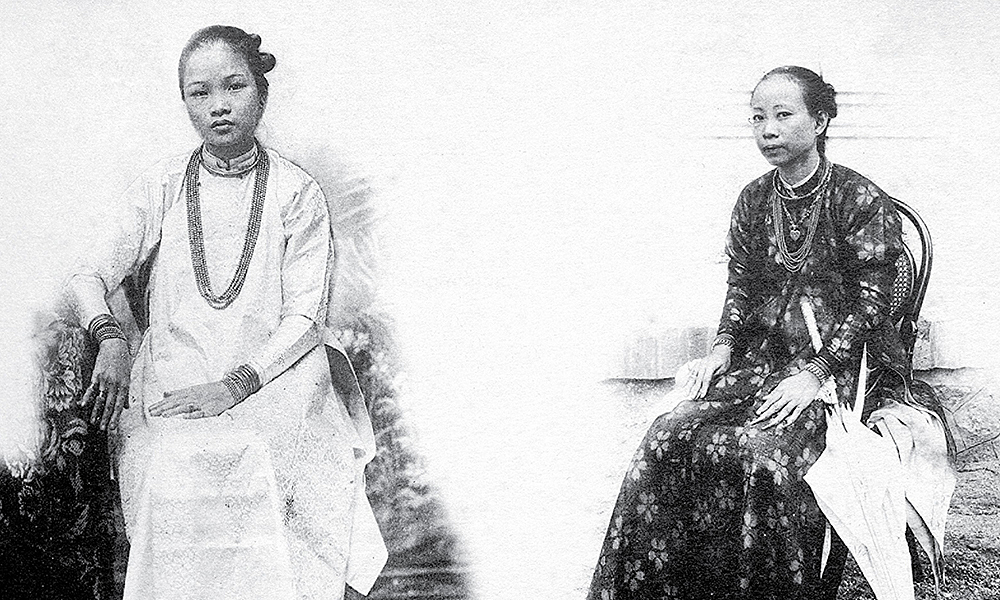
There is a wonderfully evocative article with photographs of daily life in Vietnam in the 1880's, and I quote "At the end of the 19th century southern women preferred "ao ngu than" (five-piece ao dai) and beaded jewellery. According to designer Sy Hoang, rich women used to wear this type of ao dai, with four layers representing the parents of the wife and husband and the fifth, the wearer. The tunic also had five buttons, symbolic of the five qualities everyone should have - nhan (kindness), le (decorum), nghia (uprightness), tri (wisdom) and tin (faithfulness)". Here is another collection of photographs from as early as 1866, and here we have 35 rare photographs from the 1880's.
Here is an extensive review of the history of Photography in Vietnam from the End of the Nineteenth Century.
One report noted that the population of Saigon in 1905 was 54,745, exclusive of naval and military forces. The French population numbered 8,749, other Europeans 152, Chinese 14,000 and Annamites about 30,000. On the other hand Cholon had a population of 140,000, was the market for both Cochinchina and Cambodia, was the residence of all Chinese merchants, and was the place were all the rice mills could be found.
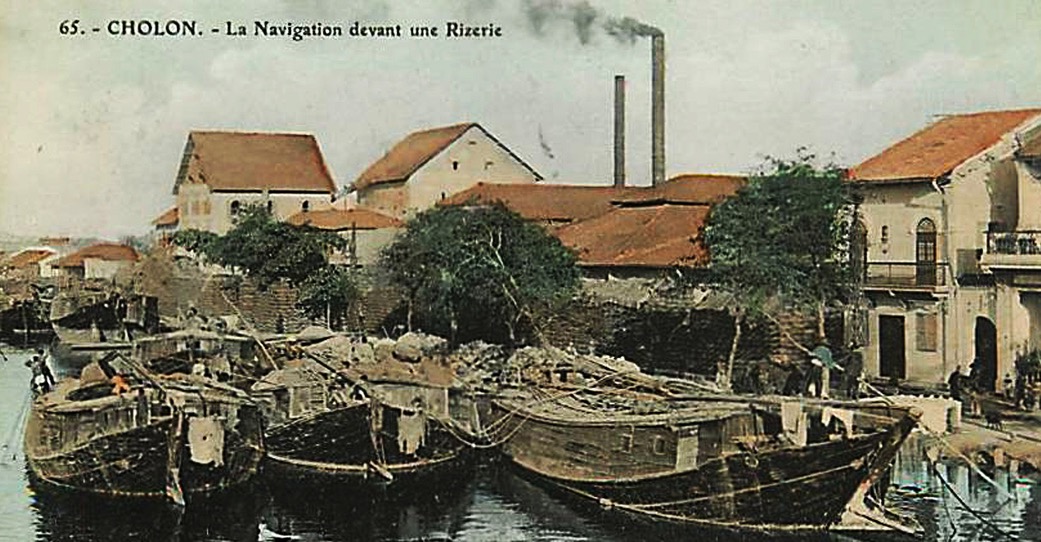
In 1925 Saigon had a population of 100,000 "Asiatiques" and 8,444 Europeans, whereas Cholon was home to 20 Europeans, 201,283 Annamites, 2 Cambodians, 25 Laotians and Tonkinois, 769 Chinese, 1,204 Ming-huong, and 9 "others". Interestingly the jail was home to 146 Europeans, 214 Annamites, 34 Chinese, 4 Cambodians, and 1 Laotian. It would be in Cholon where my wife would be born and grow as a child.
Another text about Indochina tells us that in the 1920's there were about 42,000 resident French, and about 72% were government employees, within the armed forces or the civil service. According to this report they drew civil service pay, and in some cases were provided with furnished living accommodation, and a special overseas allowance. The latter was calculated in franc but payable in piastre worth four times the official rate. As a result no other French colonial domain offered a more attractive government employment option.
A separate report mentioned that in 1935 there were 100 Americans, including children, residing in all of Indochina, most connected to an American oil company or as Christian missionaries. The same report mentioned that there were 30 British and 20 Americans resident in Saigon in the mid-1930's, and that the Saigon Golf Club near the airfield had become their favoured retreat.
My wife's mother, and her family
In 1910's, my wife's mother was not yet born, but we know her parents were a French couple living in Nam Định, a city about 90 km south-east of Hanoi. It was the second-largest city in Tonkin at that time, and the site of one of the early engagements between the French and Vietnamese. Nam Định was also the city with (probably) the highest population density in Vietnam, at 600 people per square kilometre. This is said to have been one of the reasons why Nam Định became a trading centre for rice, i.e. it was impossible to live on the rice produced in their own neighbourhood. In fact, at the time the Chinese traded rice in Nam Định, and when asked why, they replied that the port was the best for them, but they were only allowed eight or nine days to purchase rice, and that if they took longer they would be regarded as "cunning merchants" and punished. In the north the rice farms were small and numerous, so Chinese merchants did not deal directly with rice growers. Rather they bought rice wholesale in the rice markets of Nam Định or at the river terminus and then shipped it to Hải Phòng where they transferred it onto sea-going vessels.
The Chinese could not be openly hostile to the Vietnamese government, but they pushed for the French occupation of Tonkin which they thought would certainly result in greater concessions for foreign trade. Within a year, the French arrived in force and began the conquest of Tonkin (1882). Later there would be a ban on rice exports from French concessions (including Hải Phòng), but not for the Chinese merchants in Nam Định. However, the situation at the time was complex, with Chinese steam ships sailing under the English flag with English captains, and they were worried that the ban might also apply to them. The French then establish customs depots in Hải Phòng, Hanoi and Nam Định, and the first produce they would tax was rice.
In 1884 the French military administration would forced all trade to go past Hải Phòng by banning ships from using any other river route to the sea, this condemned Nam Định, which ceased to be the primary export port, despite its history as a centre for rice collection. Thus Hải Phòng was transformed from a minor trading port to the major port of Tonkin.
We don't know why my wife's maternal grandparents were in Indochina, nor why they first moved to Nam Định. However, we also have a reference to the family name of my wife's maternal family, Fis… as "cafetier" in Nam Định, which could translate as coffee maker, or eventually cafe owner.
The first introduction of coffee into Indochina was documented in 1857 when a French Catholic priest brought an Arabica tree to northern Vietnam with hopes of establishing a small-scale venture. Though successful in his endeavours, it wasn't until the early 1900's that the Robusta bean made its way to the country's central highlands, where the region's climate and soil provide optimal coffee-growing conditions. Today, Vietnam accounts for 20% of the world's total production of coffee (and 40% of the world's Robusta beans), exporting over 1.65 million metric tons each year.
My wife's maternal grandfather (Eugène Fis…) would later join the police, and her maternal grandmother was an artist-painter (who in later life would become known for her paintings of the Côte d'Azur). According to official documents my wife's maternal grandfather entered the Police Municipale de Hanoi in 1910's, and some time in the 1920's the family moved to Saigon. Eugène F… would become Secrétaire de 1er classe in the Secrétariat de Commissariat in Saigon.
Secrétaire de 1er classe has a somewhat negative connotation in todays world, however, the hierarchy of the police at that time was quite complex. Frankly, I'm not sure of all the different 'grades' nor if they were same in the Police Urbaine and Police Municipale (or even what the difference was).
However in 1918 in the Police Urbaine people would start as Agent Stagaire, then move up through Agent de 3e classe, then 2e classe, and 1re classe. Then there was Sous-brigadier de 2e classe, Sous-brigadier de 1re classe, followed by Brigadier, then Brigadier Chef 2e classe and Brigadier Chef 1re classe. Then came Secrétaire de 3e classe, then 2e classe, and 1re classe. Then there was Commissaire de 3e classe, then 2e classe, and 1re classe, followed by Commissaire principal 3e classe, then 2e classe, and 1re classe, then Commissaire de classe exceptionnelle, and finally Commissaire hors classe. And somewhere there were also Commis and Commis-interprètes des polices (police clerks and clerk-interpreters), also starting from stagiaires (interns) and going through 4e classe to 1re classe.
One report in 1918 on mentioned Agent de 6e classe, to 1re classe in the the Police Municipale.
In edition, the Police de Sureté had a top category called Commissaires spéciaux, then came Inspecteurs principaux, then Inspecteurs.
Jumping forward to 1937 we just see a single Police de l'Indochine with the Contrôleurs de la Sûreté, Commissaires, Inspecteurs, Brigadiers, and a separate Secrétariat de Police. This highlights the difficulty, initially it was Police Urbaine and later just Police, but people still appeared in lists as Police Urbaine or Police Municipale, even after both services had disappeared in the budget and Annuaire général de l'Indo-Chine.
In fact my wife's maternal grandfather was Secrétaire de 1er classe in the Secrétariat de Commissariat in Saigon, at the same time as her paternal grandfather was Commissaire de 3e classe. They actually appeared together for several years in the same Saigon police hierarchy. I suspect that the police was a tight knit community, even more so at the higher echelons, so it not surprising that my wife's parents would meet.
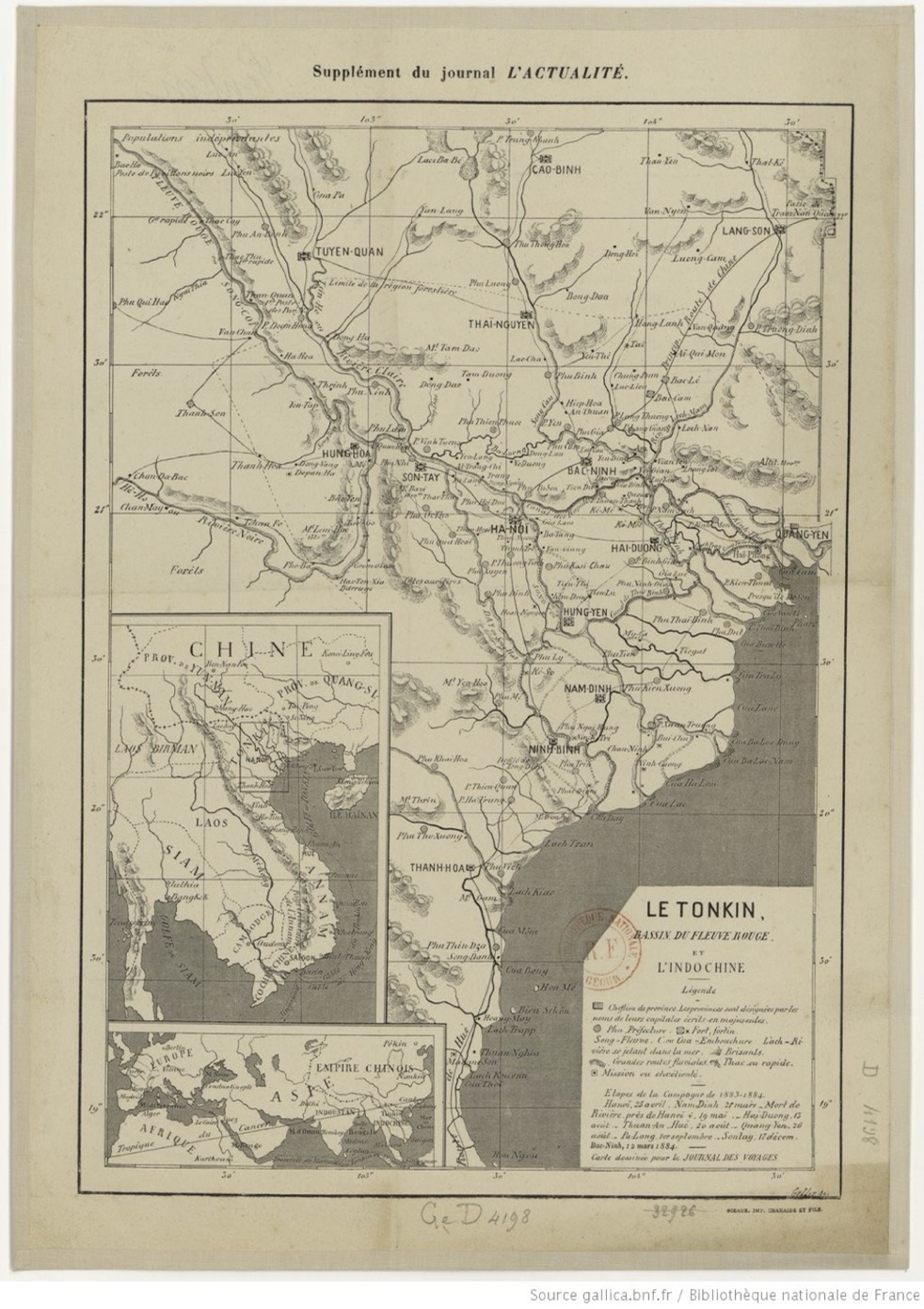
Now turning to my wife's mother, who was born to that French couple, who had now moved to Hanoi (Hà Nội is 1500 km away from Saigon). The French had taken more than eight years to make themselves masters of Cochinchina (a protectorate already had been imposed on Cambodia in 1863). But it took them 16 more years to extend their control over the rest of the country. The first attempt in 1873 failed, but in 1882 the administration in Saigon was able to impose its rule by force over the entire Red River Delta.
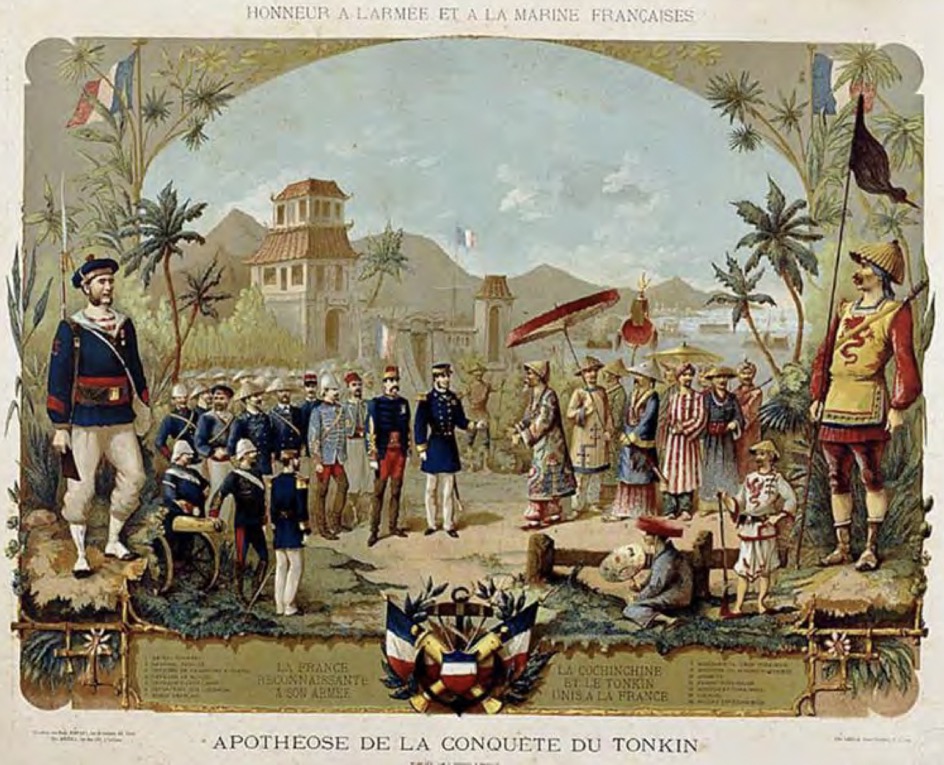
In August 1883 the Vietnamese court signed a treaty that turned northern Vietnam, Tonkin (Chữ Nôm), and central Vietnam, Annam (Chữ Nôm), into French protectorates. Hanoi, located in the protectorate of Tonkin, became the capital of French Indochina in 1887.
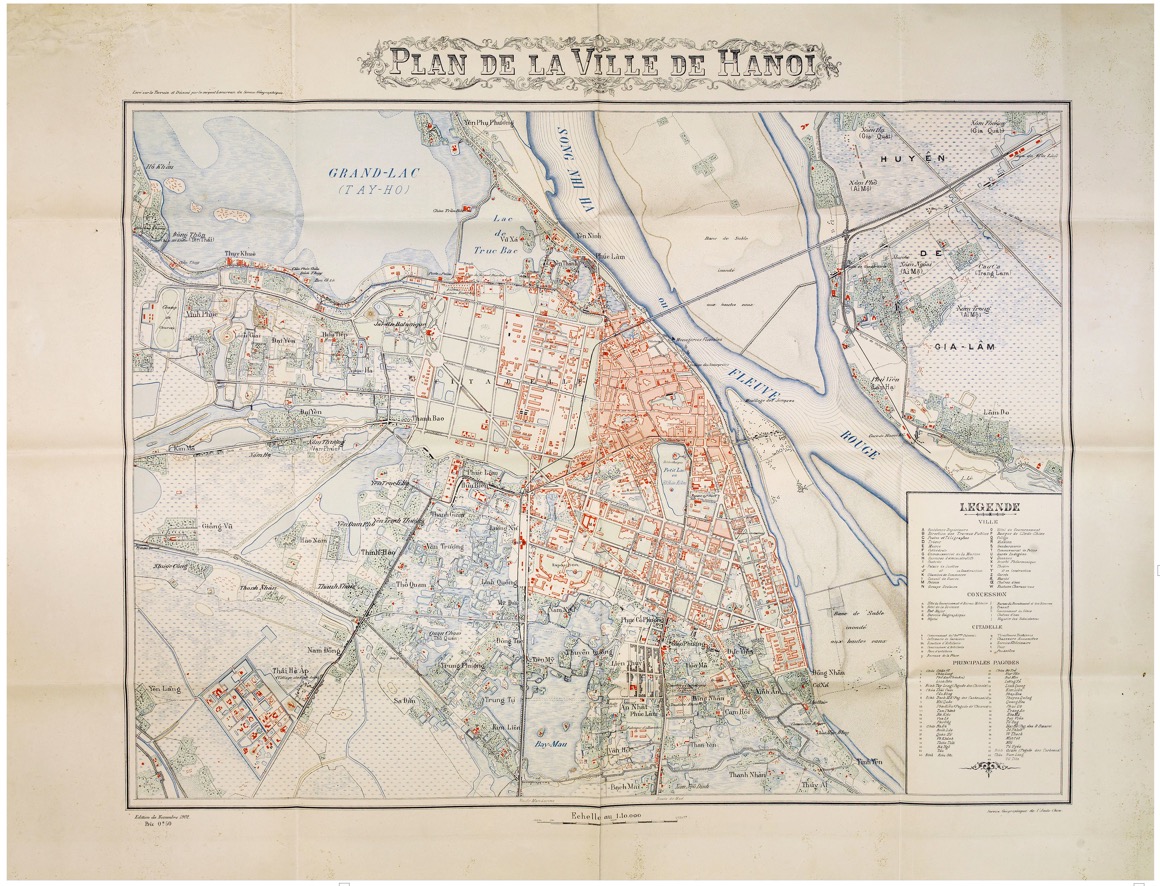
In 1910's my wife's maternal grandparents were living at 58 rue Jean Dupuis, in Hanoi (now called P. Quang Trung, Hà Nội). This must have been a relatively prestigious road since it led to one of the city gates (and was the subject of a number of different postcards).
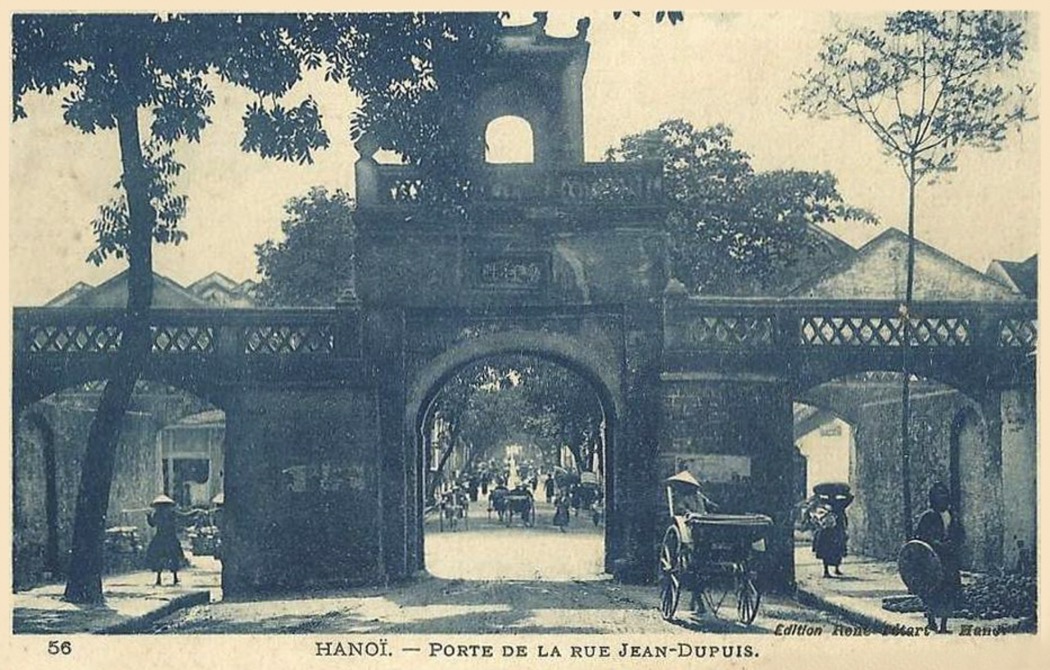
The road was named after Jean Dupuis (1828-1912), a French trader and explorer who opened up the commerce along the Red River for the French in 1872 and assisted the French in conducting warfare in Tonkin in 1873 (unusually he was still living when the road was named). The Vietnamese regimes followed the French precedent in naming streets after people. They renamed rue Jean Dupuis as Quang Trung, the imperial title of Nguyễn Huệ (1753-1792), the 2nd emperor of the Tây Sơn dynasty of Vietnam, who reigned from 1788 until 1792. The Vietnamese nowadays regard Nguyễn Huệ as a national hero who reunified Vietnam again and defeated two invading armies - I suppose this is a form of poetic justice.
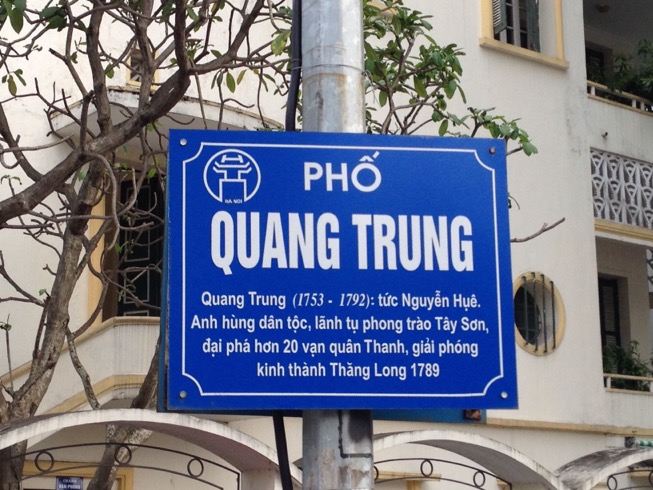
The little story of Joséphine D
Joséphine D… was my wife's maternal grandmother, so the mother of her mother. On one of the heritage websites someone has constructed the male line of the family name of Joséphine D…, which became extinct in the 1980's. Whoever completed this research added some information concerning Joséphine D… and her marriage to Eugène Fis…, but there is no guarantee that the family tree on the female line is complete, for example, the children of Joséphine D… and Eugène Fis… were not directly mentioned. However, we do know who her parents were and the names of her siblings (6 brothers and sisters). In addition, we also know a number of 'major' events in the life of Joséphine D…, namely addresses and dates from different archives and annuaires.
Below we have a water colour of the old street Hàng Bạc by Joséphine D… She would go on to make many watercolours of the villages on the Côte d'Azur, but this is the only one l've seen of her time spent in Vietnam.
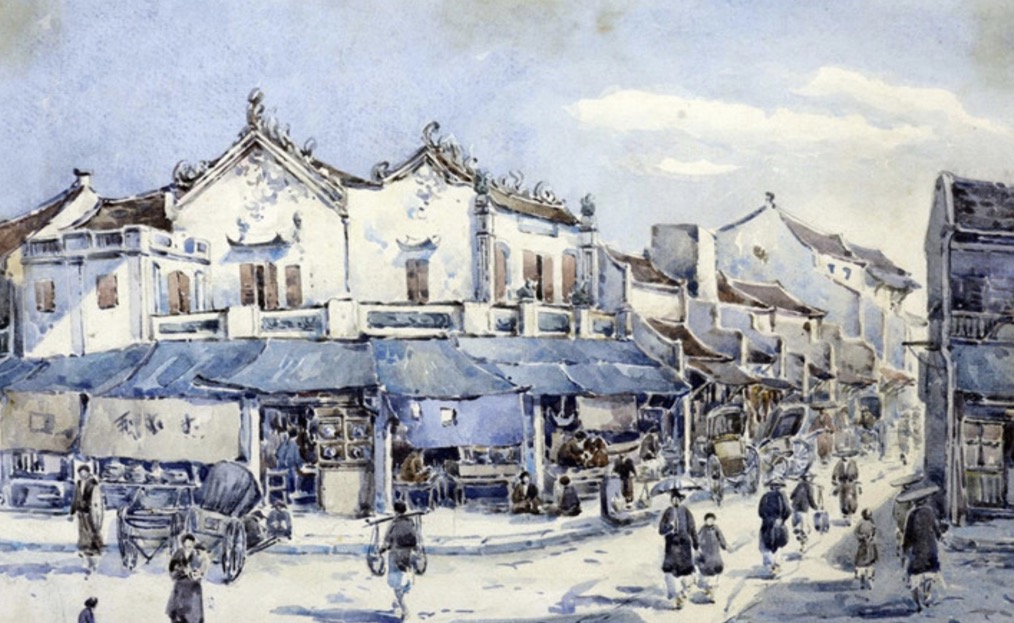
Hàng Bạc (see article) is one of 36 traditional trade streets in Hanoi that each featured a profession shown by its name, so you had Hàng Muối (salt) Street selling salt, Hàng Muối (curtain) Street selling bamboo curtains, Hàng Đường (sugar) Street selling sugar and honey products, Hàng Giấy (shoe) Street selling shoes, etc. Among them, Hàng Bạc Street seems to have been the "richest" one, for it sold silver jewellery.
As is often the case with heritage websites, there is some limited information on Eugène Fis…, but it does not include parents, siblings, etc.
However,… there are some odd bits that 'could' link together. Eugène Fis… was born in Spain, and on the same day less than 30 km away (again in Spain) was born a Marguerite M.L. Fis... Some files give the same parents, others ignore their existence in this part of the Fis… family line. We know nothing about how both arrived in Hanoi, but we know she married in Vietnam, and then died at the age of 23 shortly after giving a still-birth. Later her husband would marry again, and Eugène Fis… would be the witness. Too many coincidences, but no certitudes. If (a big if), they were twins born to a certain A.E. Fis... and a G.M.M. Oll…, then it would allow our Eugène Fis… to trace his family tree back to 1525.
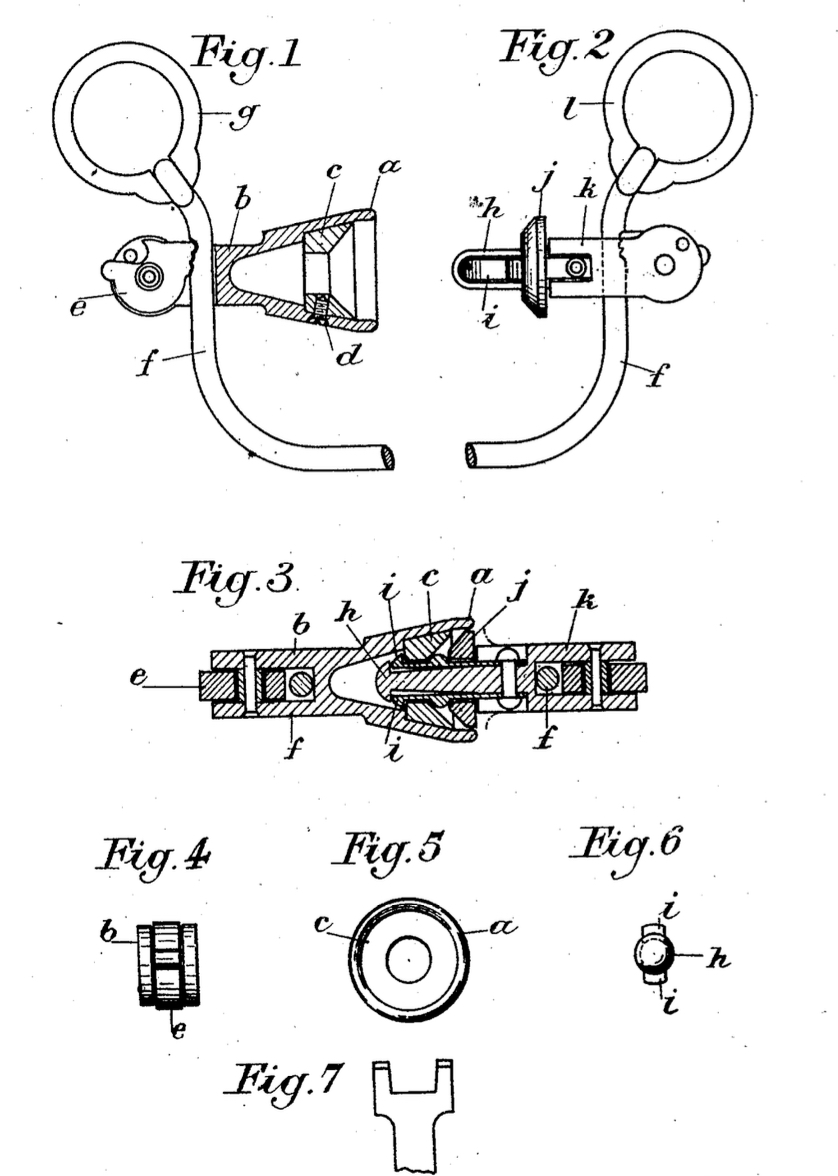
However, one of the most unusual, if not totally bizarre, discoveries, relates to “Eugène Fis…, French citizen, resident of Hanoi, Tonkin, Indo-China”, and it concerns the according of a US patent for a “confining and restraining device”, an improved type of manacle, i.e. handcuffs.
My wife's parents meet in Saigon
We now zoom forward to 1930's and the marriage of my wife's parents. As I mentioned above we now find both families living in Saigon, and both my wife's grandfathers appeared together in the Saigon police hierarchy.
In the early 1930's we know my wife's paternal grandparents lived at 1 Quai Le Myre de Vilers, presumable named after Charles Le Myre de Vilers (1833-1918), the first civilian governor of Cochinchina (1879-1882). Even in its primitive state (ca. 1865) the wharf was a favourite promenade, but later, with its four rows of mature tamarind trees, it was often called "one of the most beautiful promenades in the world". In the early days it was written "The spectacle, with the great warships, the animation produced by the boats of the country, in a hurried row, along the bank, or circulating on the river, the freshness provided by the vicinity of the water, indiscriminately attract walkers, especially on days when the governor's band is playing, and one can notice elegant carriages, already very common in Saigon. The observer will perhaps find this walk even more pleasant on a fine evening, when the long line of the quay and that of the streets leading to it will be traced by lanterns which light up all the houses. At that time, in fact, the city has no other light, in the evening, than the little candle which must necessarily indicate the entrance to each dwelling".
This is a map of Saigon dated 1926, and we can see Quai Le Myre de Vilers in B-3.
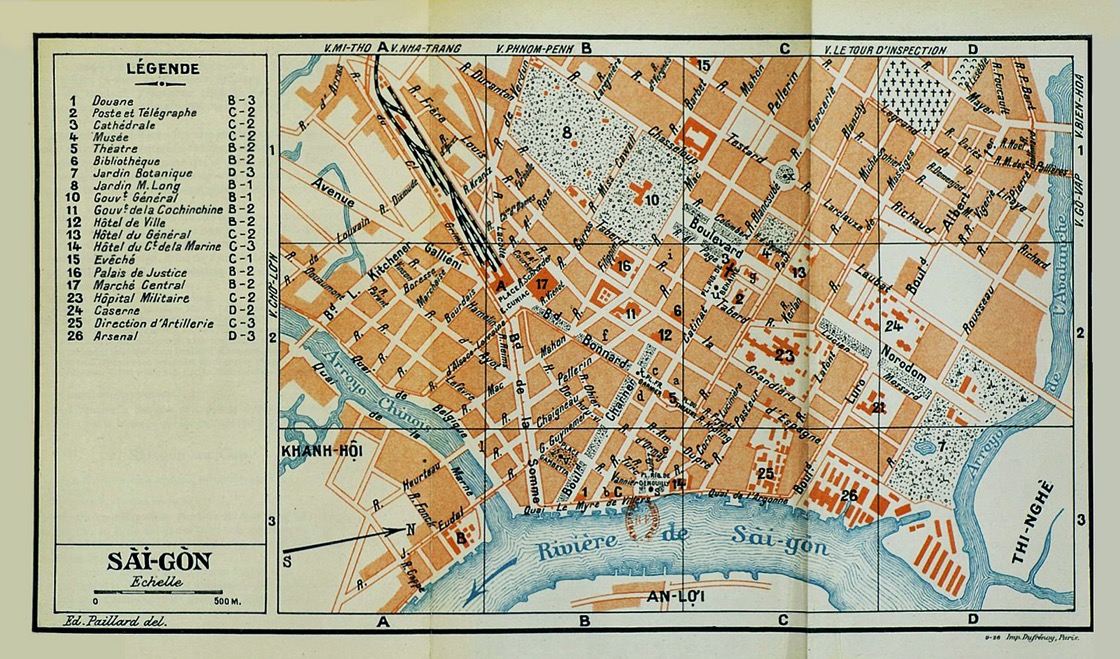
There are few sites that are tagged but not identified, namely B is the offices of the Messageries Maritimes (see below for more details) and C is probably the offices of the Messageries Fluviales. According to a map of 1920 on the corner of Quai Le Myre de Vilers and Bd. de la Somme was the offices of the Direction du Port de Commerce, and just at the entry to Bd. Charner was the Douanes et Régies. According to the same map, the first building on corner between Quai Le Myre de Vilers and Place Rigault de Genouilly was a Commissariat de Police.
By 1920 the Douanes et Régies in Saigon was responsible for the whole of French Indochina. For those interested, check out "La flottille des Douanes et Régies de l'Indochine Française" by Serge Rinkel.
I guess Bd. Charner was named after Admiral Léonard Charner who participated in the Siege of Saigon, and I presume under the command of Admiral Charles Rigault de Genouilly (1807-1873).
Below I found these modern day equivalents in Vietnamese to the légende in the above map.
1. Nhà đoan (quan thuế) - B3
2. Bưu điện và điện tín - C2
3. Nhà Thờ Lớn - C2
4. Viện Bảo Tàng - C2
5. Nhà hát - B2
6. Thư viện - B2
7. Vườn Bách Thảo - D3
8. Công viên Maurice Long (Vườn Tao Đàn) - B1
10. Dinh Toàn quyền - B1
11. Dinh Thống đốc Nam Kỳ - B2
12. Tòa Thị chính - B2
13. Dinh Đại tướng (chỉ huy quân đội) - C2
14. Dinh Thủy sư chỉ huy Hải quân - C3
15. Tòa Giám mục - C1
16. Tòa án (pháp đình) - B2
17. Chợ Trung tâm - B2
23. Bệnh viện nhà binh - C2
24. Trại lính - D2
25. Sở Chỉ huy Pháo binh - C3
26. Xưởng công binh (Ba Son) - D3
In the below detail we can see more clearly the exact extent of Quai Le Myre de Vilers, and we can see that the quai (wharf) was clearly an essential part of the port of Saigon.
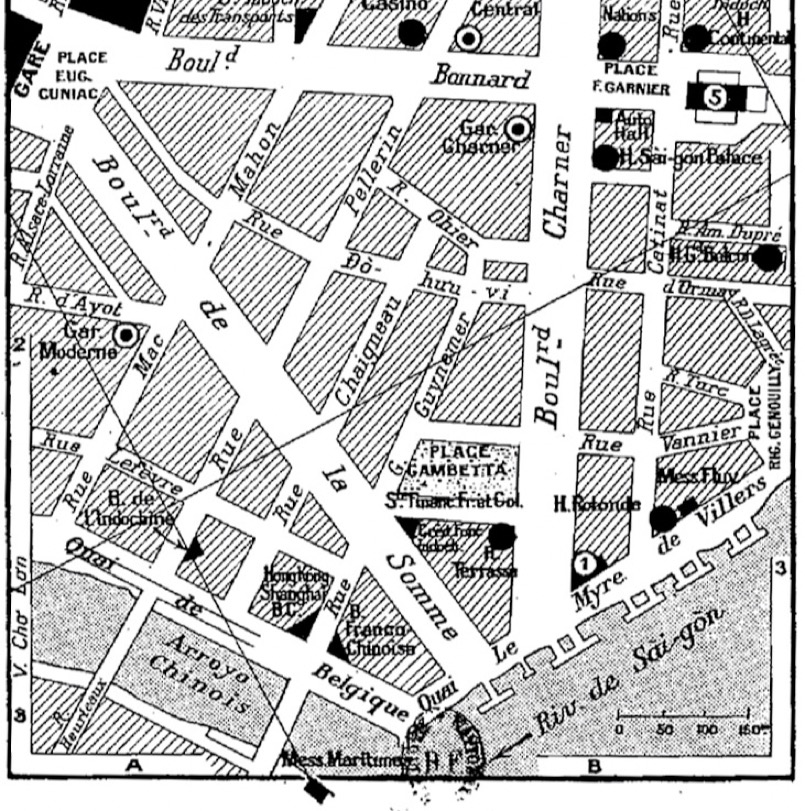
Historic Việt Nam has an interesting webpage dedicated to the port of Saigon, from which I have taken this very liberal extract.
The French opened the port of Saigon to navigation and commerce on 22 February 1860. In February 1861, the Compagnie des Messageries Impériales (known after 1871 as the Compagnies des Messageries Maritimes) was entrusted with postal and passenger services from Marseille to Saigon. Part of the existing mercantile port in Khánh Hội (now District 4) and the Messageries Maritimes wharf or Dragon Wharf (Bến Nhà Rồng) became its headquarters.
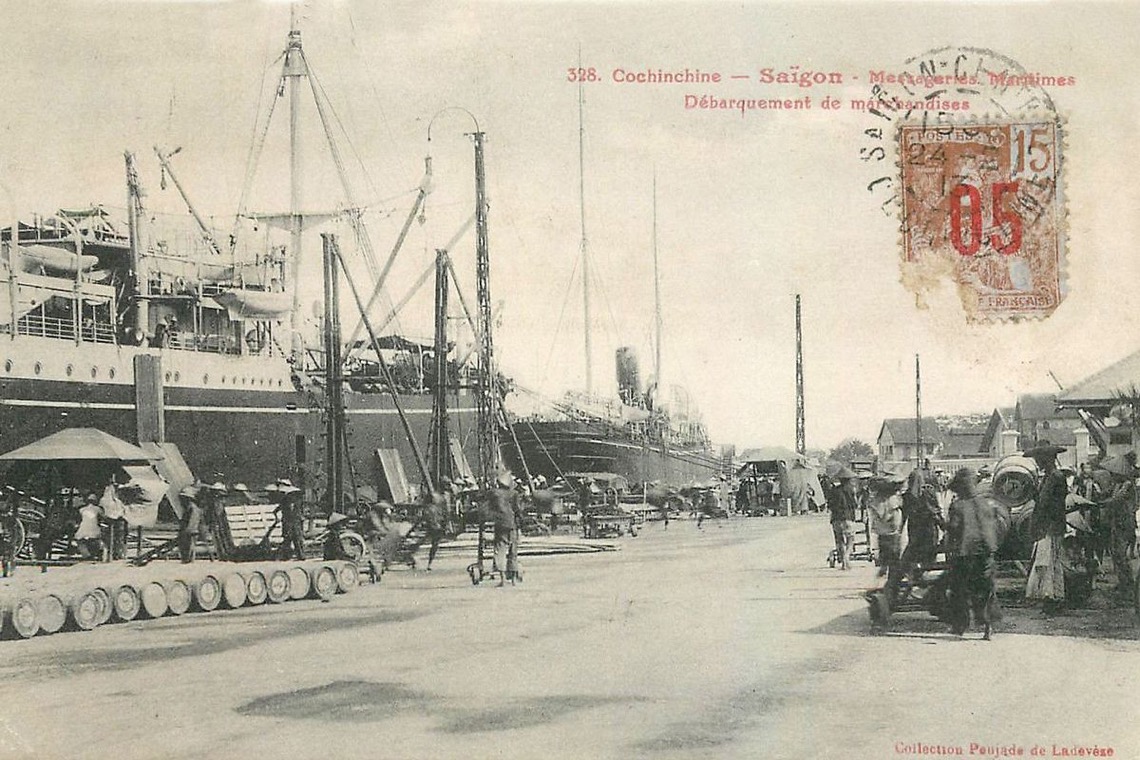
Thereafter, the company’s courier vessels conveyed mail and passengers from Marseilles via Ceylon (Sri Lanka) to Saigon and then onward to Hong Kong, Shanghai and Yokohama, with connecting services from Saigon to Manila.
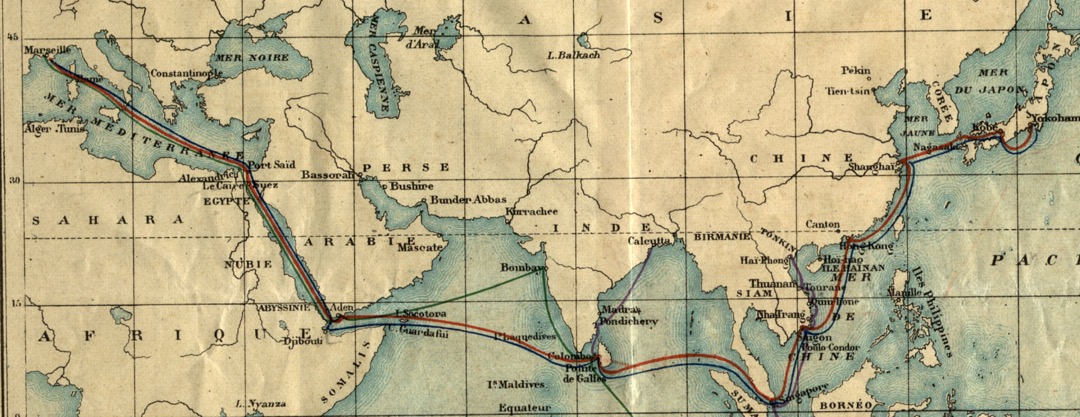
These courier vessels were operated initially on a monthly basis, but their frequency increased to once per week following the opening of the Suez canal in 1869. The Compagnie des Messageries Maritimes enjoyed a monopoly until 1901, when the Compagnie de Navigation des Chargeurs Réunis was permitted to launch rival services and share the Messageries Maritimes terminal. Below we have the same wharf dated to between 1920 and 1929.
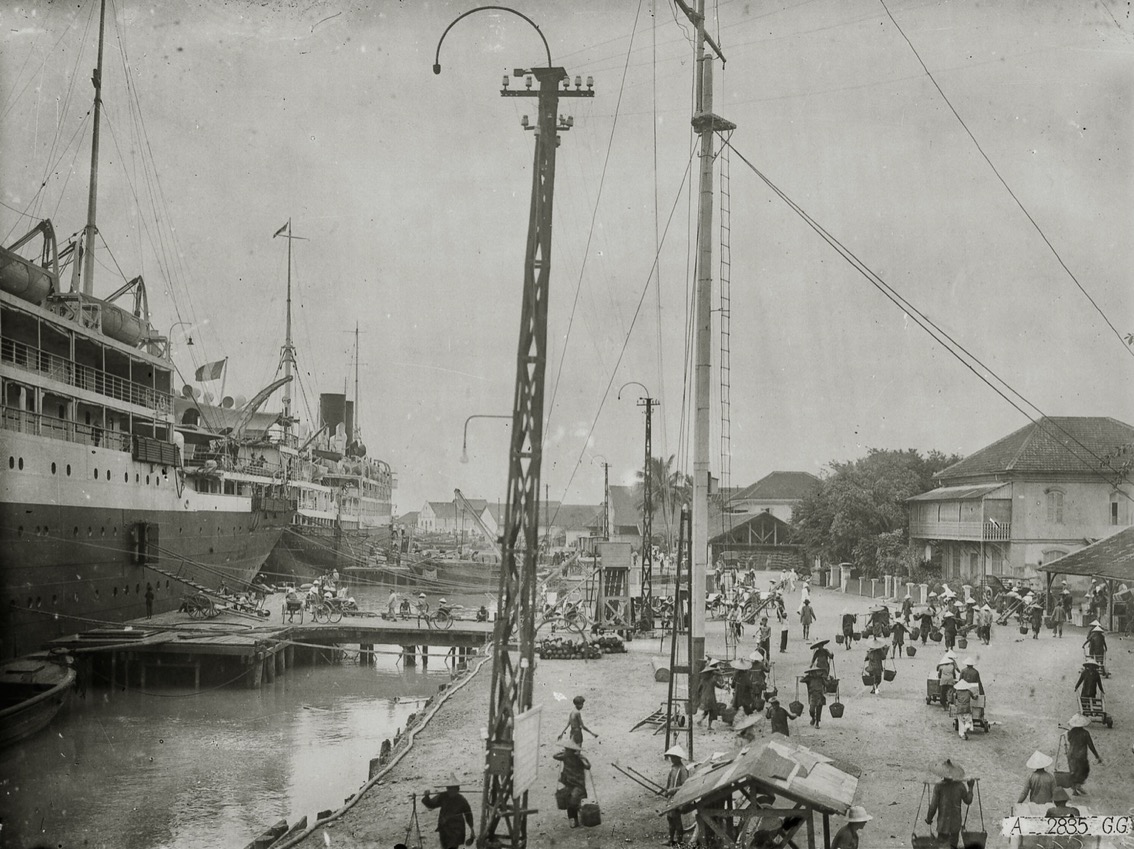
We can see the difference with the wharf of the Messageries Fluviales below. As an example in 1900 there was one connection with Bangkok every second week. It followed the arrival of the Messageries Maritimes and the trip would take four days.
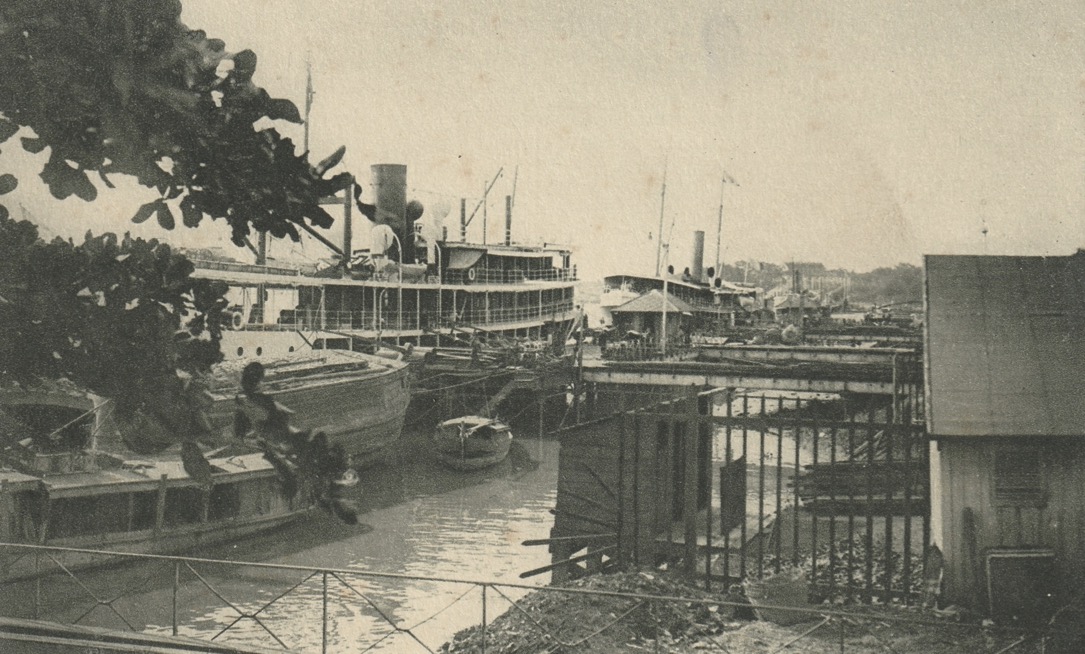
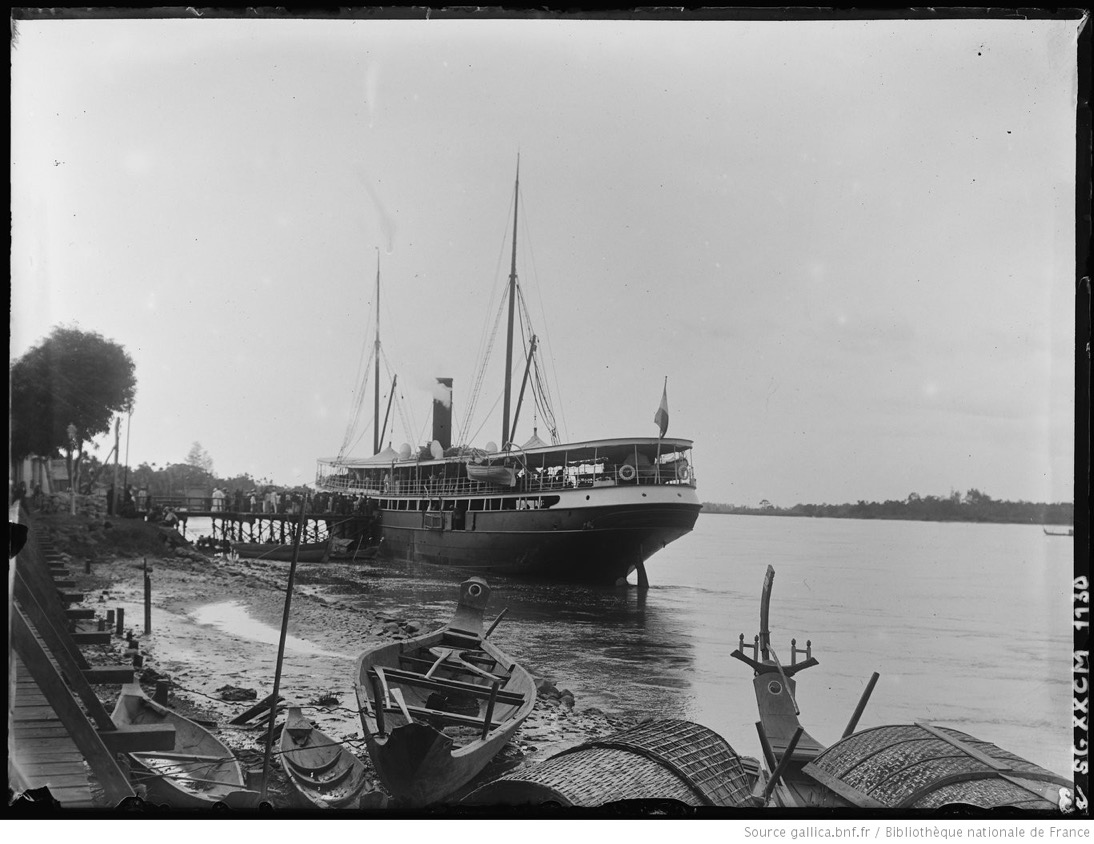
Have a look at "Saigon’s Colonial-Era Shipping Line Brought the World to Vietnam". There is also a website that follows the history of Messageries Maritimes and there is separate website French Lines that collects information on all French maritime companies, etc.
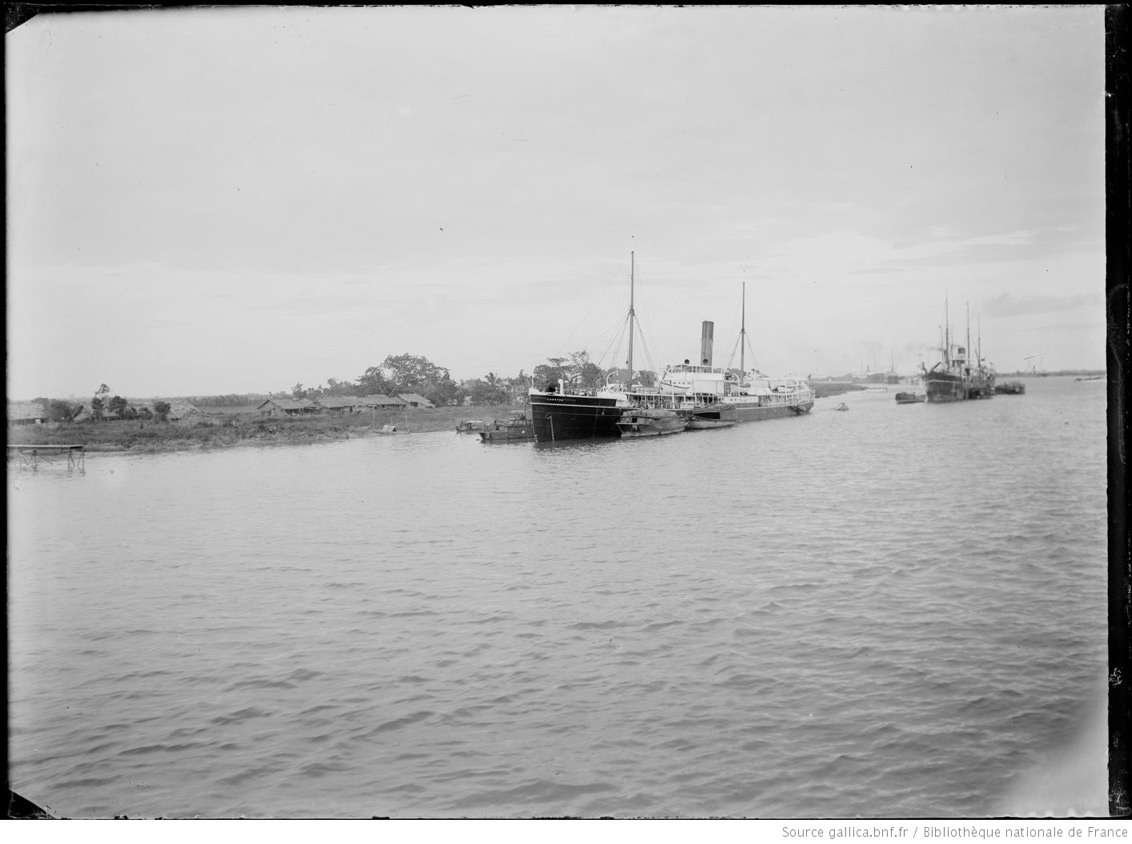
According to a summary from 1906 a trip to Indochina was not to be taken lightly. Official warnings were made concerning a climate très rigoureux (very fatiguing), different mœurs (traditions and manners), different languages, different legislation, different living conditions, and more generally the acceptance that there was a constant battle to retain the colony in a world that was becoming more challenging. For civil servants and their families, the travel was paid by the colony in question. In addition the advice was to not take a lot of baggage and 'objects of limited utility', just a toilet bag (trousse de toilette), lingerie, and light clothing. The rail trip from Paris to Marseille took 13 hours (rapid) and 17 hours (express). In 1907 the price of a single ticket from Marseille to Saigon was 500 francs 3rd class, 1,000 francs 2nd class, and 1,475 francs 1st class (return trip was 750, 1,500, and 2,213 respectively). In terms of 2015 prices the 3rd class cost around €2,000, 2nd class around €4,000 and 1st class around €6,000, so also very substantial sums at the time. Oddly, the continuation through to Yokohama only cost 50 francs more irrespective of class. The 1st class cabin occupied by just one person was 50% more expensive. The ticket included food and vin de table, but passengers had to pay for "vins fins et liqueurs, biére et des boissons refraîchissantes" (fine wines and liqueurs, beer and soft drinks). Each class had its defined area on the boat, and only 1st class passengers were allowed to "dépasser les limites" (to exceed the limits). Even then you were not allowed to smoke in the salons, cabins, etc, but only on the outside decks and only if other travellers didn't complain.
Servants (domestiques) were allowed in the salons and cabins "pour le service de leurs maîtres" (for the service of their masters). A one-way ticket Marseille-Saigon for a servant was 500 francs 3rd class, 1,000 francs 2nd class, and 1,175 francs 1st class if they were European, but for "indigènes" (native servants) only the 4th and 5th classes was available (at 500 and 400 francs respectively, food included). Servants travelling 1st class ate with the 2nd class, and for 1st class passengers going on to Yokohama, native servants travelled free. You could also take your bicycle, car, horse, monkey, dog or parrot with you, for a price.
The "conditions of passage" would make even the most risk adverse merchant blush today. They didn't accept any responsibility for damage done by storm, shipwreck, grounding, boarding, force majeure, change of course or vessel, quarantines, strikes, ice, fire, pillage, piracy and generally any events at sea (tempéte, naufage, échouement, abordage, relàches forcées, changement de route ou de navire, quarantaines, gréves, jel, feu, pillage, piraterie et généralement de tout événements de mer). And the company was not liable for barratry, any faults or negligence of its captains, nor for those of the pilots, sailors or other persons on board its ships, in any capacity whatsoever (elle ne répond pas de la baraterie, des fautes ou négligences quelconques de ses capitaines, ni de celles des pilotes, marins ou autres personnes embarquées à bord de ses navires, à quelque titre que ce soit).
My wife's parents were both born in Indochina. Her paternal great-grandfather Léon Car… brought his son René Car… to Cochinchina, and we know almost nothing about Léon Car… or his wife or even if René Car… had any brothers or sisters. We do know that Léon Car… was certainly not a civil servant, and that his son René Car… would only join the local police at the age of 29. However, we know that our two policemen, René Car… and Eugène Fis…, benefited from pensions entitled "P.Mles", as opposed to a French state pension usually identified with C.I.R. and an account number. These were very rare because I saw only a handful of these pensions mentioned in the Annuaire général de l'Indo-Chine for the years 1900-1937. My guess is that given that both were recruited locally, it may refer to a pension from the Police Municipale (as opposed to my wife's father who was recruited locally but benefited from a French state pension).
On my wife's maternal side, we only know for certain that her grandparents were married in Marseille, then moved to Hanoi, and only later did her maternal grandfather join the police (also at the age of 29). So we can presume that neither families came to Indochina as civil servants, i.e. they were immigrants. The warnings were even more clearly put for immigrants. They had to be in 'perfect' physical form, and were warned that Indochina was far from offering a "typical colonial life". It was clearly stated that all too often people did not realise how difficult it would be to make the transition. In 1906 it was suggested that a family would need a minimum monthly income of between 300 and 350 francs (probably in excess of €1500 today). Families would have had to look at the offers available, and would have had to provide some guarantees to l'Office Colonial. The immigrant would have to provide for everyone in the family a "acte de nuisance, livret militaire, casier judiciaire, un certificat de bonne vie et mœurs, un certificat médical d'aptitudes physiques" (birth certificate, military service record, criminal record, a certificate of good conduct and morals, and a medical certificate of physical fitness). In addition they would need to demonstrate the necessary funds for an initial installation, or a letter of employment. And the prospective employer would have to cover the costs should the person (or persons) need to return to France for whatever reason. A very sensible reminder was to get absolutely everything in order, because once in Indochina communicating with the France would take more than 2 months. In addition the trip was Marseille-Saigon, those going on to Annam, Tonkin, or Laos would have to continue on one of the local ferries, or for nearer locations there were trains, etc.
The trip started at 04:00 in the morning in Marseille (or eventially Toulon), and passed Elba, the islands of Lipari, the Strait of Messina, Crete, to Port Said, in four or five days. The stay in Port Said lasted about 3 hours, enough time to take on 100 tons/hour of coal. It was said that the port offered the fastest coal service in the world. Then the Suez Canal, 150 km long, 60 metres wide, 18 metres deep, and 5 miles/hour. Then it was the Red Sea, which they said was really, really blue. Then Djibouti, a stop at Aden, the Indian Ocean, Bombay and on to Colombo. Then it was the Bay of Bengal, Strait of Malacca, and Singapore for more coal. Then in a few days it was Indochina, across the Gulf of Siam. Naturally depending upon the exact itinerary, there were numerous possibilities to stop for tourism, but the above was the basic trip schedule. The ship would then usually continue to Hong-Kong, Shanghai, Kobé, and finally Yokohama. From Saigon there were connections to Tonkin and Singapore, and from Colombo to Calcutta.
To enter Saigon, ships would have to navigate the Saigon River System, near the mouth of the Mekong. Both were, and I guess still are, subject to shallows banks offshore that might be uncovered at low water but covered during spring tides. In the Mekong Delta fixed lights and beacons were in place, and wrecks were usually indicated by buoys. The Saigon River delta was wide but there were numerous small islands separated by rivers or channels leading to sea. At the time it was thought that the Saigon had no known source (today we know it rises near Phum Daung in southeastern Cambodia), but it's still true that the river as seen in Saigon is probably replenished by the inundations from the Mekong. The advice was for vessels to remain at least 5 miles away at night, and wait for a guiding vessel during the day. There was a lighthouse and a signal and semaphore station so that vessels could communicate by International Code, and thence by telegraph to Saigon. During later times, an added difficultly was the presence of submarines, signalled by a special flag.
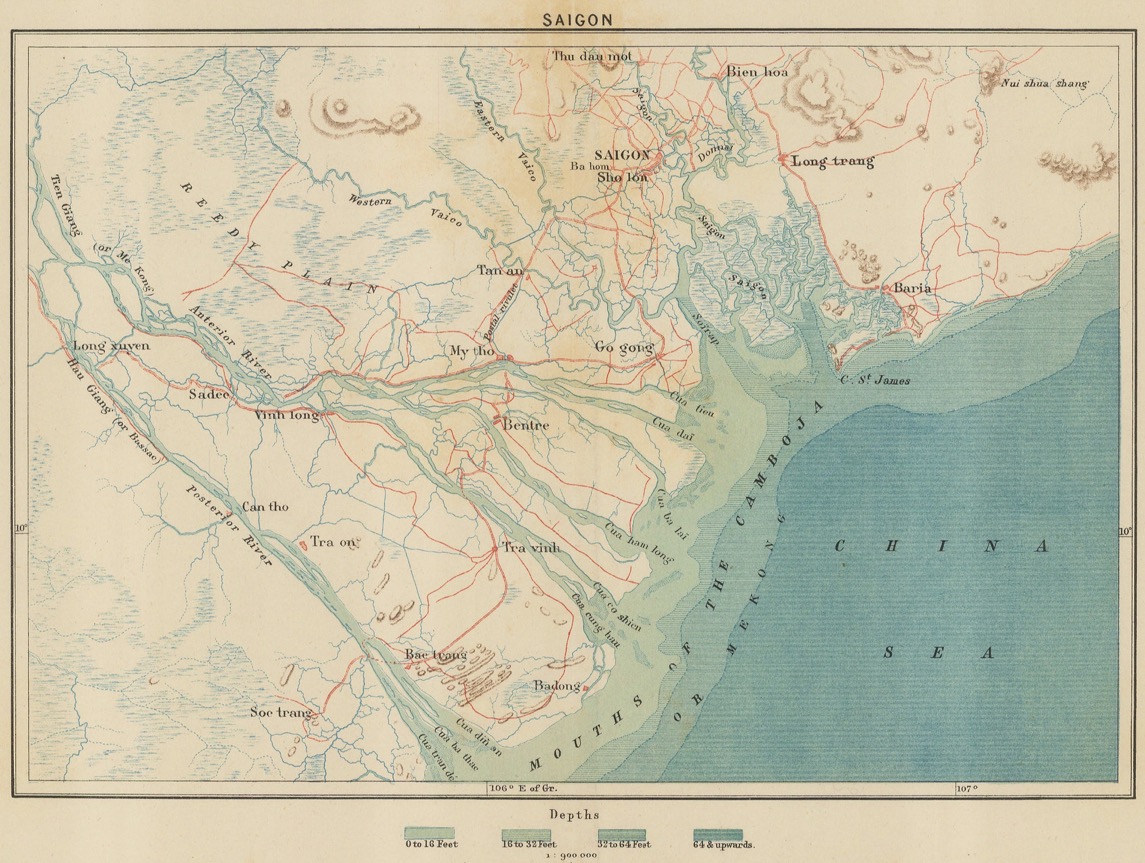
There was a pilot station connected by both semaphore and telephone, and they had a steam pilot-boat. Pilots were compulsory for merchant vessels, even when anchoring out to sea. About 20 miles below Saigon there was a channel dragged to a depth of 9.5 meters, and it was known that the steamers of the Messageries Maritimes could go up to Saigon city. The principle danger were sand banks, often just covered in water, and there were a series of fixed lights and beacons to help navigate.
The idea was that ships going to berths in Saigon were to attract the attention of the signalman in the signal station, using the steam whistle or siren. At the same time the ships were to fly a national flag, and distinguishing signals, e.g. mail steamer, company flag, quarantine flag as specified by the sanitary police, and for commercial vessels their number in the International Code. The signalman would telephone the harbour with the information, and would hoist on the signal mast any messages, e.g. to wait and anchor, to discharge first petroleum or explosives, etc., to get underway quickly, etc. In addition in Saigon there were tidal streams of between 2 and 4 knots, depending upon high water, etc., but tugs were available. The river itself was seen as being tortuous for long vessels, but "navigable with proper care". By 1907 the commercial port was one side of the time signal (described later), and cargoes were handled rapidly. The other side of the time signal was reserved from naval vessels. All vessels were under the direction of the harbour master, and no vessels were permitted to anchor in the river. There was a signal station and a customhouse at the harbour.
The cost of a pilot depended upon the use of a tug, for a sailing ship it was 0.35 francs/ton or 0.28 francs/ton if a tug was used (ton was the so-called jauge nette or the registered tonnage of the ship). The ship would also have to pay a "droits de phare et d'ancrage" (lighthouse and anchorage rights and a berth at the wharf). In 1890 it was 0.30 francs/ton, or 0.15 francs/ton if they arrived or left empty. Sailing ships were only taxed once every four months, and passenger ships were exempt. In 1907 its was 0.15 piastre/ton for each arrival and departure (unless they were empty). In 1890 there were particular strong fines imposed on any ship trying to carry rice without paying the tax, or by understating the weight of the cargo. Fines could be between 300 francs and 3,000 francs, plus the confiscation of the cargo.
In 1907 the cost of a river crossing in a sampan with two rowers was 0.08 piastre during the day, and 0.10 piastre at night. Or you could book them by the hour for 0.10 piastre/hour and 0.15 piastre/hour at night. The day cost 1.00 piastre and trip Saigon-Cholon 0.40 piastre. To situate these prices, at the time the piastre was probably worth around €10 in 2015 prices, so 0.10 piastre would have been the equivalent of €1 today.
All sorts of fresh food could be obtained in Saigon, and good water was supplied by tank boats from the reservoirs on the hill westward of Saigon. Coal was brought alongside in lighters, and about 200 tons could be loaded in a day. Repairs could be made at the government docks, and they also had floating steam lifting cranes. The military hospital has 200 beds, and seamen of all nations could be treated.
Saigon was not a free port, i.e. no favourable custom regulations to particular parties.
In 1900 taking a pousse-pousse ordinaires from the port inside the city would cost 0.05 piastre, or 0.10 piastre return trip with 30 minutes stop-over, and 0.10 piastre for every extra 30 minutes. If you wanted to go outside the city, you had to negotiate (hard). Then there were the so-called pousse-pousse japonaises 1re catégorie which cost 0.10 piastre, or 0.15 piastre return trip with 15 minutes stop-over, and 0.25 piastre for the next hour, and 0.20 piastre for every extra hour. A trip in a posse-pousse 1er classe from Saigon to Cholon would cost 0.40 piastre. To situate these prices, at the time the piastre was probably worth around €10 in 2015 prices, so 0.10 piastre would have been the equivalent of €1 today.
The rickshaw (pousse-pousse) was imported into Vietnam from Japan in 1883 (some reports say via India), and rapidly came to be the most popular form of transportation in Hanoi and Saigon from the1910's through the mid-1930's. As these cities developed and grew rapidly, and as French Indochina was integrated into the world economy, rickshaws met an increasing demand for accessible, convenient, and efficient modes of transportation. The rickshaw trade provides an example of European colonisers adopting an "Asian" form of transportation, a hybrid between a sedan chair and Western-style wheels, put into motion using cheap Asian labour. Public rickshaws or rickshaw cabs (pousse-pousse de louage) first gained prominence with European customers. Through much of the colonial period, Europeans and many Vietnamese viewed the "first category" rickshaw as a convenient, comfortable, "elegant", even "luxury" form of transportation. The "second category" rickshaw was accessible to the mass public, and while in the 1900's the first-category rickshaws were reserved de facto for Europeans, by the 1910's the number of Vietnamese customers considerably increased. The emergence of a Vietnamese middle class ensured customers for public rickshaws even as the number of European customers declined, as they increasingly preferred instead to use private rickshaws, automobiles, and the tramway. For more information on rickshaws, checkout this article.
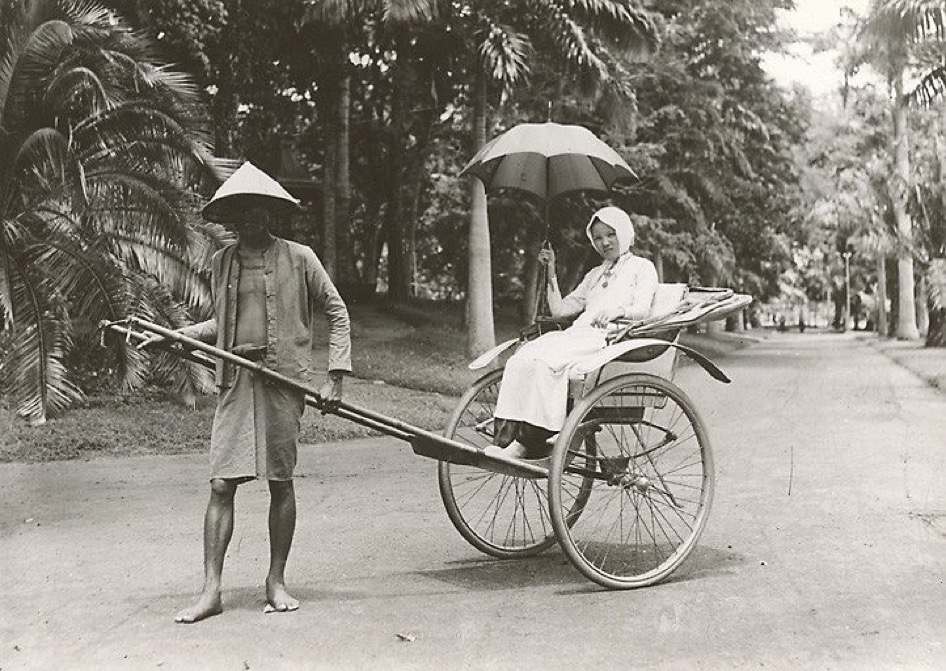
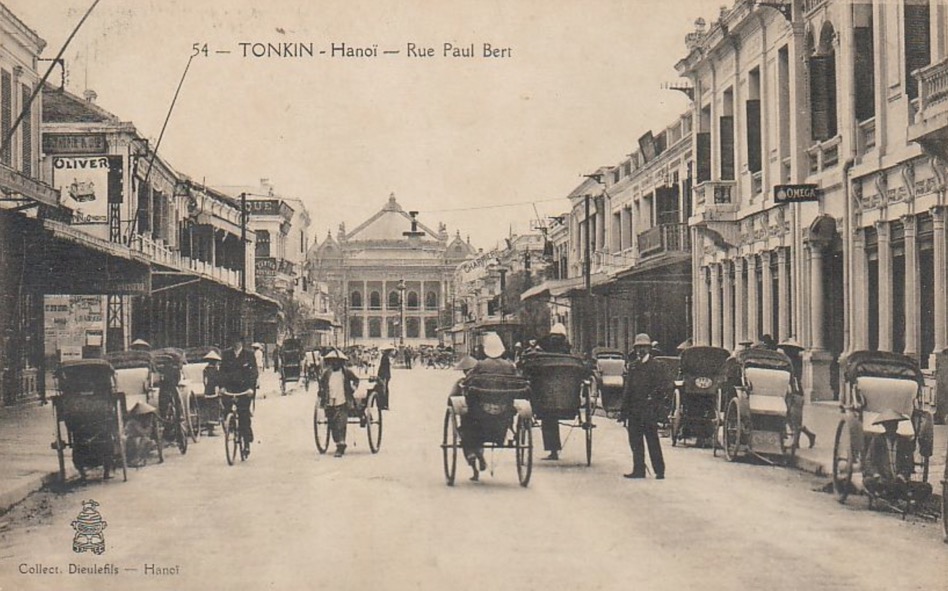
As far as I can tell, the 1st class pousse-pousse was covered against the rain, had metallic wheels with rubber to absorb the shock, and had a more comfortable interior.
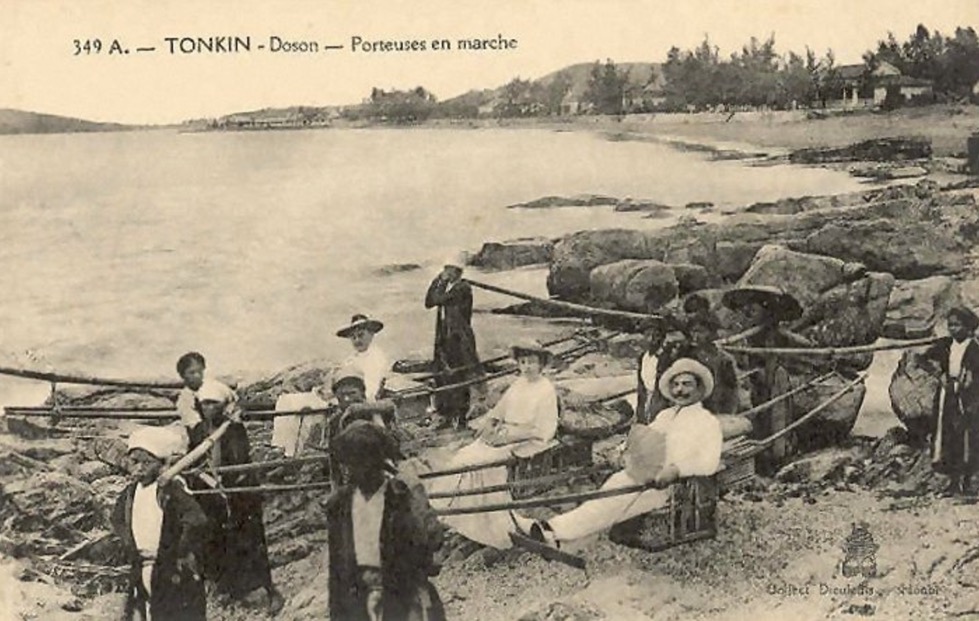
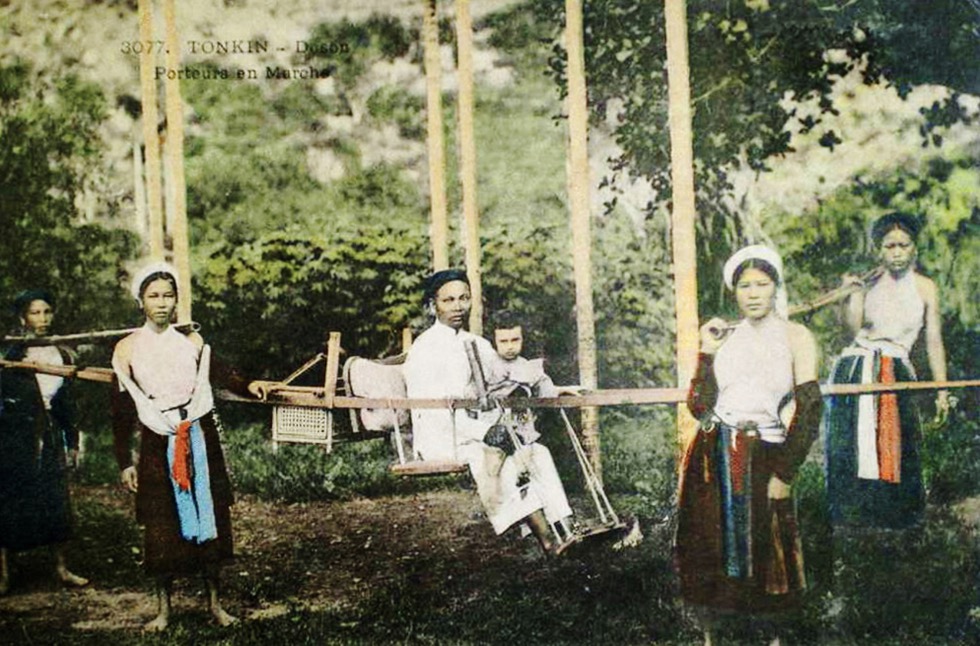
Then there were "les porteuses de Do Son" who were women porters who carried European tourists and rich Vietnamese around in bamboo sedans. I don't know the origin of this mode of transport, but it was a common way to transport goods, and there was a suggestion that it might have been the earliest way for women to carry water.
Saigon was known to be dominated by dry and wet seasons, "not disagreeable" in the dry season, and "very distressing to the body" in the hot, humid season. The statistical reality was that the average daily temperature over the year was 28°C, rarely exceeding 34°C in the shade, but equally rarely going below 19°C at night except for a few times in December or January. However, the air was almost always humid during both the dry and wet seasons. Opinions varied, one US Consul called Saigon, "this marsh-set city of enervating heat and vitiated air", whereas the next US Consul wrote "it would be difficult to find a consulate of medium grade where a tropical tour of duty could be put in more agreeably". Later still the rule was introduced that US staff should be "the best of condition physically" or "almost certain that they will become casualties". In addition to renewing passports, the US consulate appeared to be interested in the 1930's in monitoring Indochina's government opium factory and the 44 licensed opium dens. This was not rocket science, since they were listed in Saigons business directory. These were the days when parking for the US consulate rickshaw was still a problem, and finding anywhere free of mosquitoes was a don du ciel. With the advent of WW II, things would change forever, the US consulate was bombed in 1941, and again in 1950, when two employees were also gunned down.
Historic Việt Nam has translated into English "Un an de séjour en Cochinchine: guide du voyageur" written by Arthur Delteil in 1882, and published in 1887. It's in three parts, Part 1, Part 2, Part 3. Here is a description (in French) of a trip Saigon-Marseille in 1909. They left Saigon on the 6 February and disembarked 12 March in Marseille, for a trip of 34 days. Another description (in French) is off a trip Marseille-Saigon in 1923. They left the 3 November and arrived in Saigon the 26 November, a trip of 23 days. This description (in French) is for a troop transport Marseille-Saigon, leaving 28 March 1947 and arrived the 20 April, for a trip of 23 days. And finally this description (in French) is for another troop transport leaving Marseille on 17 January 1951 and arriving in Saigon 10 February 1951, for a trip of 24 days.
One of the best and most detailed descriptions is "De Marseille a Canton - Guide du Voyageur" by Cl. Madrolle, 1902.
Bến Nhà Rồng (Nha Rong Wharf) is one of several Ho Chi Minh Museums in Vietnam, and in Saigon it is now a cluster of architectural monuments marking an event in the life of Nguyễn Tất Thành (later known as Ho Chi Minh). It is written that on 5 June 1911 he boarded the ship "Admiral Latouche Tréville to work as a cook in order to be able to go to Europe, thus opening his revolutionary journey". Since 1975, the cluster of architectural monuments has been rebuilt by the State of Vietnam into a memorial area for Ho Chi Minh, and June 5 is chosen as the day he left to "find a way to save the country". I'm surprised that many Vietnamese websites show the ship Latouche-Tréville as a merchant ship, whereas, according to Wikipedia, the Latouche-Tréville was firstly a wooden-hulled steam sloop aviso that was decommissioned in 1870, and later an armoured cruiser that was active in the Mediterranean (1894-1919).
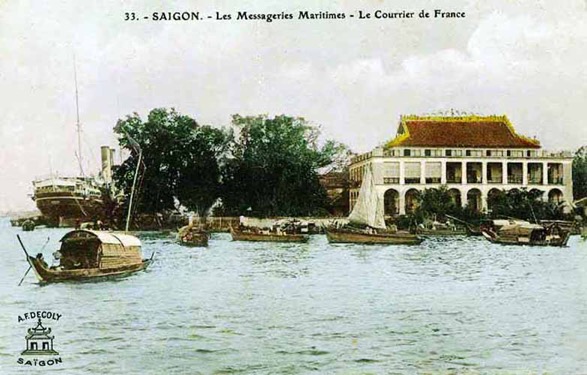
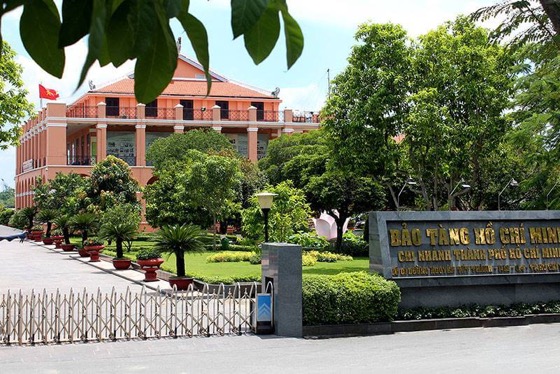
Above we can see the original Messageries Maritimes building, and as it is today as a museum dedicated to Ho Chi Minh.
During the early years of colonial rule, the Mercantile port (Port de commerce) continued to use wharves in the area of the Arroyo Chinois (Bến Nghé creek) and extending as far as the Rond-Point (later known as Place Rigault de Genouilly, and today known as Công Trường Mê Linh). In subsequent years, this quayside area was known variously as Quai de Donnaï, Quai Napoléon, Quai du Commerce, Quai Francis-Garnier and latterly Quai Le Myre de Vilers. However, in 1881 these wharves, known to the French as the "appontements de Canton" and "appontements de Charner", were transferred to the control of the river couriers (see below), so replacement facilities for the mercantile port had to be found in Khánh Hội (modern District 4). By the mid 1880s, these new mercantile port facilities extended nearly 1 km southeast along the riverbank beyond the Messageries Maritimes compound. The article in Historic Việt Nam goes on to described the expansion of the Port de Commerce that took place from 1900 to 1929.
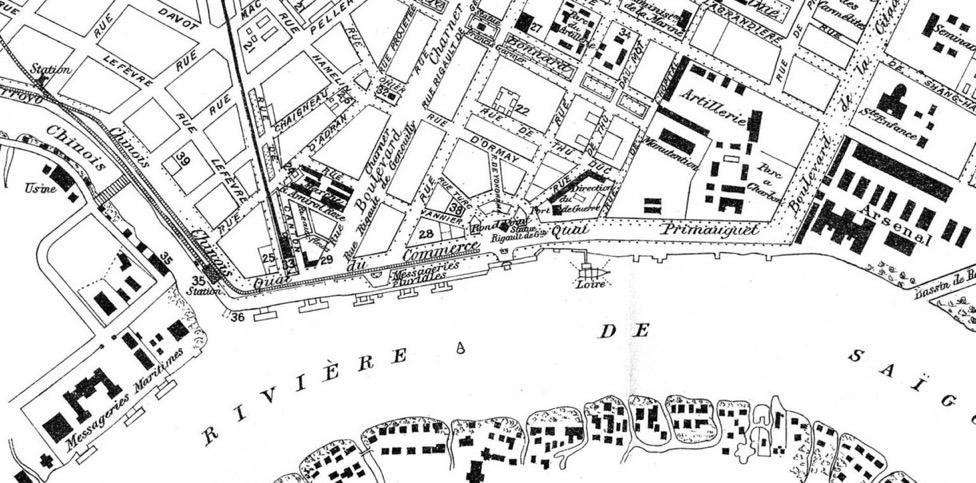
In the more detailed map above, dated from 1896, we can see the Signal Mast (N°36), the Direction du Port de Commerce (N°25), the Douane (N°29), and the Poste de Police (N°28). My wife's paternal grandfather would later have that Poste de Police as his address.
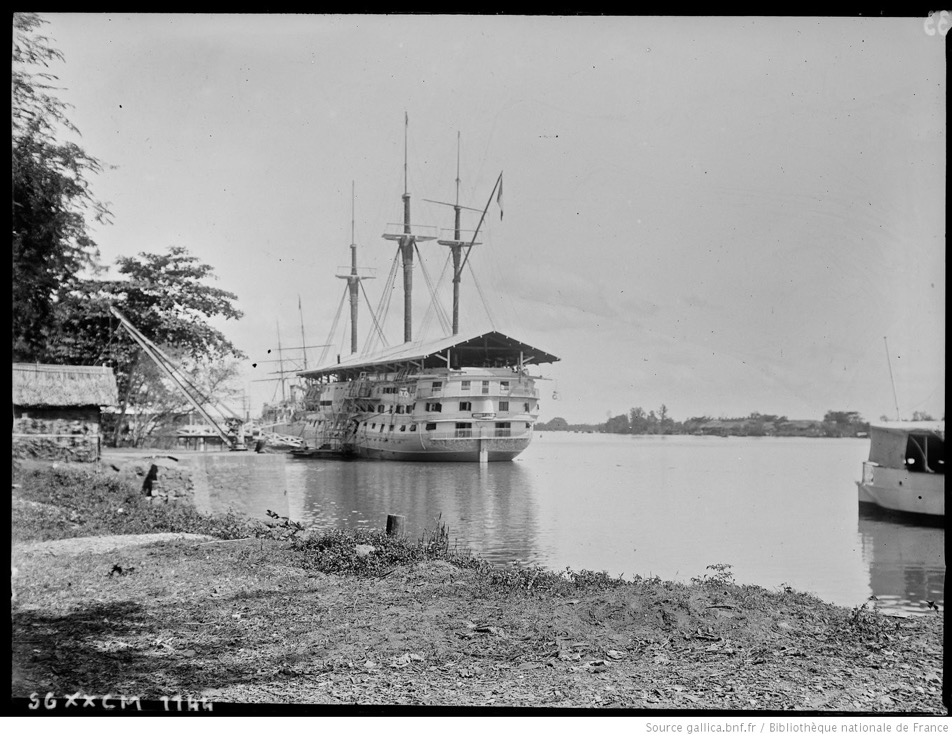
We can also see that the railway had its own station on the wharf (N°33), and the one of the two custom hangers (N°35) was connected directly to the tramway from Cholon. The Loire moored on Quai Primauguet, was the hulk of the French steam-powered ship Prince Jérôme (see above, dated 1895).
In 1881, as noted above, all of the wharves between the Arroyo Chinois and the Rond-Point (including the former royal wharf) were transformed into the River Port (port fluvial) and entrusted to the management of the Compagnies des Messageries Fluviales, which subsequently ran postal and passenger services to Phnom Penh and later to other destinations in French Indochina, as well as along the coast to Bangkok.
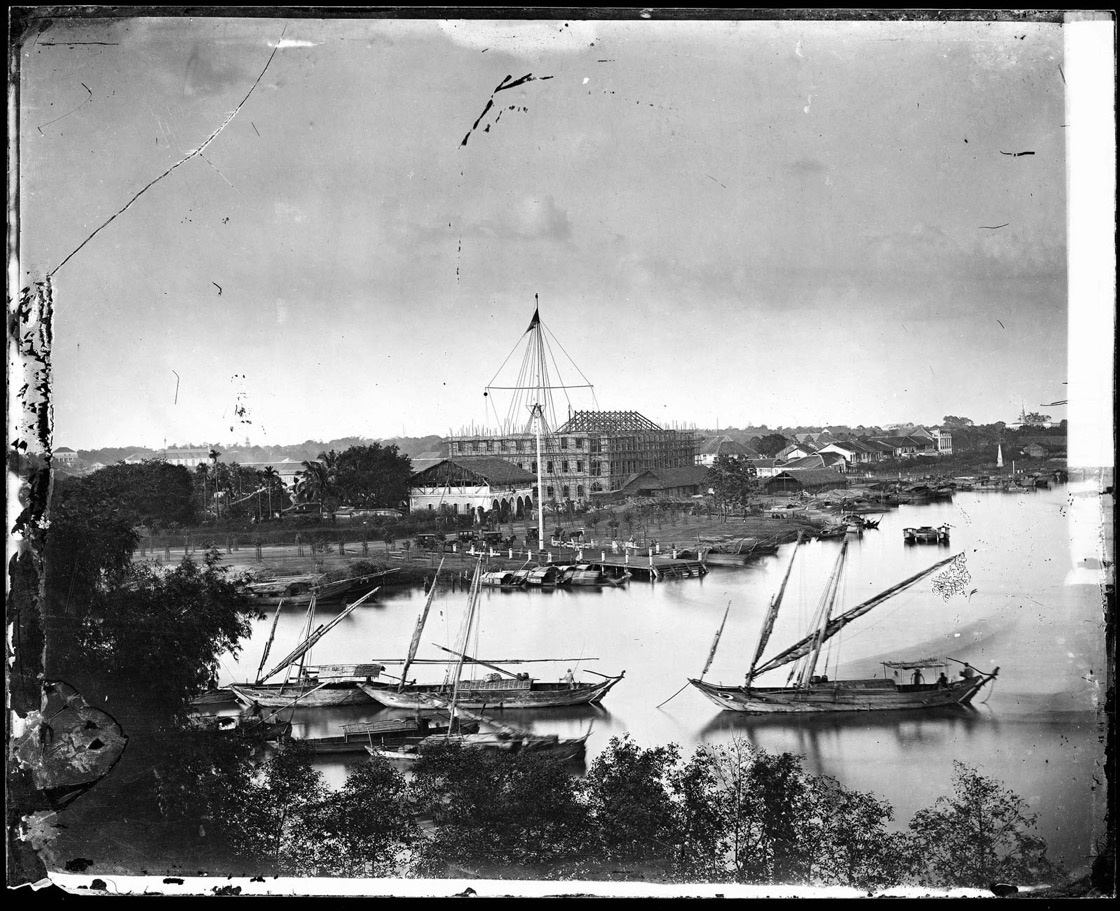
This is a photograph dated 1867, and we can see the Signal Mast, and what I presume was the Direction du Port de Commerce, and the Douane still under construction. Below we have a photograph of houses and shops on the port side, dated 1909. They look like the buildings seen in the distance on the photograph dated 1867, and I'm surprised such banal buildings remained intact for nearly 40 years in an area that was going through a substantial and constant mutation.
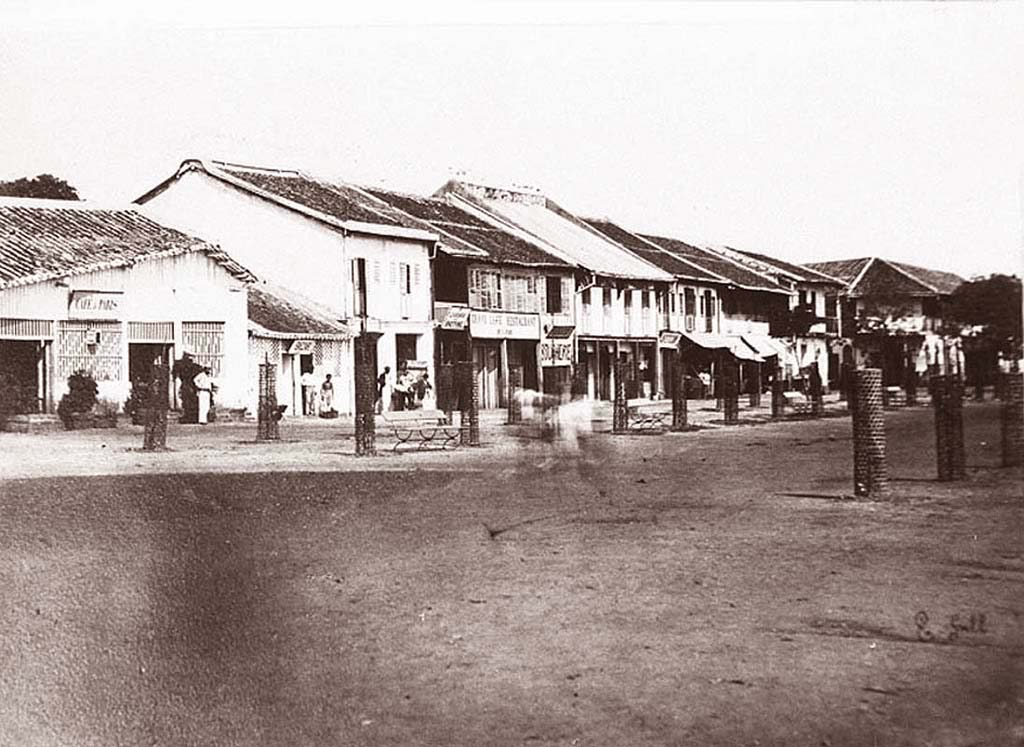
From the early 1860s, the Messageries maritime wharf, Mercantile port and River port all came under the control of a French Commercial Port Directorate (Direction du Port de Commerce). In 1879-1880, a new impressive looking colonial headquarters was constructed for this department on the headland near the Signal Mast.
After the arrival of the French, the quayside immediately to the north of the River port, between the Rond-Point (known after 1878 as the Place Rigault de Genouilly) and the Arroyo de l’Avalanche (Thị Nghè creek, which is situated beyond the Arsenal), became the Naval port (Port de la Marine), under the control of the French Navy (Marine Nationale Française).
The southernmost section of this naval port, extending nearly 600 metres along the river from the Rond-Pont and known initially as Quai Primauguet and later as Quai de l’Argonne, housed the Naval Commander’s headquarters (Hôtel du Commandant de la Marine), the Naval Artillery (Artillerie de Marine) and the Naval Barracks (Caserne de la Marine, later Caserne Francis-Garnier). Beyond that, in the 22-hectare compound previously occupied by the former royal naval workshop, the French established their Naval Arsenal and Shipyard. Founded in 1864, it was gradually equipped with state-of-the-art repair workshops, and by 1888 it boasted several boat repair docks, including a 168 metre long dry dock (12 metres longer than the dry dock in Toulon). After the reorganisation of the French navy in 1902, the Naval Arsenal became the headquarters for 38 vessels, 183 officers and 3,630 troops. Thanks to further upgrades in the early 20th century, by 1918 the Naval Arsenal could not only maintain and repair the French fleet, but also build new vessels of up to 3,500 tonnes.
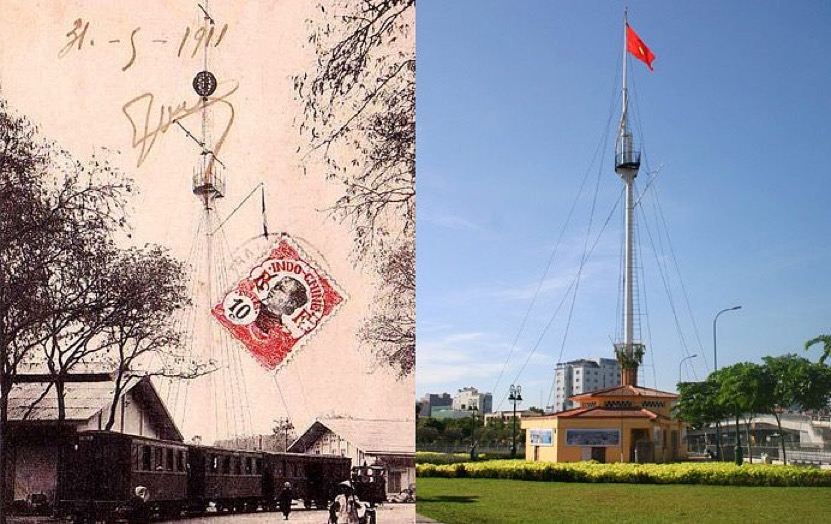
The Signal Mast has been mentioned several times, and even today a replica is still in place in modern Ho Chi Minh City, but what is a Signal Mast? There is a very interesting article from Saigoneer about the role played by the Signal Mast in Saigon society of the time, given that it was first installed in 1865.
Firstly a Signal Mast is just that, it carries signals destined for ships entering and leaving the port. The Saigon Signal Mast received daily storm information from an observatory at Haiphong. Signals were composed using a series of different shapes, e.g. square, triangle, etc., and the messages were hung on the yardarms of the signal mast. They were able to indicate both the position and direction of gales, typhoon and depressions. Also a single shape on the top indicated when the warning had been issued, e.g. a diamond meant yesterday afternoon.
In addition a time ball was installed in 1908, and in 1915 it is documented that the ball was dropped twice daily, first at noon Saigon mean time (16h 53m 11.7s Greenwich Mean Time), and then six minutes 48.3 seconds later at 17:00 Greenwich Mean Time. In 1917 these times were changed to 15:00 exactly and 15h 05m 00s Greenwich Mean Time, i.e. 10:00 and 10:05 standard civil time (in Saigon). In 1925 a radio signal was also available from a radio station in Saigon (call sign HZA). The time ball was used to verify the setting of marine chronometers, today a Global Navigation Satellite System is used.

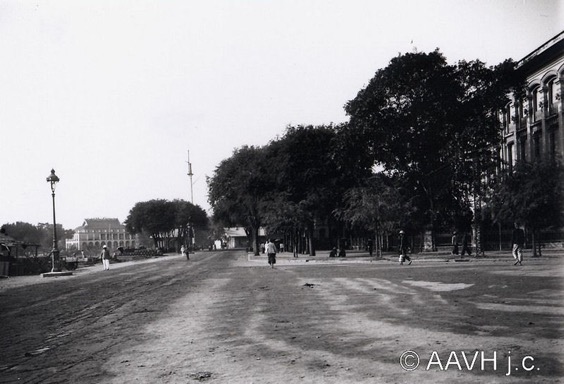
But what did Quai Le Myre de Vilers actually look like? Above we can see what it looked like in 1904…, and below what it looked like in 1930.
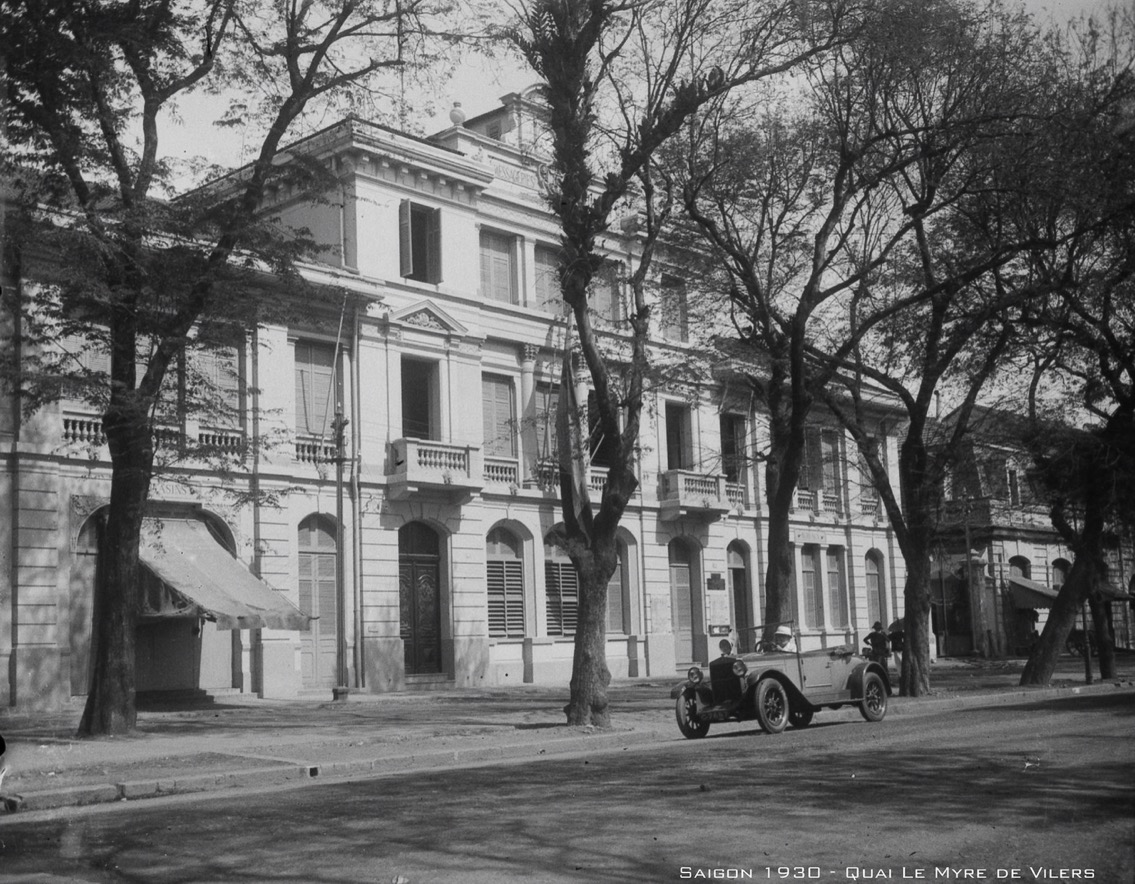
So my wife's paternal grandfather was a commissaire de police and in 1930's the family gave their address as 1 Quai Le Myre de Vilers. And 1 Quai Le Myre de Vilers was the Commissariat de Police of the 1er arrondissement Saigon (as seen below).
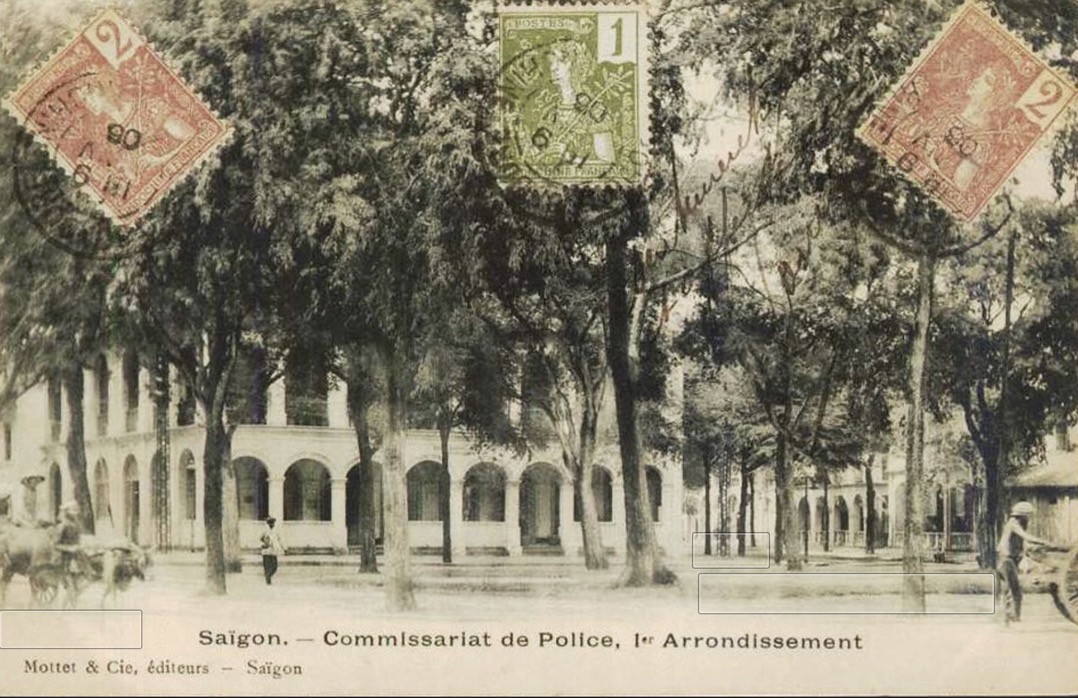
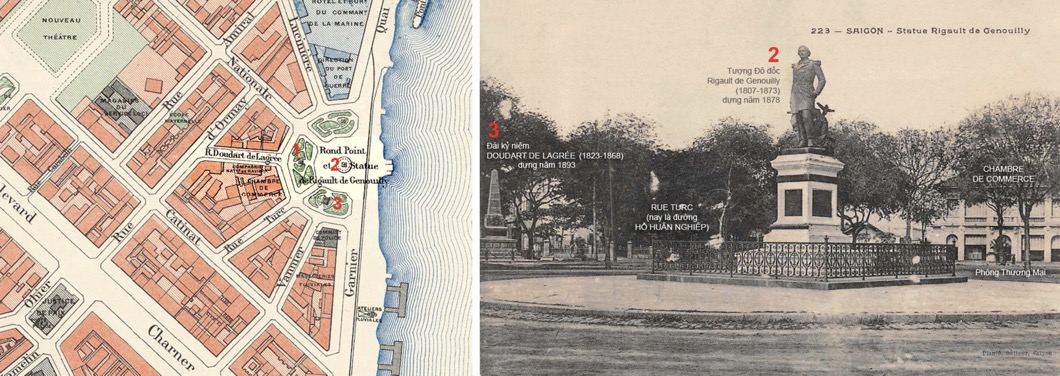
But lets end this section by returning for a moment to the Rond-Point, or as it became known, Place Rigault de Genouilly, after 1878 (today Công Trường Mê Linh). Below we can see the same place in 1969, and then in 2020, as they say "time waits for no man…".


Now back to Marguerite, the mother of my wife, who was living with her parents in 1930's, at 34 rue Gustave Vinson, Saigon. It would appear that Gustave Vinson had been a lawyer (avocat-défenseur) and mayor of Saigon 1874-1876. My guess is that he was not well appreciated, because his son had to write to ask that a street be named after his father, deceased some 28 years earlier.
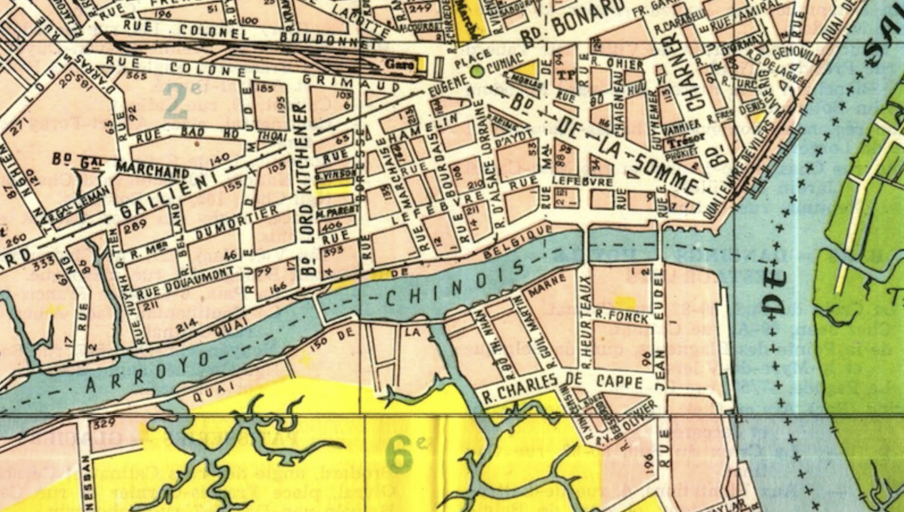
The exact address is difficult to see, but it's a short road linking Bd. Lord Kitchener with rue Boresse, and as far as I can tell was the location of the Commissariat de police of the 2eme arrondissement Saigon. Which is not surprising, since my wife's maternal grandfather was a Secrétaire de 1er classe in the Secrétariat de Commissariat and gave his address as the commissariat.
As was the case with my wife's fathers family, I presume her mothers family were living at the Commissariat de police of the 2eme arrondissement Saigon.
Opium in Vietnam
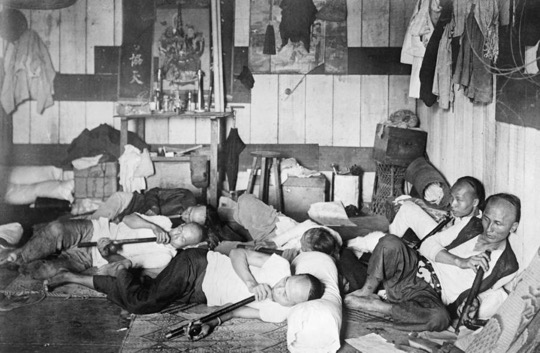
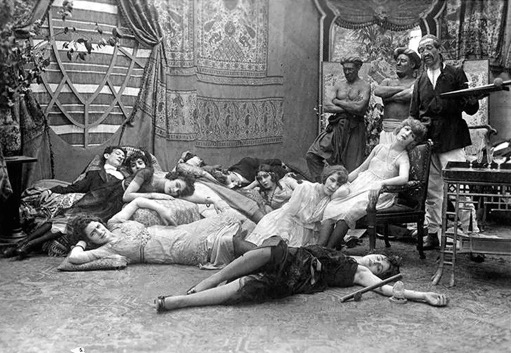
Opium in Vietnam is a worthwhile topic in itself for two reasons. Firstly, it was, along with alcohol and salt monopolies, one of "trois bêtes de somme" (beasts of burden), i.e. the basis of a stable taxation systems essential to maintaining the fiscal health of the local French colonial regime. Secondly, between 1990 and 2001 Vietnam managed to reduce opium production by 98%, and is still one of only a handful of states that successfully did so.
Experts see the opium trade in Asia as being linked to population flows. Beginning in the 19th century, China provided the first large-scale "free wage labour" for parts of southeast Asia. Migrant workers moved en masse into Malaya, Sumatra, southern Siam, Tonkin and Borneo, and were quickly recruited into tin or gold mines, or on plantations. The migration of Haw, Hmong and other tribes from China into other parts of Asia favoured the spread of opium cultivation and consumption. It's generally agreed that contact with Chinese immigrants was the cause of the indigenous population acquiring the opium-smoking habit. The expansion of drug markets was an inevitably economic, and thereby developmental, phenomenon. The expansion of drug supply and drug markets globally was an innate process of globalisation. The early caravan tracks became trade routes serving both legal and illegal commodities, including drugs. But globalisation merely accelerated and magnified the use of drugs such as opium. And it did not help that technological changes significantly increased the gross tonnage of supplies and trade. The central question at the end of the 19th century was less about restricting the distribution and sale of opium, and more about who would benefit from creating and implementing those regulations.
The reality is that the Sino-Indian opium trade began in the mid-16th century, and was soon taken over by Portuguese, British and Dutch traders. A fragmentary and ultimately localised trade soon became subsumed under the monopoly of the British East India Trading Company. Where China increasingly sought to restrict and prohibit the domestic consumption of opium, European empires looked at it as a way to correct major trading imbalances. As opium became associated with Western consumption practices, namely the mixing with tobacco to form smokable opium known as 'madak', so too did the sense of foreign incursion and threat (the opium pipe shown below is from our collection). These early concerns became amplified when it became apparent that the Chinese state was haemorrhaging silver to buy Indian opium. Qing efforts to counter these outflows ultimately produced the Opium Wars with Great Britain. China’s defeat in these conflicts, and it's forced opening to trade with the West, saw China legalise opium. This was formalised under the Convention of Peking of 1860, in part to provide revenues to sustain the ever-weakening Chinese government.

European powers started by using revenue farming systems to minimise their imperial administrative and political cost base. In this way, they 'farmed out' revenue collection to indigenous elites by auctioning the right to tax or develop a monopoly on distribution or sale of a specific good, including opium, alcohol, sex work, markets, tolls, gambling and other activities. The monopolist, or farmer, as they were called, provided their own organisation to carry out the work and charged as much as was economically realistic to the consumer, paying an overhead and rent to the government and pocketing the remainder as profit.
Opium represented a particularly liquid enterprise with high cash flow and thereby an ability to accumulate large capital stocks. The farms also financed commodity production and helped to generate the infrastructure for consumer economies. These institutions helped to create the finance and state structures that protected businessmen and their profits. In fact, all Asian governments depended upon opium farms for major portions of their revenue.
The British East India Trading Company banned private cultivation and sale of opium. Their agents provided capital advances to producers, they determined the growing areas, and the opium was harvested and delivered to their agents. It was then auctioned in Calcutta to privateers, who would usually sell on to China. Profits were high, and monopoly power was openly wielded to thwart competition, and occasionally utilised to flood the market, such as during the 1830's. This approach maintained standards and quality, and ensured that the monopoly survived for over a century. Opium represented anything between 15% and 35% of colonial government revenues, including in Cochinchina (about 30% annually between 1861 and 1882).
In the latter part of the 19th century Britain, France and the Netherlands each controlled both island and mainland southeast Asia lands, and each endeavoured to establish effective administrative structures which prioritised centralisation and fiscal reform. They each wanted a tax system under the direct control of the colonial administrations, and which was sufficiently buoyant to provide enough revenues to fund current expenditures while at the same time providing a surplus for investment in infrastructure. Old practices of revenue farming, and the widespread use of corvée labour (i.e. unpaid, forced labour), were largely, if not entirely, eliminated over the last decades of the 19th and the early 20th century in favour of more "modern" revenue systems relying on trade taxes, on domestic excises and sales taxes and in some cases on corporate and individual income taxes. Corvée had been the only way for governments to find scarce labour for their projects, and revenue farms were a useful means for often rather weak indigenous governments to secure more money income, usually by appointing the commercially powerful Chinese as tax farmers. By the early 1900's, a very different view of the fiscal functions of the state was taking hold, a view based on the idea of a strong central state taking responsibility for both revenue raising and expenditures. At least some of the expenditures would be devoted to the provision of infrastructure which was increasingly demanded by private investors.
In the 19th and early 20th centuries southeast Asia saw both a population growing at over 1% per annum, and a growing involvement in international trade. In the 1830's, exports from southeast Asia comprised less than 10% of total exports from Asia, but by 1937 this had risen to 37%. In fact by 1937 the region accounted for about ⅓ of all exports from the tropical world. The growth of population facilitated export growth, by providing more labour, and export growth in turn facilitated the growth and diversification of government revenues. Not surprisingly, there was a significant relationship between export growth and revenue growth in all colonial territories, but the way export growth impacted on revenue growth varied across the region. Taxation of exports accounted for only a small proportion of total revenues in most colonies, with non-tax revenues accounted for a substantial part of total revenues. And this included revenues from government monopolies, including those on the production and sale of opium.
Taxing agricultural land was hit-and-miss in French Indochina because cadastral surveys were not very accurate, and export taxes were not widely used before 1940 except for tin. Excise duties on things like alcohol, tobacco, fuel, etc. represented over 30% of revenues in Vietnam, whereas both European and Chinese businesses resisted income taxes. In French Indochina, the Doumer reforms of the late 19th century were intended to centralise and modernise the revenue system, and to lay the groundwork for economic diversification into industry, mining and plantations. Following French post-revolutionary practice, indirect taxes were favoured over direct taxes. This was not popular with the indigenous populations, who preferred the older direct taxes. It seems probable that the net effect of the Doumer reforms was to add to the tax burden of many Vietnamese.
According to the annuaire général for 1906 "personal tax" on an Annamite between 18 and 60 years old was 1 piastre, but a whole range of people were excluded, e.g. people who attended a Christian school, military, etc. For those living in Saigon it was increased to 1.20 piastre, and for Cholon it was 1.07 piastre. More interestingly river boats were taxed. There was an odd unit of weight called a picul, i.e. as much as a man can carry on a shoulder-pole, or 60 kg. So small boats that could only carry 11 to 50 piculs were taxed 0.60 piastre, whereas those that could carry more than 300 piculs were taxed 11.30 piastre plus 0.04 piastre for every picul above that. An additional 0.07 piastre was added by Cholon. A gun licence (permis d'armes) cost 50 piastre, along with a 6 month permission for 3 piastre (on a different page of the annuaire these tariffs were mentioned in francs and not piastre).
There was a "droits d'immatriculation des Asiatiques étrangers" (registration fees for foreign Asians) depending on the "patente ou de l'impôt foncier". The "patente" was originally an annual direct tax, to which merchants, craftsmen, etc. were subject. There were five categories from "patente ou impôt au-dessus de 4 piastre et coolies non patentés" to "hors classe" for those paying "patente ou impôt au-dessus 400 piastre". The lowest category paid an annual tax of 10 piastre, and the top category paid 400 piastre annually. Asians would receive a free "carte de séjour spéciale" (special residence card) for the first year and would not have to pay "droits ou taxes" (duties or taxes) unless they stayed on. But if they wanted to then become a merchant, craftsman, etc. or work on a boat, or obtain a passport (cost 15 piastre), they would have to make the payment for that first year as well. However a "droit de naturalisation" to become French cost 100 francs.
There was an odd tax on wood in the form of poles or squared columns. Poles 3 to 5 metres long, and diameter less than 10 cm were taxed at 1.30 piastre, and the same poles but of a diameter of more than 10 cm were taxed at 1.63 piastre. Longer poles were taxed at 4.07 piastre, and if they were longer than 6 metres the tax was doubled. In addition there were taxes on oars (avirons) and rudders (gouvernails) by the meter, cart wheels (roues de charrettes) by the pair, mangroves for fencing (palétuviers pour clòtures) by the 1,000, firewood (bois à brùler) by the cubic meter, and charcoal (charbon de bois) by the 100 kg. The detail is extraordinary, for example, canoes dug from a trunk of wood, and not disposed for navigation were counted as a pole depending on their length and width. Then there were railway sleepers which were priced according to the quality, and could cost from 0.06 to 0.15 piastre per sleeper. And there was a discount on wood grown for purpose (réserves aménagées).
Saigon also applied its own set of municipal taxes for everything from the right to sell products (as shops, on the street, or at fixed locations), to using a car or cart (charrette), operating a pousse-pousse, obtaining building permits, buying water concessions (e.g. for rice fields), electric lighting, theatre going, or even just "reposing in peace". Oddly, all municipal taxes were in francs. And in many cases the taxes were far from politically correct, for example the municipal tax on "produits sous licence", which I guess meant selling in a shop, was 100 francs/year for Annamites, but 700 francs a year for the Chinese and Japanese. Street vendors had to pay 9 francs/year, or 2.50 francs per trimester depending if they were 1st category or 2nd category (don't know the difference), and those who sold on a fixed part of the street had to pay 3 francs per trimester per meter (minimum 2 meters). Carriages were classed as automobiles/omnibus, 2nd class, 1st class and "hors classe", and the circulation tax per trimester varied between 20 and 34 francs. It only cost 12 francs for a cart, which was the same price as for a 1st class pousse-pousse. If you left things in the wrong place they could be "towed away" (mise en fourriére), and you had to pay to retrieve them. Your horse, bull, cow, etc. would cost you 3 francs/day, chickens 0.3 francs/day, carts and sampans 2.50 francs/day, and a pousse-pousse only 1 franc/day (not sure why chickens were towed away). For your carriage it was 3 francs/day and you had to pay for the horses separately. Construction permits were 10 francs, and you had to pay 5 francs for an inspector to come and check your electricity meter. Electricity was metered and cost 0.067 francs per hectowatt hour, or you could pay a forfeit of (say) 4.90 francs for 10 lamps between six in the evening to one in the morning.
And if you did want to rest in peace, a 30-year concession at the cemetery would cost you 150 francs, a 1st class coffin 60 francs, and a "going away" with fireworks 65 francs.
One of the most controversial fiscal policy issues in most parts of southeast Asia was the reliance on revenues from opium sales. The British, French and Dutch regimes were all, by the early 20th century, justifying their colonialism in terms of a 'civilising mission', bringing enlightened standards of government to the benighted populations of Asia. How could they justify deriving often substantial revenues from a narcotic whose sale and consumption was increasingly controlled, if not completely banned, by governments in the metropolitan countries? Some experts claimed that British rule in both Burma and Malaya was "supported by narco-colonialism on a colossal scale". The other colony where opium revenue was an important, if controversial, source of government revenue was French Indochina. In the first decade of the 20th century, gross receipts from the opium Regie were around 25% of total revenues accruing to the general budget, although the net revenues were considerably lower. The Regie was in effect a government monopoly which meant that the government had to bear the cost of buying and processing the opium. One estimate was that these costs amounted to around 30% of the gross revenues. Both gross and net receipts declined as a proportion of total revenues after 1910, and after 1913 revenues from all monopolies (salt and alcohol as well as opium) declined as a proportion of total revenues accruing to the central budget. In Vietnam revenues from the monopolies fell from around half of all revenues in 1913 to around 19% in 1940.
One reason why taxes on opium, and indeed other "sin taxes" including excises on alcohol and tobacco, however obnoxious to public opinion, were favoured by colonial governments, was that they were seen as a way of taxing the Chinese, who were considered more affluent than the indigenous populations, and were usually very reluctant to pay income tax, even in those colonies where it was levied. However it's also true that many among the indigenous populations in southeast Asia consumed opium, alcohol and tobacco. In Indochina, it was estimated that the Chinese were only 22% of all opium smokers in Cochinchina and a much smaller percentage in other parts of Vietnam, although they were around 60% of all smokers in Cambodia.
Experts noted that opium farming was linked to almost every form of Chinese business in southeast Asia at the time. It was probably the biggest money maker, and opium farmers were rich and powerful in their communities, and they became skilled in running large-scale, rent-taking enterprises. They even organised large groups of investors, and the opium farms were probably the basis for the largest accumulation of wealth in 19th century southeast Asia. Once Chinese labour moved into Tonkin for the tin, gold, etc., all closely tied to opium, the 'farmers' then moved to Cochinchina for the commercial crops in sugar, coffee, cloves and indigo (exploiting both Chinese and indigenous labour). Not only did the 'farmers' invest and diversify, but they created a class of consumers, and opium was the first mass-consumption commodity in southeast Asia. By the end of the 19th century there was a working class, and then there was a bourgeoisie that jointly owned financial syndicates that dominated the economies of the region, and provided capital for a new class of Chinese entrepreneurs. Probably the only 'way out' was the way the French in Cochinchina turned the farms into state-controlled Regie. And later were able to substitute opium farms with rubber plantations. Each colony in the region found its own solution, the Dutch copied the French, and the English replaced the Chinese with Indian labour. See "Opium and the Beginning of Chinese Capitalism is Southeast Asia".
The beginning of the end of the mercantilist opium systems came with the Anglo-Chinese Opium Agreements of 1907‒14. Britain, often portrayed as a reluctant protagonist in the international control system, in fact helped inaugurate it through these far-reaching bilateral agreements. From its peak in the 1870's, opium had been supplanted by domestic Chinese opium by 1900. While traditional historiography portrayed Britain and other imperial powers as pursuing naked economic self-interest in bucking reformist calls for international prohibitions, but the reality was that the European powers were at once conflicted and ambivalent about opium’s role within the economic systems and societies they managed. But ultimately they were reluctant to attempt grand experiments with social engineering, such as prohibition. Nevertheless, changing economic realities helped weaken the opposition to prohibitions. Transportation improvements reinforced the comparative attractiveness of producing bulkier and perishable commodities for global markets. Wheat, barley, sugar, tobacco and potatoes all pushed poppy out of fields. Cultivators fled en masse to other crops, never to return.
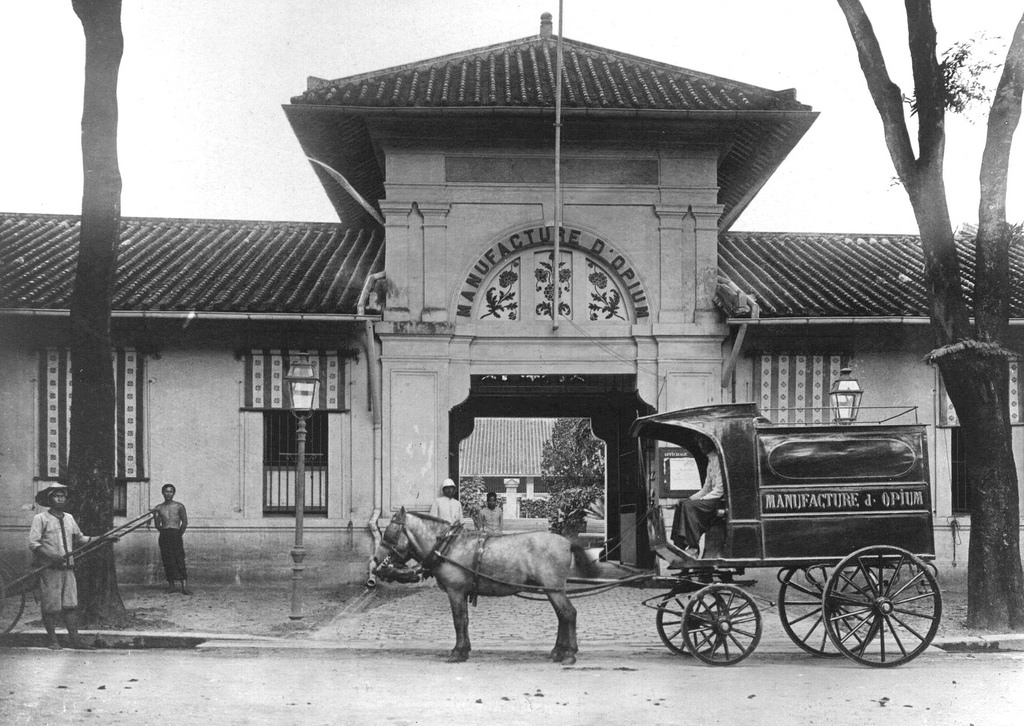
Howe does this affect our interest in Saigon-Cholon? Well, the Opium factory (bouillerie) in Cholon near Saigon was established in about 1874, and was the last factory of the craftsmen era (i.e. using manual labour). The raw opium arrived in the harbour of Saigon from Bengal and was immediately brought to the storehouse of the 'tjandoe' factory (tjandoe or pure opium as opposed to smoking opium 'madak'). Each chest held 40 opium balls. The balls needed were carried to the first section of the factory (bouillerie d’opium), in which four large stoves (fourneaux pour grandes bassines) were situated, each provided with two large kettles of 300 litres for opium water. The water was used for boiling the opium and later for peelings the balls to remove the écorces (opium bark), a product which was in high demand among poorer people.
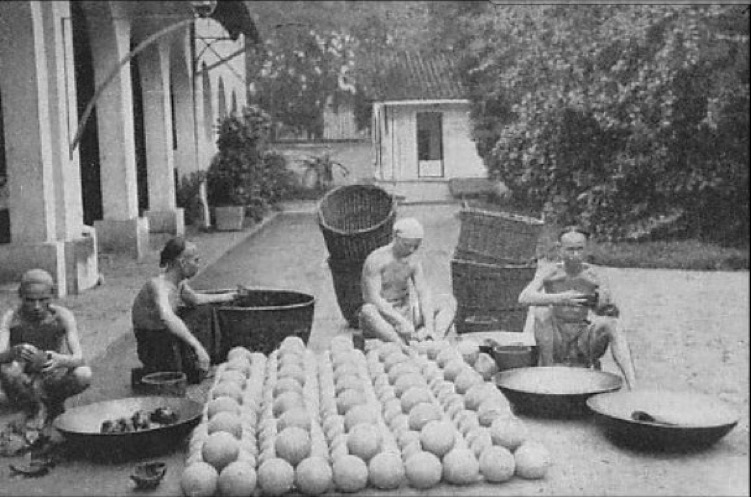
The labourers started by cutting the balls in two and taking the opium out of them with wet hands. The peelings were put aside for later boiling, whilst the inner parts were first boiled in the large kettles. The opium content of 2½ balls was put in a large copper pan together with four litres of opium water and boiled on a charcoal fire until concentrated. After it was removed from the heat, stirring continued to prevent the substances from sticking. This stage took two hours, and then a new procedure was started. The pan was put upside down on a soft charcoal fire, whereupon the substance fell apart in small slices which were removed immediately. These black-brown "pancakes" (crêpes) were so crispy that within a few minutes they fell apart if touched. The pieces were gathered in other large copper pans, each containing the equivalent of five balls. Twelve litres of opium water were added, and after soaking for about 18 hours, the "pancakes" had disappeared.
This result was filtered twice after the substance was boiled on a hot charcoal fire. After 2½ hours it was beaten until it was cold. The final product was weighed and transported to the factory storage. In the store it was kept for four months in large, closed, 300 litre copper barrels, filled halfway so some fermentation could take place. After this period the tjandoe with a 9.15% morphine content was ready to be packed. This was done in flat square boxes, and the cover was fastened by a drop of solder.
If you look at the year 1885, the French Cochinchina imported 850 chests at an average price of 568 piastre per chest. After processing, this produced an opium revenue of nearly 1.8 million piastre for tjandoe and about 54,000 piastre for the écorces. Taking a production costs of about 30%, this still produced a net profit in excess of 40%. Later the Dutch developed a "machine age" opium factory which proved to be far more economical, with production cost slightly lower than 20%. And remembering that whilst production costs stayed more or less the same, sales figures shot through the roof from about 1905, peaking during 1920-1930, before slipping substantially before WW II.
Here is an interesting and very extensive article on the Saigon opium factory, and Historic Việt Nam has an interesting article on Cochinchina opium monopoly.
It's quite difficult to find wage data in any coherent form, and it's all the more complicated with the separation of data for Europeans and indigène (native workers). In most cases the hierarchy appears the same, but the higher echelons were reserved for Europeans, and it's not clear that a European and native worker on the same 'grade' was earning the same money. However, the Opium factory (bouillerie) in Cholon was a government concern and some of those people working there were civil servants. We have the 'grades' and annual wages for some indigène (native workers) civil servants for the year 1923.
The top of the native worker grade was Chefs de manipulation de 1re classe, with an annual wage (solde annuelle) of 996 piastre. Then there were Chefs de manipulation de 2e classe (918 piastre annual), and Chefs de manipulation de 3e classe - (840 piastre). Security was important, and I've seen that workers were controlled and searched entering and leaving the Opium factory. So Sergents de 1re classe earned (solde annuelle) 762 piastre, whereas a Sergents de 2e classe earned annually 684 piastre. Then came Caporaux de 1re classe (606 piastre) and 2e classe (528 piastre). A Bouilleurs de 1re classe (boilers) earned 450 piastre annually. Alongside there roles there were Sous-chefs d'atelier de 1re classe who also earned 996 piastre annually, followed by Ouvriers chefs de 2e classe (668 piastre), Ouvriers chefs de 3e classe (598 piastre), Ouvriers chefs de 4e classe (528 piastre), and Ouvriers principaux de 2e classe (457 piastre). As you can see some data is missing simply because the lists were incomplete.
My best estimate is that 996 piastre, or 24 kg of silver, would buy you the equivalent of €5,500 worth of products and services in Europe in 2015.
So in Indochina opium was a state monopoly, and focussed mostly on the Chinese minority as the main client. Of course it did not help that the Chinese province of Yunnan was a major opium-producing centre, and it sat on the Sino-Vietnamese border. In fact opium trafficking alone represented more than 60% of cases judged in Lào Cai (on the border) between 1899 and 1940.
Legislation was quite complex, and included both fines and penalties for manufacturing or possessing opium without authorisation, e.g. which could exceed 1,000 francs to 2,000 francs, or at least five times the value of the opium. Prison sentences were from one-two months to three years, and a minimum of six months in the event of a repeat offence. There were also "opiums zones", where opium could not be sold outside the districts for which it was intended, on pain of being considered as contraband opium. The "zones" allowed the administration to reduced the price of official opium in the provinces where smuggling was the strongest, that is closest to Chinese territory. Finally, dens and opium outlets could also be fined in the event of fraud. Repressing opium smuggling was seen as the responsibility of customs officers, helped by garde indigène, the gendarmerie, and police and soldiers at border posts.
Smugglers would set up dens and outlets at night, because the law only allowed customs officials to search private homes from "five in the morning to half past six in the evening". In one case they discovered opium on a train, but because of the "late hour" couldn't search the homes of the traffickers (the law was changed in 1934). Another way to fight smuggling was to license "dealers", granting exclusive right to sell opium in a given territory. They were obliged to buy and sell opium at a price determined by the regulations.
Despite the number of cases that made it in to the courts, there were many that were dropped for one reason or another, e.g. financial compensation was offered by the offender, or the traffic was by "persons unknown", or the smuggler absconded and was sentenced "by default". Those criminals that went to court were almost always condemned to a prison sentence, fined, and ordered to pay damages calculated in proportion to the quantity and value of the opium seized. One article insisted that "those sentenced to heavy sentences must be employed in the most arduous work", except (of course) "notables" who didn't have to do the chores. Chinese prisoners were expelled at the end of their sentence. For those who could not pay the fines, the prison sentence was extended, for a fine of 50 francs it was for an extra 2 to 20 days, but for an unpaid fine of more than 2,000 francs it was one to two years extra. The reality was that convicts almost always couldn't pay the fines. One analysis of cases between 1924 and 1926 showed that prison sentences were about 1½ months, fines on average 83.5 piastre, but damages was on average 2,336 piastre. The result was that actually prison sentences were an average three time longer than originally pronounced.
What the analysis showed was that until 1920 there were up to about 40 cases per year, but after 1920 the numbers of cases rose rapidly up to nearly 140 cases annually. Also the quantities of opium seized increased as well, for the northern part of Vietnam it rose from 277 kg in 1919 to 6.8 tons in 1921 and 15 tons in 1928 (although it started to drop again after 1932).
However, the analysis also showed that the "opium syndicates" were almost never apprehended. They were often armed and benefiting from multiple sources of intelligences, particularly within colonial institutions such as the railway company or the customs administration. Most of the trials were against isolated individuals, not necessarily professionals fraudsters, but small peddler's transporting small quantities, so mere links in the immense opium smuggling networks.
Rice, Rubber and Coolies
Having mentioned more than once the role of labourer in the mines and on the plantations, let's look a little more closely at the life of a coolie, the low-wage labourer (albeit the word has its origins with migrant Indian indentured labourers used by the British).
Today Vietnam is the world's fifth major rice producer, but is the worlds second most important rice exporter, and the most prominent production area in Vietnam is the Mekong Delta. Wikipedia tells us rice has been grown in Mekong Delta from ancient times, but it was the French in the middle of the 19th century who wanted to export rice grown in the delta as a way to recover the costs of colonisation. So they developed a maze of canals in the delta to grow up to three rice crops a year.
We have already mentioned corvée labour, which the French abolished in 1789, but which re-emerged in French colonial policy, as a way to organise labour relations and taxation in rural Indochina (the English called them coolies). Definitions vary from a form of low-skilled and menial work, through to a form of 'benign' slavery. The reality was that there was a form of 'work contract' providing security of employment, but linked with a form of coercion in that the people were bonded labourers. The French needed an indigenous workforce, but did not want to resort to slavery. They needed people for the labour-intensive mines and plantations. The result was a mix of forced requisition and voluntary recruitment of impoverished, landless Vietnamese, often labeled as a "mission civilisatrice", almost blaming the adoption of slavery on the 'backwardness' of the local population.
The reality was that the French used three different definitions of coolie. Firstly, an ad-hoc recruitment of migrants, sometimes by force. Secondly, the traditional corvée, the requisition of people from the lowlands for public works. Thirdly, indentured labour, mainly in the mines and plantations, with labourers working under three-year contracts. The first might be for coolies to transport teak trunks down river in the form of rafts, a job of limit duration with people from a local population. The second might be when a local mandarin offers his small tenants (or local criminals) and collects the taxes, etc. The original idea in France was that out-of-season agricultural workers were obliged to work for the state, or pay additional taxes to avoid the work. Some defined the idea as simply terrorising local village elders with taxes and levies, unless they provided the necessary labour. A technique often linked to denying 'indigènes' basic human rights. In the building of the Hanoi-Yunnan railroad in 1897, 12,000 of the 60,000 Vietnamese and Chinese workers died along the tracks.
Already in the 13th and 14th centuries peasants could sell themselves into servitude in order to pay debts, often following a natural disaster or a bad harvest. In the 15th century peasants were freed and had enough land to support their families, but bonded servitude always existed, and resurfaced under the French. So the gap between the landlord class and the peasants remained, with the peasants obliged to work in the rice fields, dig irrigation canals, and build citadels, etc. As one writer put it, there was no power without concentrated manpower, and there was no concentrated manpower without some form of slavery. Others claim slavery was related to over population. The demand for rice increased, triggering a demand for more labour. Both agreed that warfare at the time was not about land, but about conquering new sources of manpower (e.g. selling slaves).
Coolies appear as both a form of corvée/servitude and indentured labour, and in French Indochina both were used by a mix of private enterprises in running the mines and plantations, and by the local bureaucracy in building local infrastructure. The French wanted a cost-effective colony, and yet looked to retain their "mission civilisatrice". The answer was first to intensify the rice-exporting economy, then to develop a mining and plantation economy.
One view is that the French looked for ways to make Indochina pay its way, initially by exporting two basic commodities, rice and teak. They improved rice production and introduced modern and regular transport links. Acreage increased, rice brokers appeared, and foreign vessels arrived in Vietnamese ports. The availability of bulk quantities of rice in the markets created a demand, which stimulated production, and trade ensued.
However, what really happened was that between 1860 and 1900 the population in the region increased at about 2.2% per year. With a conservative rice consumption estimate of 110 kilograms of clean rice per capita a year, the average total rice exports of Burma, Siam, and Cochinchina 1902-1911 could feed a maximum of 35 million people, less than 10% of the world's population increase in the previous half-century. Clearly steam ships and the opening of the Suez Canal had a major impact on the growth of any export trade, and it's true that the industrialised world would later be demanding more rubber, tin, sugar, hemp, coffee, etc.
But initially very few rice producing countries were major rice exporters. In fact, exports were limited to avoid the risk of famine in the local population. It was only after the 1850's that countries started to look to export their rice surpluses. This was in part because markets were opening up, and part because demand was rising, and so were prices. But still in the period 1899 to 1903 French Indochine produced most of Vietnam's rice, but it had to feed the whole country (Annam and Tonkin), even if it was considered of the poorest quality (high percentage of broken grains). What really drove the French focus on exporting rice was demand, not improved production and better transport. In the period 1902 to 1911 Cochinchina's exports of rice grew from about 12,000-50,000 tons to nearly 800,000 tons. The buyers were varied, Japan one moment, Philippines and China the next, and exports could rise and fall by as much as 40% from one year to another. But the trend was that Asian markets were increasing, and so cultivators could start to produce a surplus knowing that the millers and exporters would find a market somewhere. In Saigon, China reduced its imports, but increased imports by Europe and the Philippines compensated. By 1911 all the major markets appeared to take about 16% to 20% of rice production, and almost all markets were growing. The key feature of rice was that the price almost always increased over time, unlike some "boom or bust" commodities.
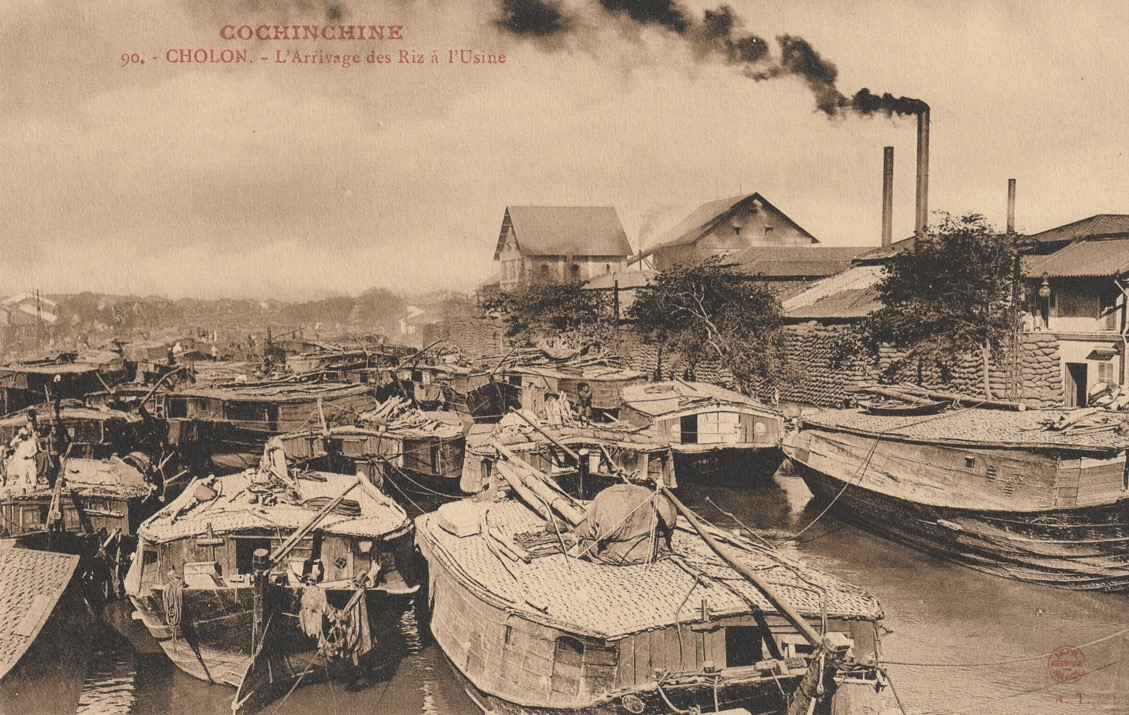
Saigon/Cholon exported 64,000 tons in 1860, 253,000 tons in 1870, 315,000 tons in 1880, 582,000 tons in 1890, 688,000 tons in 1900 and 996,000 tons in 1910. By 1914 they were exporting over 1.5 million tons annually. One author even claimed that in the early 1930's almost 90% of Cochinchina's agricultural production was rice, and Indochina had become the third largest exporter of rice in the world. But in each case the exports only represent between 19% and 26% of total production. Production improvements followed demand, with the first Chinese-owned steam-powered mill being built in Cholon in 1878, and by 1911 there were 10 mills, 8 of them owned by the Chinese. It was then that the Germans entered the market, and in a short time the two remaining French factories fell into their hands. However, during WW I the two rice mills were sequestered along with all German property in the colony. Put up for sale in 1915, they became the property of the Chinese, making them masters of the local rice milling industry. When the French arrived in Indochine the rice fields then covered an area of about 3.6 million hectares, and the normal production was barely four million tons. In 1945, the area of rice fields was 6.5 million hectares and the harvest reached 7.8 million tons, of which French planters owned about 10%. You may ask where all this extra land came from. It was easy, the French would declare itself owner of an expanse of land, and would then conceded plots to privileged European settlers, at a certain price. In Cochinchina, between 1921 and 1932, over 600,000 hectares were awarded as concessions, mostly for rice and some rubber. In Tonkin about 400,000 hectares were conceded, often for mining operations.
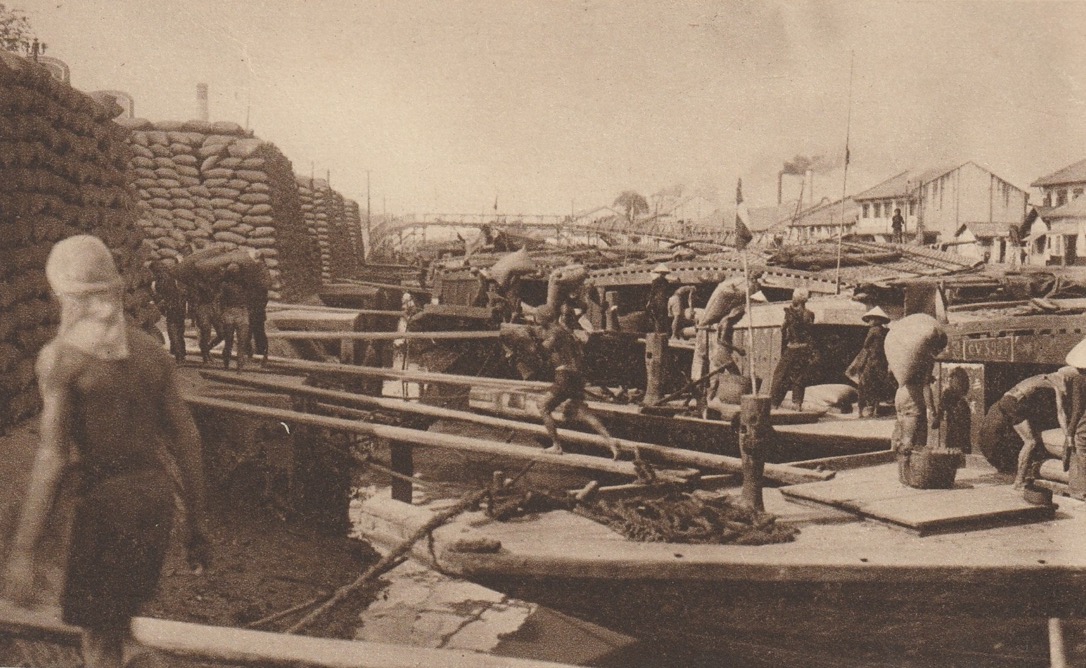
Rice production figures are questionable, in part because the French rice field land tax was based upon hypothetical yields, usually 140 kg of rice per square kilometre, and therefore the trend was to declare figures under this limit. But it's true that in Cochinchina there was little incentive to adopt new technologies or push farmers to increase yields, even double cropping was not practiced everywhere. For example, ploughs and threshers were expensive and water buffalo tillage was more usual, but often still too expensive for many small farmers. And we can see that in Cochinchina there was virtually no crop diversification, e.g. maize, potatoes, cassava or haricot beans were rarely planted even as a secondary crop. Part of the reason was that Cochinchina was home to large estates owned by wealthy landowners who were looking for profit and not sustenance.
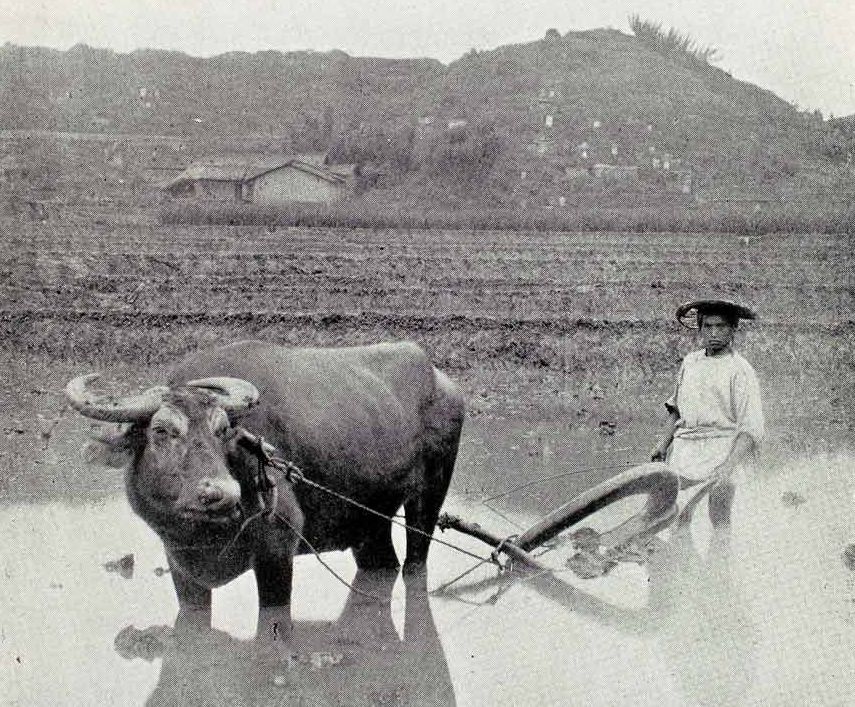
Rice was not "just rice", and different types of rice would go to different markets. Europe imported both hard, translucent, high grade clean rice, not ''white", as it was re-milled and polished on arrival for human consumption. They imported broken rice for distillation and animal feed. Japan and the Philippines would import white rice only. India imported whatever grain, from whatever source, was cheapest. China imported for her own consumption, and she also imported paddy rice, milled it, and re-exported it to Japan. From roughly 1880-90 onward, the diversification of milling and marketing was complete. Mills were re-tooled for whitening, and Cochinchina had developed export grades to suit European tastes, so each exporter could ship to the specifications of the importer. In this same period, advances in technology and transportation had made it possible to utilise most rice byproducts (bran, broken rice, husks) and even to export some of them. The technological triumph of the miller was complete. The miller usually lived in a port city, sometimes he was an exporter himself, sometimes he used the exporting firms. In combination, millers and exporters were able to exercise powerful leverage on the economy. Often the miller was connected with the distilleries making rice alcohol. Most of the time he worked for himself, not for clients. He bought rice, milled it, and sold for a profit, rather than milling for a commission. And above all he had closer contacts with the paddy's in the interior of the country than exporters or government officials. The French altered their export duties on rice eight times between 1879 and 1899, generally revising them upward (in piastre) to reflect the depreciation of the currency. This way they were able to keep customs revenues expanding at the same rate as exports. The French also encourage trade with France, not only by raising protective tariffs against foreign rice in the mother country (1893), but also by reduced export duties on Cochinchina rice going to France (1881). They, like other governments, influenced the rice industry through their land policies and investment in public works, e.g. canals, railroads, etc.
To keep the rice economy flourishing a continued supply of paddy was required, and no one was more aware of this fact than the miller. A rice mill was a unit of high initial cost, high capacity, and high profits when it was running, but it could not be left standing idle. The miller had to ensure a steady supply of paddy just to keep it operating, and keeping the rice flowing though the ports needed a complex network of rice brokers, agents, market towns, credit, and internal transportation, all combining to move paddy from the cultivator to the miller-exporter. The brokers, like the millers, were largely foreigners (often called aliens), but unlike the millers they did not operate western-made machines and sign standard western-model contracts. In the early days, the paddy intended for export came to the ports through traditional channels. The port cities began to send out brokers, some were actual agents of the mills, some worked for "commission houses" or kinship groups in retail and banking. In Cochinchina brokers were almost entirely Chinese, so ethnically linked to the principal millers and retailer (though a few wealthy Vietnamese managed to get slices of the action, by cooperation rather than by competition). Whatever their nationality, the rice brokers soon came to play an essential role not just in the rice trade, but in the whole economy. Many of them were already retailers, others learned to augment their brokerage profits by selling goods to the cultivator while he was enjoying the prosperity of harvest. The transportation of rice became more of an expense as distances increased, and it was the mills and brokers who financed the large junks that could carry rice over a hundred miles across or down the network of waterways. As time went by, provincial centres began to develop into larger market towns, until by 1932 there were more rice-merchants in the interior than in Cholon itself. And each of these merchants had his own agents even farther out in the countryside. Rice storage was another essential function of merchants and brokers. Peasants had to sell the rice soon after harvest not only because of debts, but because they had nowhere to store it during the monsoon, whereas the brokers had the capital to build "godowns" (warehouses). And the paddy-brokers were also an essential source of market information (and misinformation) to the peasant, they were the visible link to the world of markets and money.
But the most important function played by rice-brokers in the economies of mainland southeast Asia, perhaps equal to that of actually procuring rice, was the furnishing of rural credit. Mills and city merchants were increasingly anxious to guarantee a supply of paddy, and began to make cash advances to their agents in the interior. These agents, and the independent brokers, in turn ensured their supply by making advances to the cultivator against the purchase of his next crop. The advances might be made to feed the peasant after a bad harvest, or to allow him to invest in more land, tools, draft animals, or hired labour. The interest rates varied from merely high to astronomical. Not one source quotes figures below 20% per year, and estimates for some loans ran as high as 200%. The whole subject of agrarian credit (and debt) in these societies was an immensely complex one, but the broker-lenders provided two economic services. Firstly they provided new capital, that made it possible for new lands to be opened, improvements to be made, bad years to be survived. Government-sponsored agrarian credit simply did not exist in this period, and kinship borrowing often proved more expensive than borrowing from a broker.
The second service involved in broker moneylending was perhaps more critical, if less obvious. This was to regularise and structure the marketing relationships within the society, where written contracts for delivery were all but unknown. Mills had to have rice and depended on agents to provide it. Merchants, having accepted advances from the mills, needed to ensure that they would have paddy to deliver. Cultivators not only got their immediate loan, but a guaranteed market for their next harvest at an established price. That this price was low is incontestable, but at least it removed one element of risk from peasant to the broker. Finally, credit tied the agent and the cultivator into a continuing debt relationship, the cultivator might never pay off the original loan, but so long as he delivered his crop to the broker, it was assumed that more credit would always be available.
The social network of marketing, of course, depended on the physical network of internal transportation. For rice, in this period, that meant waterways-rivers and canals. Roads provided only local transportation in areas not served by waterways. Digging canals to improve internal transportation was not new in the late 19th century, but the continued expansion of rice acreage, particularly into largely undeveloped areas, depended in part upon the continued expansion of this network. The French in Indochina, were strongly committed to hydraulic engineering and proudly computed the number of cubic meters of earth they moved each year (rising from 140,000 in 1893 to 6,000,000 in 1913). After using manual labour from 1866 to 1895, they introduced machine dredges in 1893, and by the 1930's had dug 1300 kms of rectilinear primary canals, 22 meters wide and 2 meters deep at low tide. The rapid growth of both the Transbassac population and paddy acreage was made possible by the canals dug there. Most of the settlers moved to their new lands in sampans and built their houses in long rows along the embankments. The flatness of the Transbassac and delta area and the height of tides in the South China Sea (2 meters) made the tides the most important source of motive power for the boat traffic of Cochinchina, and a rice broker could travel from the market town to the village on one tide and return on the next.
Then in the 1920's rubber was the boom crop. In fact rubber concessions were given away until 1913, and afterwards were sold at auctions. Rubber takes some years before becoming profitable, so land prices were discounted and tax concessions offered to attract entrepreneurs. Concessions for large plots were granted in Cochinchina, meant for large landowners, who would employ wage labour (typical for many cash crops). Between 1927 and 1937 cultivated acreage for rubber almost doubled but exports rose by a factor of five, and boatloads of coolies were imported from Tonkin and Annam. They worked under a 3-year contract, a form of indentured labour. The original contract was designed for white immigrants, who worked for 3 years, and then could buy and own the land they cultivated. But the problem was that in the mid-1920's establishing a rubber plantation was expensive. With a cost of between 500 and 1,200 piastre per hectare, few could afford that type of long-tern investment, and it was companies such as Michelin that bought up 60,000 hectares for its rubber plantation. Despite 980,000 square kilometres dedicate to rubber, it was still very small compared to the area dedicated to rice, but it quickly rose to being the second most valuable crop, after rice. By the late 1930's rubber represented around 18% of the colonies export revenue. By that time Cochinchina was the 5th largest producer of rubber by acreage, 4th largest by output, and 1st by land productivity. But rubber was an export, and as such was affected by variations in the international market, e.g. Great Depression, etc.
The "Code de l'Indigenat" legalise the different treatment for French citizens and colonial subjects. For example, Michelin developed plantations in the thinly populated regions of south Vietnam, and imported plantation workers from the region of Hanoi in the north. Wealthy Vietnamese landowners collaborated with the French, subordinating tenant farmers to the point where the only way to pay off their debts was to sign coolie contracts. The migration from the north to the south represented about 25,000 coolies per year. Plantation owners argued that they were improving the living conditions on the plantations, and the colonial powers could see that the annual coolie migration was indispensable (if hardly benevolent). They ended up institutionalising and legitimising forced labour. There were new regulations that fixed some of the workers’ rights, such as a working day of nine hours, a specific number of days off, and the obligation on the companies to explain the contract in all details to the workers (who often could not read). In general, the labour reforms only secured the existence of the coolie system and consolidated the legal divide between coolies and free workers. One example of this was the introduction of the so-called carte speciale d’ouvrier contractuel, a specific passport for coolies that replaced the ordinary ID card. This passport was modelled after that created for the Légion Étrangère. The place of origin did not matter. Rather, the name and place of the employer, for example a plantation company, was written on the passport. This means that the worker was actually bound to the plantation or mine in that he was not allowed to change either employer or place of residence. In fact, any leave was treated as desertion and severely punished. Only after the contract had finished could the coolies exchange the carte speciale for a regular passport.
Slavery was illegal, but bonded servitude and indentured labour wasn't. Debt bondage might imply a mutual obligation, but it often resulted in a form of enslavement based upon usury and debt default. When a debtor could not repay what he had borrowed, the creditor used him as free labour for varying periods of time, sometimes years, or even for the rest of his life. Descriptions vary, but it's generally recognised that coolies were often forced to work from six-to-six with only a short break. Many of them suffered from exhaustion, injuries (induced by accidents or the overseers’ relentless beatings), malaria, and dysentery, and many coolies died and were buried on the plantations. Usually food and clothes allowances were guaranteed by the contract. However, often the rice and dried fish were of such poor quality that the workers were forced to buy additional food in the local shops, which were usually run by the companies. These shops also sold other items like needles for sewing clothes, and sometimes turned into gambling halls in the days following payday. Though in theory coolies were allowed to quit the contract after 18 months, given that they had paid back advances and recruitment costs, but by then the coolies were often already heavily indebted. Many coolies bought credit, and the gradual accumulation of debt forced them to sign consecutive contracts, attaching them "as semi-slaves to their employer".
The combination of advances and retainers was another factor contributing to the risk of indebtedness. Advances that lured coolies into signing work contracts were deducted from their salaries over the first year, while the company withheld a portion of the salary as so-called 'pécule', an amount of money only paid at the end of the contract. One French mining company withheld 30% of its workers’ salaries, and not surprisingly, the reduced salary and the precarious life on the working sites resulted in indebtedness. It was only a very small step from contract labour to bonded labour to forced labour.
As the French would do, they created an "Office Général de Main-d'Œuvre Indochinoise" in Hanoi, which represented the exporters. In 1927 they explained that they provided agricultural workers for the price of 38 piastre, based upon a transport cost of 12 piastre per worker. In addition 10 piastre was given to each coolie, as a recoverable advance on their wages. And in addition the coolies receive a trousseau, which cost 2.50 piastre for men and 3.60 piastre for women. These "material advantages" were welcomed by the administration, whilst noting that the only reason an Annamite would accept such work in the south was if they were dying of hunger. Why would someone accept to move south, into the unknown, and be badly treated, when rice was cheap at home and they could earn 0.20 or 0.25 per day piastre working locally on one of the government construction projects? This was the key question that no one could really answer, yet the north shipped south around 25,000 people per year into what was in most cases not even 'benign' slavery.
It's almost impossible to obtain a clear picture of something like living standards or quality of life in the period between the wars. Most of the data is about what the French government did to try to improve social conditions, and not what was the outcome. Budget data shows what they spent, but not what the impact was. Secondly, the data is limited, for example data might be available for stillbirths but not infant mortality. Thirdly, there were considerable differences between the middle-class and the working-class, and between urban and rural areas. Another aspect was that legislation might have required better living quarters for workers, but the rules were rarely enforced.
But we need to be realistic, between the wars the government's health budget represented around 0.1 piastre per person, the equivalent of ⅓ of the daily wage of an unskilled male worker. So, great on rhetoric, not on action, even if per capita expenditure did increase over time, they still spent twice as much on public works. Nevertheless, it did fund hospitals, rural infirmaries, maternity units, care homes, etc.
School enrolment increase over time, but remained lower than in other countries in the region. There was much written about the students passing the French baccalaureate, but the reality was that only 44 ever past it in Cochinchina. There was a noticeable investment in primary education, but it was not followed through in the same way in secondary education. Secondary institutions were difficult to enter and applied competitive exams in French.
In terms of wages, information is incomplete, but it looks as if employment started to decline in the early 1930's, placing pressure on wages, and in some places they actually declined over time. Cost of living indexes for both Europeans and the indigenous population were collected. What they don't show is hours worked for the wage indicated, nor do we have unemployment figures. Finally only a small number of enterprises were surveyed, e.g. between 36 and 66 enterprises in Saigon. The best estimate is that the survey covered about 3% of the population.
During the period 1931-1936 average daily wages in Saigon-Cholon ranged from 0.41 piastre for apprentices, through 0.72 piastre for specialist coolies, to 1.94 piastre for a manager (about twice the wages paid in Hanoi). A lot depends on the purchasing power of the daily wage. Colonial authorities estimated that a household could be expected to spent more than 30% just on rice. And rice prices were more or less the same in Saigon as in Hanoi (between 0.083-0.122 piastre/kg), so workers in Hanoi were paying nearly twice as much of their wages to buy the same amount of rice.
Naturally rice prices were not the only difference between Hanoi and Saigon. Hanoi's indigenous middle-class basket of goods looks a bit like todays, i.e. food, lodging, clothing, other. The difference is in the detail, e.g. 8.3% for rent and about 70% on food. When you look into the details the difference between Saigon and Hanoi was even more complex, often prices were the same in both cities, and in some case it was actually cheaper in Saigon, e.g. for fish, soap, and even chicken. But Saigon was more expensive for heating wood, rickshaws and cinema seats, and in Hanoi 48 bottles of beer would cost only 0.27 piastre, whereas in Saigon they would cost 12 piastre!
As we might expect French colonial rule did impact urban living, but most experts conclude that they had little effect on the rural standard of living (only about 14% of the population lived in urban areas). For some, only the elite benefited. The administration decided what the agrarian average wage was. In 1933 it was 0.27 piastre/day during planting-harvest time (covering 7 months of the year), but that would have included 700 gm of rice for 2 meals daily. Wages were actually a little higher for immigrants from the north, in order to attract them to move. One estimate put the annual income in 1936-1938 for a coolie in Cochinchina at 27 piastre, and for a 'middling' landowner or tenant nearly 110 piastre. The household of that coolie would spend about 70% on food, whereas the 'middling' landowner would spend around 35% on food. The reality was that rural living in both Tonkin and Cochinchina was dismal at best, and in neither case did colonial rule do much to change that.
Probably the most impressive conclusion was that urban wages in Saigon were very much higher than in Hanoi, yet prices were only marginally higher. I wonder if that was the motivation for my maternal grandparents to move from Hanoi to Saigon in the 1920's.
For readers interested in the details of the Saigon-Cholon rice business, have a look at "Le Commerce et l'Industrie du Riz en Cochinchine (1868-1920)", and the "Office Indochinois du Riz". And for a cultural overview have a look at "Rice in the Life of the Vietnamese Tháy and Their Folk Literature".
My wife's fathers military service
Paul C…, my wife's father, was called up for military service before his marriage, and remained on call (conge sans solde) until 1954. He was later called up for training in 1934, again in 1938, and again in 1939. He was also called up to serve for short secondments in both Cambodia and Laos in the 1940-41, fighting the Thais.
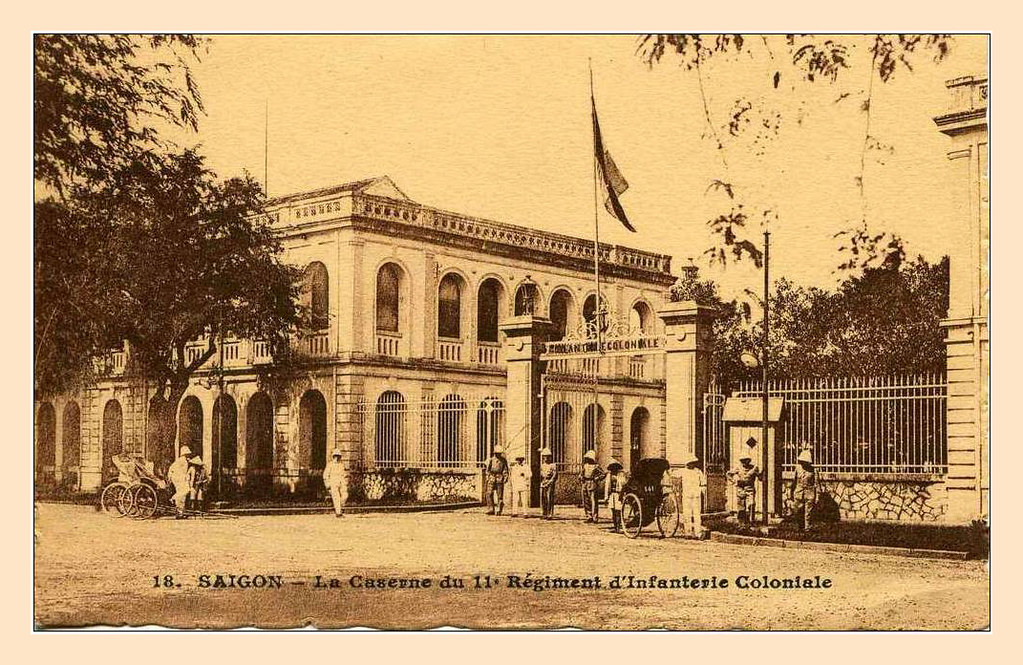
Initially he was Chef de section d'Infanterie - section de Fusiliers Voltigeurs in the 11e Regiment d'Infanterie Coloniale. Now what is a "Fusiliers Voltigeurs"? Firstly, a "voltigeur" was not an acrobat. In Napoleonic times, they were marksmen in the light infantry that skirmished, i.e. help protect a battalion from the enemy. Their origin lies with hunters and scouts (éclaireurs) who would sit behind a rider, jump to ground and open fire, and this gradually evolved into a skirmisher. In the more modern context they were a half-squad (6 men) that provided a "shock" (voltigeur) along with the other half-squad (6 men) who provided the "fire" (fusilier). So the fusilier would shoot at the enemy, creating enough time for the voltigeur to vault out of the trenches, sprint across the gap, and assault (nice word for kill) the enemy in their trenches. For those passionate to know everything, check out "Instruction pour les Unités de Fisiliers-Volitgeurs" date 1939. Later Paul C…, was nominate "sergeant de reserve".
As we look at the above postcard, we can see two classic symbols, one of the local Vietnamese population, the other of the colonial presence in the region. The first is the Asian conical hat, or more specifically the Vietnamese Leaf Hat (nón lá), and the second is the what the author called the new Model 1931 sun helmet. New because it replaced the Model 1886 with a wider brim offering greater protection against the sun (evolutions followed as seen here).
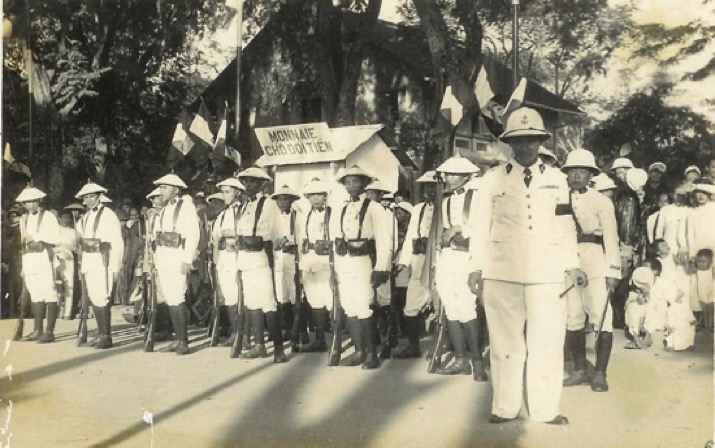
As the article on leaf hat points out "What is unique about the Vietnamese nón lá is that it has its own origin, based on a legend to the growing of rice in the region. This tells of a giant woman from the sky who protected humanity from a deluge of rain, and she wore a hat made of four round shaped leaves to protect her from the rain – and that inspired farmers to stitch together their own style of helmet. This has evolved over the centuries and various styles have become common in the different parts of Vietnam". The article goes on to describe in depth the role of the French Tirailleurs Indochinois.
Another family member Car…?
In scanning though all the different early background documents it's possible to isolate the presence of a particular family name, such as Car…, and in some cases it's possible to follow a particular life through space and time (career path, locations and dates). Interestingly the family name Car…, was not common, nor very uncommon, so almost every official record mentions one, two or even three forenames, dates of birth, etc. But equally we are left with many simple unknowns, e.g. did my wife's grandparents have brothers or sisters, who were her great grandparents, why did people immigrate to Indochina in the late 19th century? Without requesting birth/death/marriage certificates and/or using an ancestry service it's difficult to collect all the data, in particular when it relates to time spent in a colony.
As my wife's paternal grandparent started his career in the police, so a Julien-Eugène Car…, appeared for a period as a mécanicien (mechanic) on what were called "chaloupes". I've no guarantee that this was an early member of my wife's family, but I've been able to place other "Indochinese" Car…, though to WW II, and this one is the odd-one-out. The date of birth of Julien-Eugène Car… could (just 'could') make him a brother to my wife's paternal grandfather. Who knows?
Even if our Julien-Eugène Car… was not a relative, the intrigue was there, starting with the question, what was a "chaloupe"? Wikipedia points to something along the lines of a longboat, used to transport heavy material or casks of drinking water, etc. The French language version of Wikipedia defines a "chaloupe" as an old fishing or trading boat fitted with sails, or a large craft carried on ships. They note that it was the main means of transporting goods throughout the 19th century around some parts of the French coast.
But in the context of Indochina in the 1920's, we are looking at something quite different. Firstly, "chaloupes" were part of the Compagnie des Messageries Fluviales, that is river transport steam vessels carrying mail, passengers and cargo, along the rivers of Indochina. It was in the 1920's that the company started to upgrade the boilers, permitting river "chaloupes" a maximum speed of around 10 knots. According to the different plans a "chaloupe" of the Compagnie des Messageries Fluviales could be anything from 19 meters to 67 meters long, with one or two masts, one or two decks, and with or without cabins, etc.
One of the main routes taken was along the Mekong, at 4,900 km, one of the worlds longest rivers. It was possible to go to Phnom Penh, and then to steam though the French protectorate of Laos. Today the 'Danube of the East' is slowly being killed by the building of a vast number of dams, both in China and all along the lower basin.
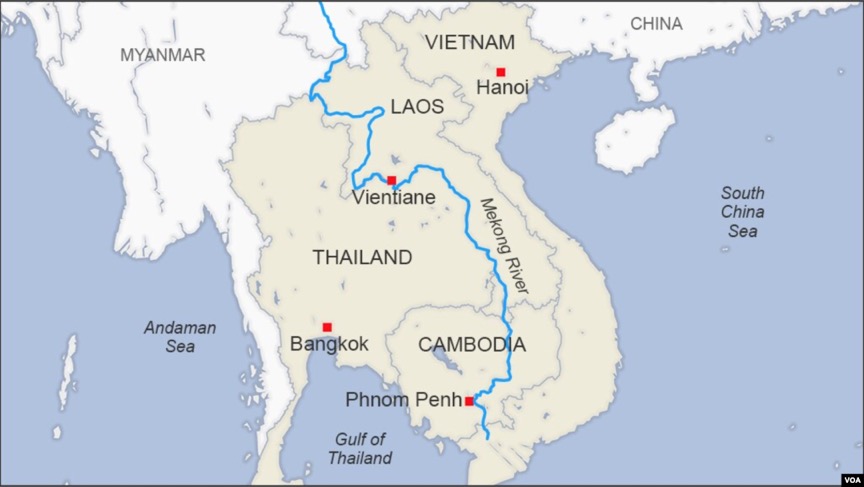
The world was simpler in 1898, and the only problem was the Khone Phapheng Falls in southern Laos, which are the largest in southeast Asia, and the main reason the Mekong is not fully navigable into China. Not to be beaten, the French constructed the Don Det-Don KKhon railway, a narrow-gauge portage railway across two of the many islands created by the falls (which are less like Niagara and more like rapids).
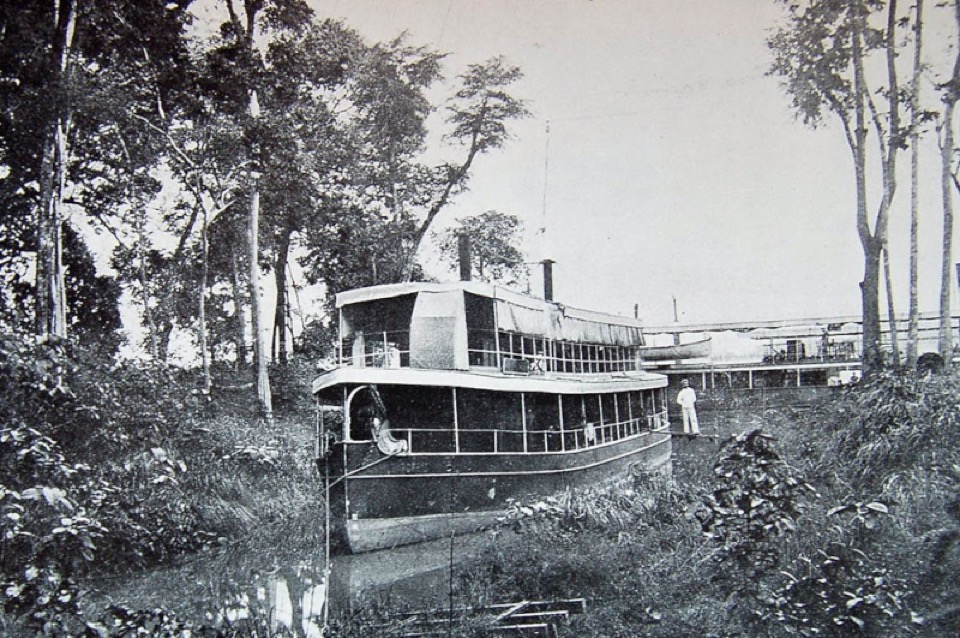
What they would do was beach the "chaloupe", as seen above with the "La Garcerie", and then transport it on rails, as seen below with the "Trentinian".
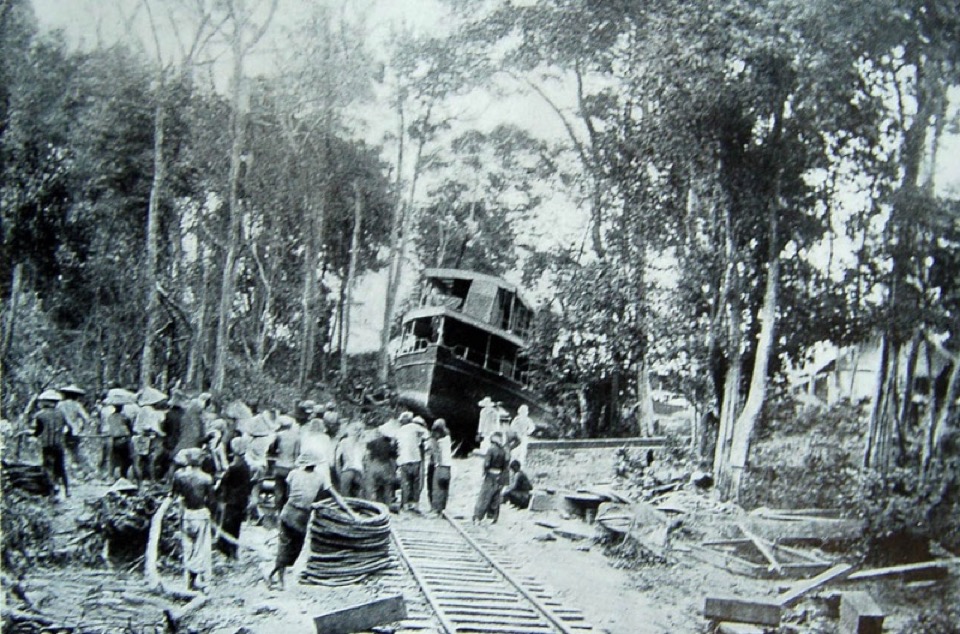
What made our Julien-Eugène Car… even more intriguing was that we have the names of the "chaloupes" on which he worked, firstly the "Bonite", then the "Vinh". In fact what we see is that the "Bonite" was part of the Administration des Douanes et Régies, Sous-Direction de l'Annam (Customs and Excise Annam). And the very next year Julien-Eugène Car… was on the "Vihn", but this time in the Sous-Direction du Tonkin (the "Bonite" had also moved to Tonkin, but with a different equip).
Whilst there is little grounds to delve further into the past of Julien-Eugène Car…, we can turn our attention to the two "chaloupes" mentioned above.
Firstly, in 1908 there were 360 customs control stations in Indochina (109 in Cochinchine), and they had 16 "chaloupes", 5 "vedettes" and several smaller vessels. Rather than operate as custom vessels, most were actually used to fight piracy, which was endemic in Tonkin and Annam. In many cases it was the pirates that attacked the custom vessels, and quite a number of officials were killed in action. It's not surprising that the postcards of decapitated pirates sold well.
When the mail service was no longer subsidised between Indochina and Siam, the "Bonite" took on that role for three full years. It ran every 14 days Saigon to Bangkok, and back. It was very unusual that a customs boat would make these trips, and even take on paying passengers. It was even more unusual give than "Bonite" was actually a gun boat.
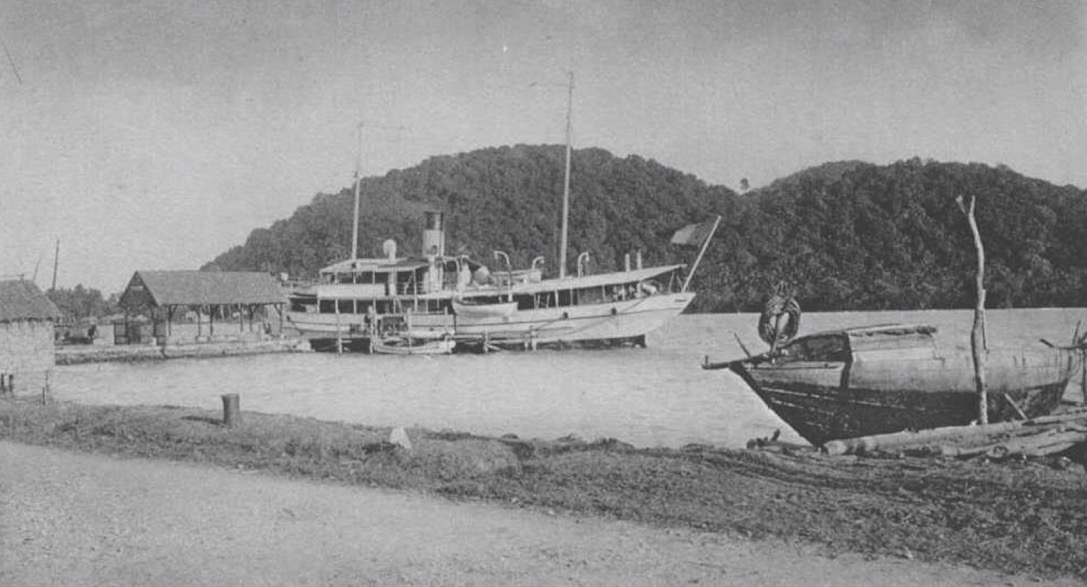
In fact "Bonite" (above) was built in Haiphong in 1912, with a steel hull, 42 meters long, 7 meters breadth, and powered by steam engine of 675 horsepower, giving it a maximum speed of 11 knots. She was armed with two 47 mm canons, two 37 mm canons, 10 rifles, and 10 revolvers, and carried both a search lamp and a radio T.S.F. (Transmission Sans Fil, which only started to be built in the early 1920's). It was more or less conceived to chase pirates. After its three years as a mail boat, it went in to the Saigon arsenal for a re-fit. Five years later it was still waiting for the spare parts for its hull and boiler.
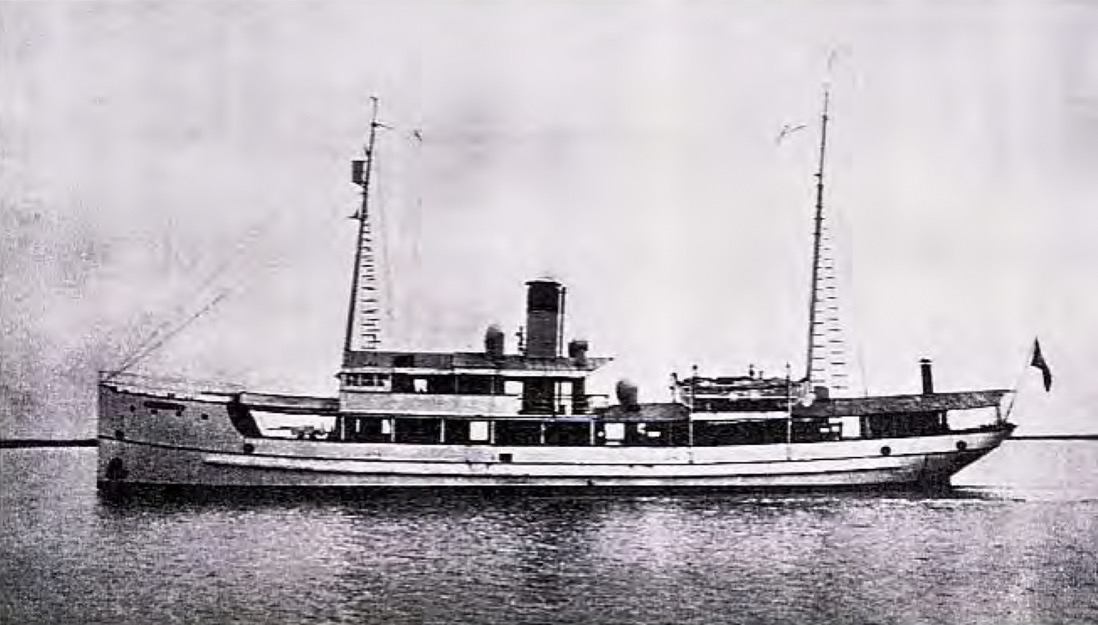
In 1929 the Bonite was re-named "Capitaine Coulon" (above), after a captain who was lost as sea. At the beginning of WW II the "Capitaine Coulon" (ex-"Bonite") was converted into a minesweeper, and started to escort merchant ships. It was not commandeered by the Japanese, and it started to escort ships transporting rice and coal between Cochinchina and Tonkin. On 20 February 1944 whilst escorting the "Francis Garnier", the transporter hit a mine that had been laid on 14-15 January 1944 by the US submarine Crevalle. The "Capitaine Coulon" managed to save 31 of the crew of "Francis Garnier", but 25 others died at sea. On the 10 March 1945 it was decided to scuttle the "Capitaine Coulon" rather than see it pass in to Japanese hands.
Concerning the "Vinh", it also changed name to "Louis Graltin" on 10 October 1929.
Looking through the Annuaire général de l'Indo-Chine we can see that the Douanes et Régies de l'Indochine was one of the larger administrative services and also one that employed a substantial number of indigène (natives). It is in the annuaire of 1923 that we can find some information on the posts occupied by those indigène and the wages of the day. It was from 1906 that the flotilla and workshops of the Douanes acquired a special status independent from the army. Executive posts were reserved for Europeans, and on each "chaloupe" there was one on the bridge (what we might consider as the captain) and one in the machine room (head mechanic). The two nominate individuals were always identified in the annuaire for each "chaloupe". The highest post mentioned for indigène was Commis principaux de 1re classe, with a salary of 2,400 piastre per year. It was also possible for an indigène to be patron-pilote chef or a mécanicien-chef, and both received an annual salary of 762 piastre. However many of the indigène posts were for ouvriers, ouvriers principaux, or ouvriers chefs, with annual salaries ranging from 243 to 762 piastre.
The only point of comparison I have is that in 1918 a professeur agrégé could earn up to 56,000 francs, a professeur up to 36,000 francs, and an instituteur up to 19,000 (although they would usually start their careers with a little less than half of that salary). These salaries would equate to a purchasing power in Europe in 2015 equivalent to €65,000, €42,000 and €22,000 respectively. Whereas 2,400 piastre in 1923 would equate to about €13,000 in Europe in 2015.
The family moved to Cholon
The next identifiable step in my wife's "virtual" history with Vietnam is when her parents Paul and Marguerite, once married, moved to Cholon in the 1930's. We know my wife's younger sister was born in the Hôpital Militaire Français Grall, and that the family was living at 15 Bd. Charles Thomson in Cholon. My wife remembers being told that both she and her older sister were also born in the same hospital (her birth certificated mentions Hôpital Grall). So we presume that 15 Bd. Charles Thomson was their principle family home since we have no records of them living elsewhere in Cholon. We do know that the family later had to move to Saigon for safety reasons, but we also know they were still in Cholon in December 1943.
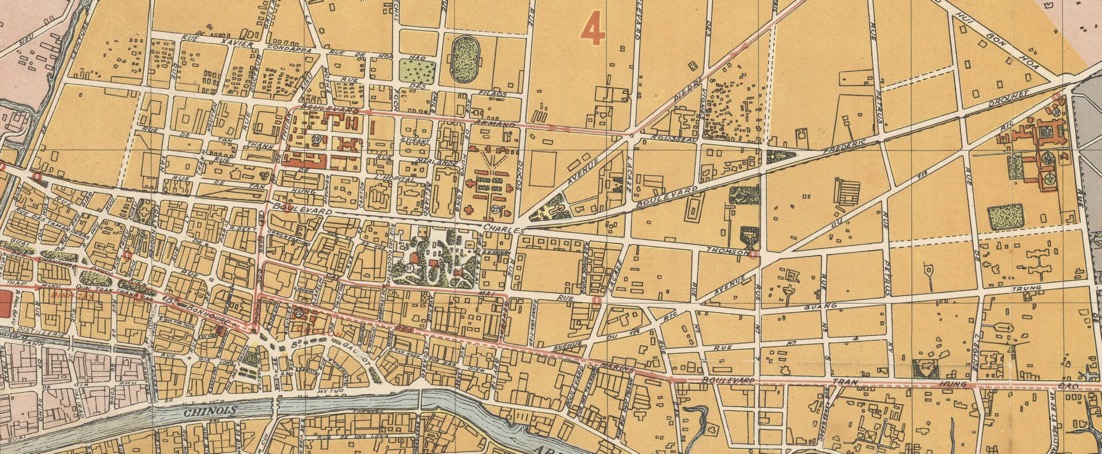
Above we have a map of Cholon where we can see that 15 Bd. Charles Thomson is a major axis running right through the town, and in the below map we see that it was later renamed Hồng Bàng. Charles Antoine François Thomson (1845-1898) was governor of Cochinchina between 1882 and 1885, during which time the French increased their control over the region, including Cambodia. The Vietnamese government naturally replaced his name, by renaming the road Hồng Bàng, after the legendary dynasty that ruled Vietnam from 2879 BC to 258 BC.
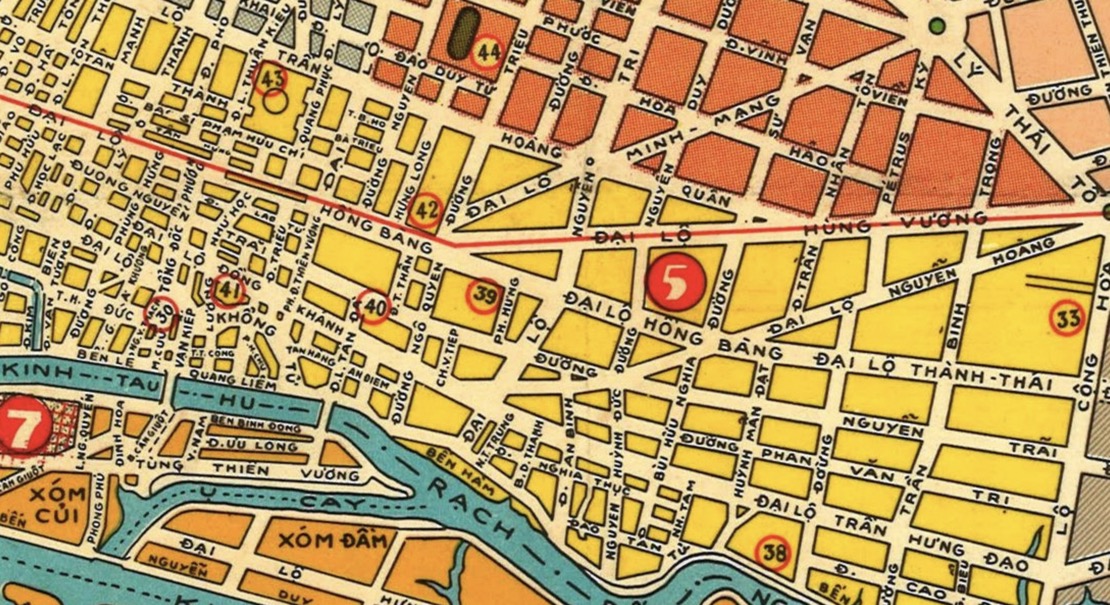
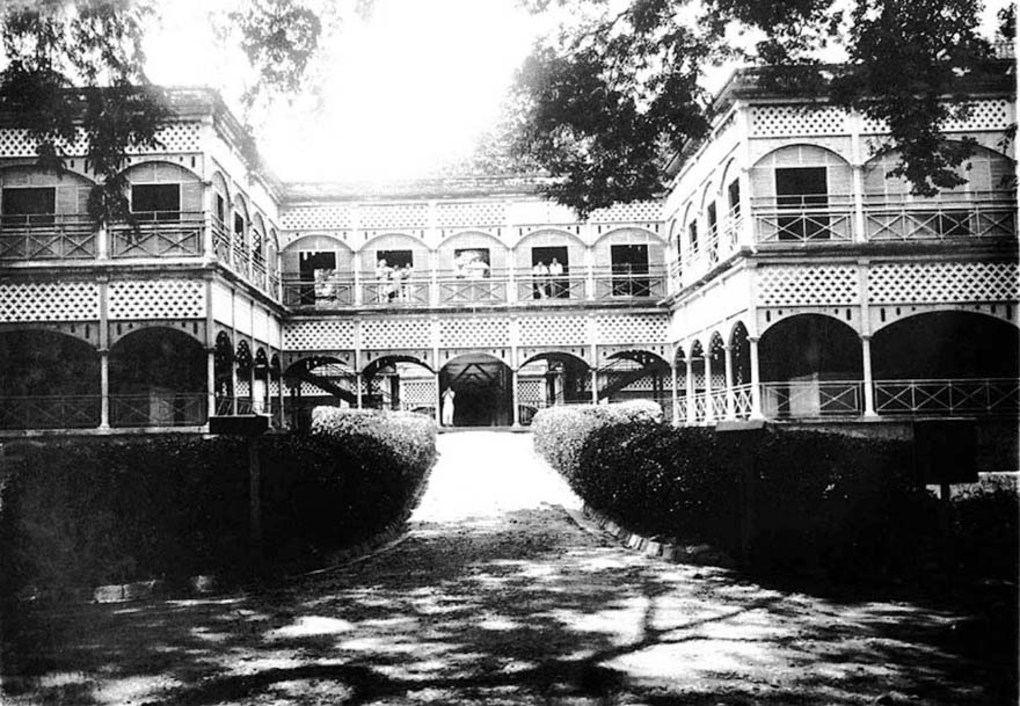
My wife remembers (being told) that she was born in the Hôpital Militaire Français Grall, as were her two sisters. The hospital dated from 1862, and in 1925 it took its name from Charles Grall (1851-1924), who was the first director of health of Indochina. Check out this article on the hospital going back to the 1870's. Above we have the main entrance, and below an aerial view, both dating from 1930. It is now a children's hospital called Bệnh viện Nhi đồng 2 and its address is now 14 Lý Tự Trọng. Again we seen the way the Vietnamese have tried to more than simple erase the past, they have replaced a military hospital with a children's hospital.
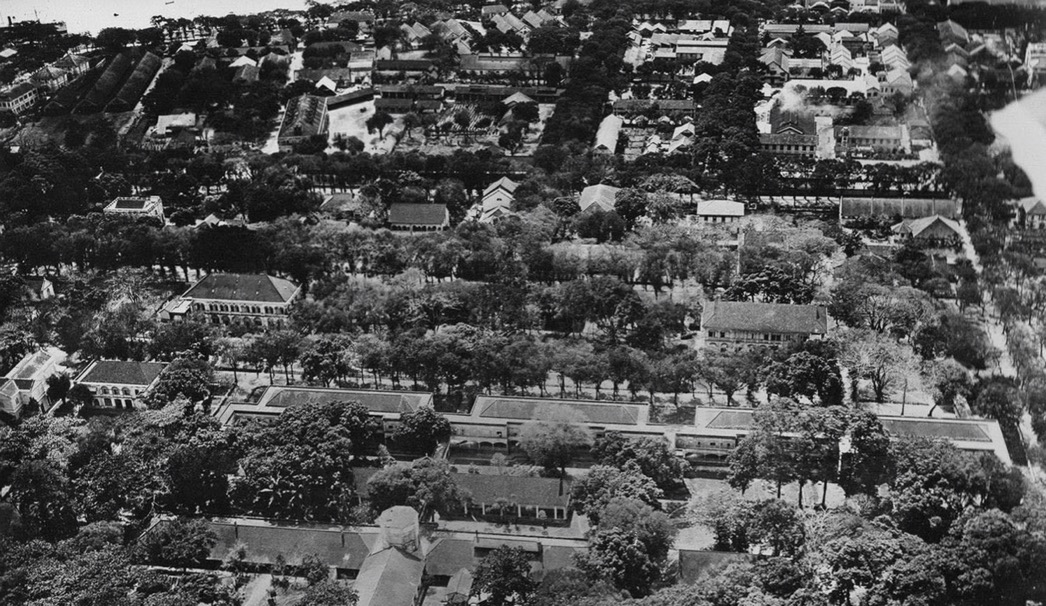
Already in 1931 Saigon and Cholon had become a single urban entity called "Saigon-Cholon". Even if it was still very rare for the French (or any Europeans) to live in the "Chinese" Cholon, life must have had its advantages. My wife still has fond memories of the house domestics, and in particular the nanny that would sleep at the foot of her bed, and the cook who slept next to the outdoor kitchen.
My wife also still speaks of a big garden, with monkeys living in the trees and playing with the children's swing, and the ever present risk of venomous snakes dropping out of the branches. There is no risk of that now, since it looks as if there are virtually no single houses with large gardens left on today's Hồng Bàng. Today this old boulevard is now a 4-lane highway dominated by shop-fronts and commercial premises.
My wife often mentions that her older sister was born blond with green eyes, and given that yellow was always a sign of wealth, prosperity and happiness, everyone wanted to touch her hair. We will learn at the end of this webpage, that my wife's sister also had luck on her side.
When living abroad, in my humble opinion, the 'highs' are a little higher, even if the occasional difficulty can become exasperating at times. And that must have been, perhaps even more so, in Vietnam in the years during WW II.
Below we have photograph of my wife's parents enjoying themselves in 1938 at Le Cercle Sportif Saïgonnais. My wife's father is "centre stage", and my wife's mother is standing behind him. As is usual the Vietnamese always managed to find an "appropriate" alternative name for their colonial heritage. The elite Cercle Sportif is now called The Labour Culture Palace, at 55B Nguyễn Thị Minh Khai.
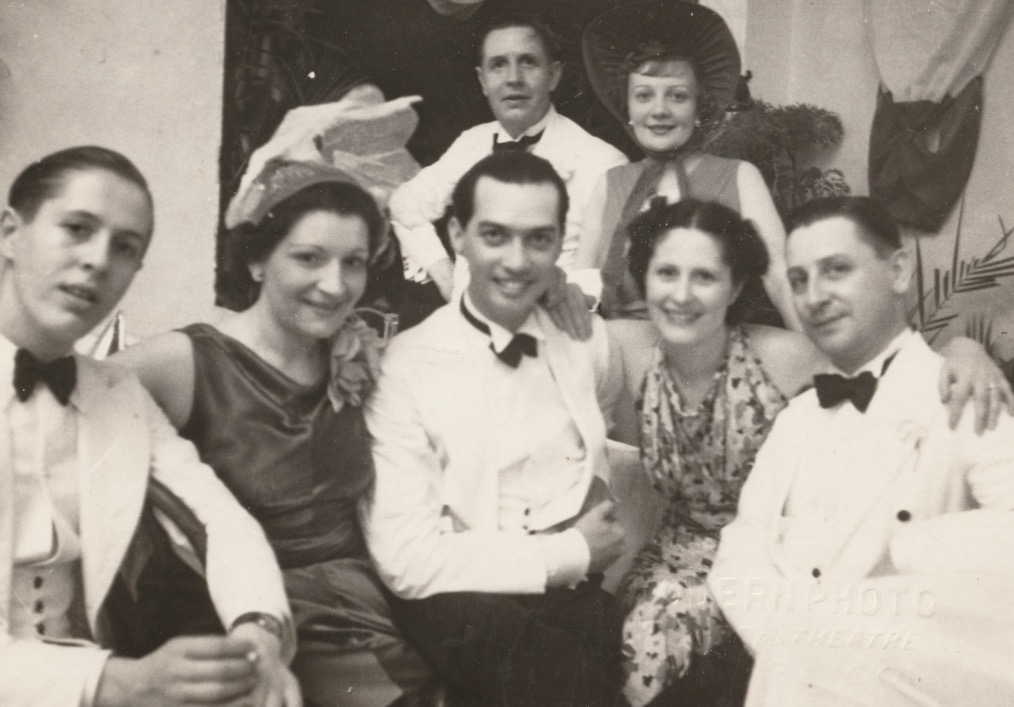
This joy was tempered by that fact that my wife's younger sister died in Vietnam of cholera. During the colonial period, diseases accounted for more than 10% of all hospital cases, and cholera was top of the list. And childhood diseases at that time had a 35% mortality rate. For those who may have a deeper interest, checkout this video on cholera between 1890's and 1930's in Hanoi.
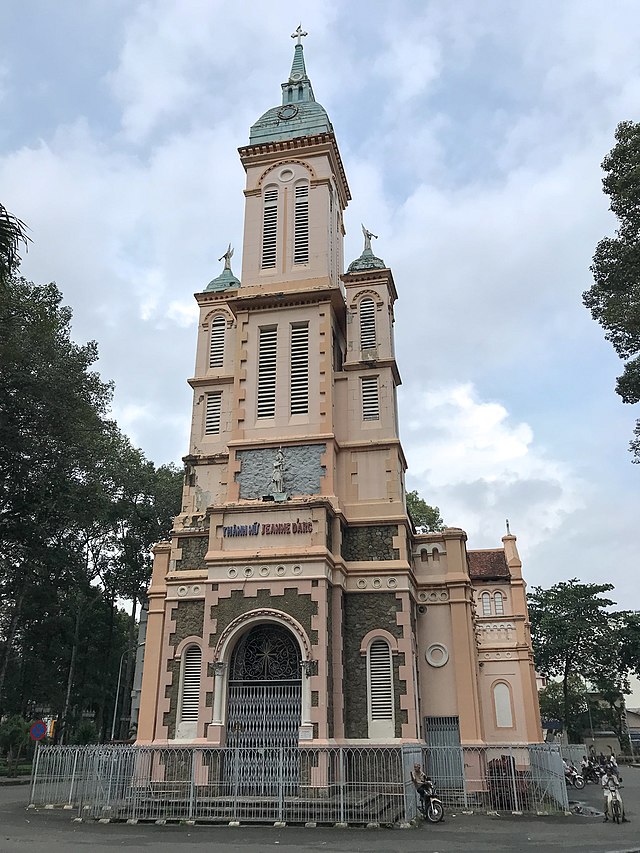
From what my wife remembers, 15 Bd. Charles Thomson was very near a church, which I am pretty sure must have been the Church of St. Joan of Arc (Nhà thờ Thánh nữ Jeanne d'Arc) at 116A Đường Hùng Vương, Phường 9, Quận 5, Thành phố Hồ Chí Minh (or in English 116A Hung Vuong Street, Ward 9, District 5, Ho Chi Minh City). The church has a Romanesque architecture style, and was built on a "grave field" or cemetery of overseas Chinese. It would appear that being in a more or less open area at the crossing of several roads has meant that it is now not considered totally safe and is often used as convenient parking spot, and more. It now has a fence and security doors as seen in the above photograph. In addition there is some controversy about the colour of the church, with some people preferring the original white.
My wife also remembers going to school at the Lycée Chasseloup-Laubat, now called Lê Quý Đôn High School (Trường Trung học Phổ thông Lê Quý Đôn) at 110 Nguyễn Thị Minh Khai. The Wikipedia article tells us that it was originally named after Prosper de Chasseloup-Laubat (1805-1873) who was a French politician who, amongst other things, organised an expedition to chart the navigability of the Mekong. Now the school is named after Lê Quý, an 18th-century Vietnamese poet, encyclopedist, and government official (including being minister war).
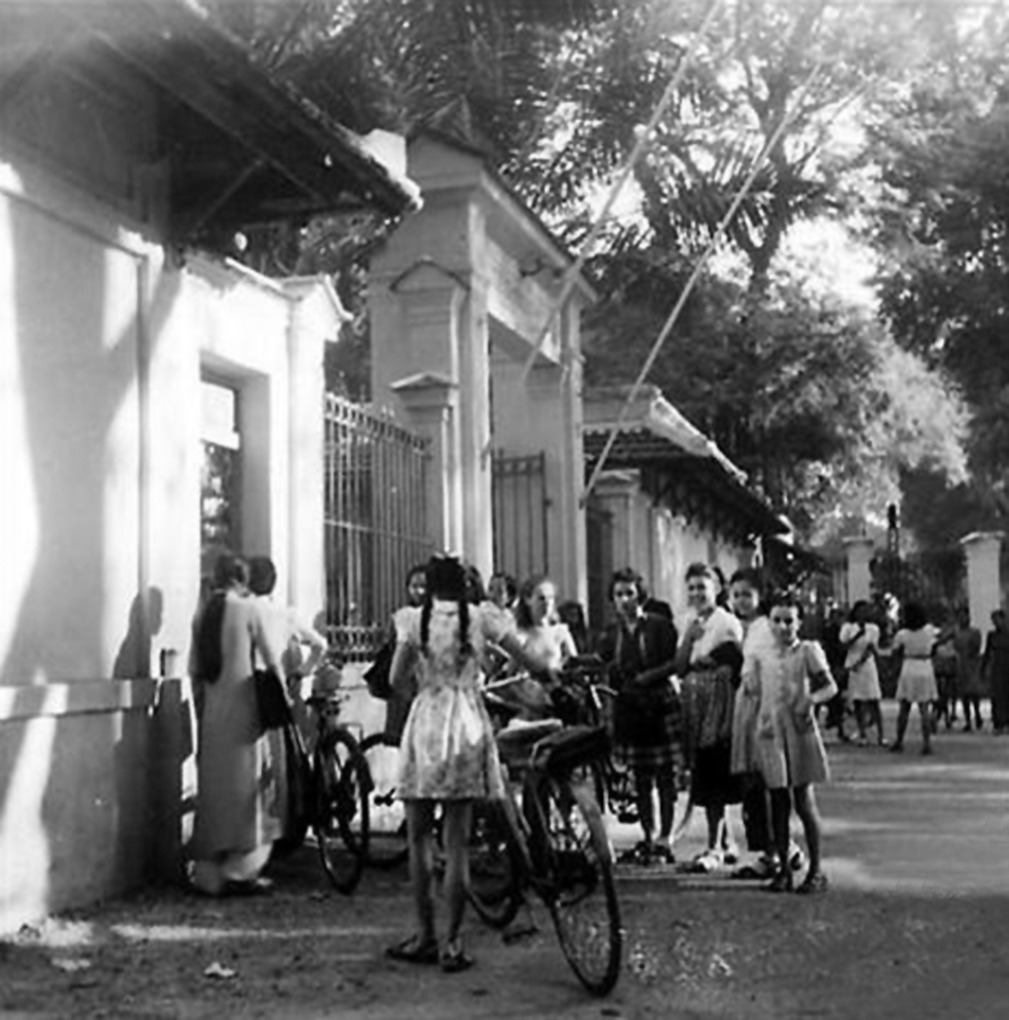
This article on Lycée Chasseloup-Laubat is far more readable and highlights how the school evolved to become one of the most prestigious in the region. It tells us that in addition to educating my wife, it also trained the Vietnamese revolutionary leader Trần Văn Giàu (1911-2010), the French novelist Marguerite Duras (1914-1996), the last South Vietnamese president General Dương Văn Minh (1916-2001), the King Norodom Sihanouk of Cambodia (1922-2012) and finally the historian Vương Hồng Sển (1926-1996). This article reminds us that it is still one of the oldest building in Saigon, and this article mentions Marguerite Duras and her novel l'Amant that described her affair when she was still a student at the lycée. Here is a more general description of the Chasseloup-Laubat Street (now Nguyễn Thị Minh Khai) which still runs right through the middle of Ho Chi Minh City (Saigon).
My wife remembers cycling back and forth to school (guided her older sister). It was about 4 km from their home in Cholon, but less than 2 km from her later address in Saigon. Near the end of WW II she distinctly remembers see prisoners of war working in the streets and on the railway and tramway tracks, and the kids would make a V-sign when the Japanese guards were not looking.
There was a prisoner of war camp in Saigon, at Jean Eudal Street (may be Nguyễn Tất Thành), and 200 metres from the river and 600 meters from the canal, i.e. in the Saigon port area. One report mentioned that the camp was an old French Foreign Legion Barracks. The same report mentions 1664 interned allied prisoners, 900 Dutch, 500 British, 209 Americans, 55 Australians (Indian troops were held elsewhere). See "Prisoner of War Camps in Areas Other Than the Four Principal Islands of Japan" (pages 60-63). In addition Tan Son Nhat Airport was built by the French in the 1930's, and during WW II, the Imperial Japanese Army used Tan Son Nhat as a transport base.
My wife was told that, whilst still living in Cholon, a Japanese officer took a particular dislike to the family dog, who would bark at any Japanese soldiers passing. It's quite possible that the dog barked at anyone passing, but in any case this officer threatened to kill the dog (but never did). It is said he took a chunk out of a kitchen table to demonstrate what he planned. No one liked the Japanese who were arrogant and violent to everyone. It would appear that the French installed a military tribunal in Saigon from 1945 to 1950 to judge what were called B- and C-grade war crimes (A-grade war crimes were judged in Tokyo). The End of Empire website looks at what happened in the 100 days following the bombing of Hiroshima, so from August to November 1945. There is also a Wikipedia page on the War in Vietnam (1945-1946), and Saigoneer also has two webpages on "When the Japanese Occupied Vietnam", Part 1, Part 2.
Historical context to Japanese occupation of Vietnam
Below is a summarised text on the Japanese occupation of Vietnam, which is followed by texts drawn from the Britannica on the conflict with Vietnamese nationalists. I include it here more as background since it does not impact directly on the story about my wife. Her memories of that period were those of a young girl caught up in things she did not full understand.
From early 1940, Tokyo began pressuring French colonial administrators in Vietnam, demanding that Japanese soldiers be allowed into the country to secure the Chinese border. These requests were refused until 1940 when soldiers from Nazi Germany invaded France. Within a month, the French government had surrendered and signed an armistice with Berlin. The French colonial government in Vietnam had little option but to concede to Japanese demands. An agreement signed in June 1940 allowed Japanese troops to control the northern border between Vietnam and China. Another, signed in August, acknowledged Japan’s rights and interests in south-east Asia.
On September 20th 1940 the French governor-general, Jean Decoux, signed an agreement with Tokyo giving the Japanese access to Haiphong harbour and allowing the placement of up to 6,000 troops in northern Vietnam. But the Japanese, dissatisfied with this agreement, broke it the following day. By midnight on September 22nd 1940, the Japanese invasion of Vietnam was underway. Japanese forces took just a week to secure control of Vietnam. By October 1940, there were around 10,000 Japanese soldiers stationed there, mainly around the ports, airfields and important industrial centres.
For most of their occupation, the Japanese left the French colonial government in place, though its authority was greatly diminished. This tactic contradicted Tokyo’s policy of "Asia for Asians" but at the time, Japan did not have the resources for a full-scale occupation of Vietnam. Instead, they preferred to leave the French in charge and develop Vietnam as a client state (at no point did Japanese troop numbers in Vietnam exceed 35,000 men).
Between 1941 and 1945, French colonial authorities in Vietnam, led by Decoux, engaged in a policy of 'co-existence' with the Japanese. Decoux’s administration mirrored the Vichy regime that governed occupied France in collaboration with the Nazis. In May 1941, Decoux granted Japan 'most favoured nation' status, meaning the bulk of Vietnamese exports were allocated to Tokyo at low prices. Later, Japanese troops were given unrestricted access to Vietnam’s roads, rail network and ports. This allowed them to use Vietnam both as a thoroughfare for the conquest of Thailand and Burma, and a staging point for attacks further south.
The Vietnamese people had mixed feelings about this dual imperialism. Some welcomed the arrival of the Japanese. They believed that domination by an Asian colonial power was preferable to domination by Westerners. Two notable Vietnamese religious groups, Cao Đài and Hòa Hảo, openly collaborated with the Japanese. Other Vietnamese considered the Japanese just another troupe of foreign imperialists, no different to the French. The Japanese made some effort to win the hearts and minds of the Vietnamese, a policy that differed from their brutality and oppression in China. Propaganda suggested the Japanese were in Vietnam as "liberators" rather than conquerors. Japanese language courses were organised in large cities. Japanese films, literature and poetry were translated into local languages. The Vietnamese people were told how Japan’s military supremacy was slowly driving the white imperialists out of Asia. While some Vietnamese drew closer to the Japanese, most believed Japanese imperialism would be the same, or even worse, than that of the French.
The Japanese presence in Vietnam also attracted foreign attention, particularly from the United States. In 1940, America was not yet at war with Japan but it was still working to restrict Japanese expansionism through Asia. The US also wanted to protect its imports of raw rubber, half of which came from Vietnam. At first, Washington backed the French colonial regime in Vietnam, hoping it would resist Japanese overtures. When Decoux and the French caved into Japanese demands, the US changed tack. The attack on Pearl Harbour and the US entry into the war in December 1941 changed things further. By 1943, Roosevelt was floating the idea of Vietnamese independence. The war in the Asia-Pacific sharpened Washington’s interest in Indochina. The Americans opened a military station at Kunming in southern China, while American advisers and Office of Strategic Services (OSS) agents supported both the Chinese Guomindang and Vietnamese resistance groups. The Americans also worked closely with Ho Chi Minh and the Viet Minh, who supplied the US military with information about Japanese troop numbers and movements. This was more a convenient working relationship than an alliance, but it gave Ho Chi Minh hope that Washington might support Vietnamese independence, once the war had ended.
By the start of 1945, the war was going poorly for Japan. Having surrendered the Philippines, the Japanese were in retreat across south-east Asia, relinquishing captured territory and incurring heavy losses. Tokyo had previously identified Vietnam as a fallback position for retreating Japanese troops because it could be more easily occupied, secured and defended. In March 1945, the Japanese occupation force, claiming French colonists were assisting the Allies, withdrew their support for the colonial regime. The French were removed from power in Vietnam. Every French colonial official or military officer was arrested and locked up, and all French soldiers were disarmed. The Japanese invited emperor Bảo Đại to declare Vietnamese independence and handed him the reins of power, though both were only nominal.
Shutting down colonial authority in Indochina only benefited the Viet Minh, which flourished without pressure from French troops. Ho Chi Minh condemned the Japanese occupation and declared the Japanese his "number one enemy", but he resisted calls for a major Viet Minh campaign against them. Knowing the Japanese were in retreat and that a major Allied attack against them was imminent, he preferred to wait. By June 1945, Ho Chi Minh felt strong enough to establish a Viet Minh-controlled zone in north-western Vietnam. This region was remote and had no strategic significance to the Japanese, so they did not launch any major campaigns against it. Through the middle of 1945, the Viet Minh busied itself with organisation, propaganda and recruiting. Ho Chi Minh also had to deal with food shortages and famine, which were widespread in the North. The Viet Minh movement consolidated its hold in the North and began to spread into central Vietnam, gaining 100,000 new recruits. By the start of August 1945, the Japanese were on the verge of defeat and the resistance movement was stronger than ever. Viet Minh cadres began seizing control of Japanese-held villages and towns. In early August 1945, the US dropped atomic weapons on the Japanese cities of Hiroshima and Nagasaki, attacks that would lead to the Japanese surrender.
After WW II negotiations between the French and Ho Chi Minh led to an agreement in March 1946 that appeared to promise a peaceful solution. Under the agreement France would recognise the Viet Minh government and give Vietnam the status of a free state within the French Union. French troops were to remain in Vietnam, but they would be withdrawn progressively over five years. For a period in early 1946 the French cooperated with Ho Chi Minh as he consolidated the Viet Minh’s dominance over other nationalist groups, in particular those politicians who were backed by the Chinese Nationalist Party.
Despite tactical cooperation between the French and the Viet Minh, their policies were irreconcilable, the French wanted to reestablish colonial rule, while Hanoi wanted total independence. French intentions were revealed in the decision of Georges-Thierry d’Argenlieu, the high commissioner for Indochina, to proclaim Cochinchina an autonomous republic in June 1946. Further negotiations did not resolve the basic differences between the French and the Viet Minh. In late November 1946 French naval vessels bombarded Haiphong, causing several thousand civilian casualties, the subsequent Viet Minh attempt to overwhelm French troops in Hanoi in December is generally considered to be the beginning of the First Indochina War.
Initially confident of victory, the French reunited Cochinchina with the rest of Vietnam in 1949, proclaiming the Associated State of Vietnam, and appointed the former emperor Bảo Đại as chief of state.
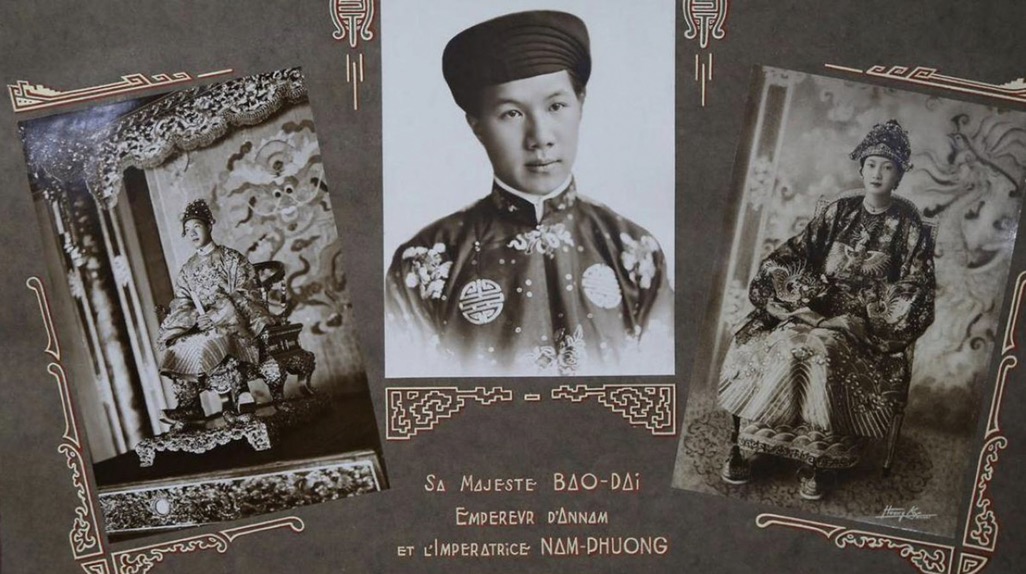
Most nationalists, however, denounced these manoeuvres, and leadership in the struggle for independence from the French remained with the Viet Minh. Meanwhile, the Viet Minh waged an increasingly successful guerrilla war, aided after 1949 by the new communist government of China. The United States, fearful of the spread of communism in Asia, sent large amounts of aid to the French. The French, however, were shaken by the fall of their garrison at Dien Bien Phu in May 1954 and agreed to negotiate an end to the war at an international conference in Geneva.
In 1945, back in Paris, the authorities were still proud of their colonial domains, declaring that France was a nation of 110 million inhabitants, by adding the 70 million inhabitants of their "possessions". But they were beginning to realise (finally) that the sovereignty of France was being contested, and that some "colonised peoples" aimed for complete independence. They knew that French Indochina was claiming more or less complete autonomy but many thought that they seemed "hardly capable of governing and perfecting themselves and they would no doubt quickly return to decadence if the interaction of the France disappeared".
Yet many still thought that "French Indochina is the most beautiful jewel of our Empire. The effort that the French have made there since sixty years, seconded by intelligent and laborious indigenous people, is a prodigy and the results obtained have struck admiration of all foreigners who have visited this country between 1918 and 1940. It was French sovereignty that really made 1862 to 1897, date of the creation of Indochina, of heterogeneous countries and various peoples - Annamites, Cambodians, Laotians, Moïs - a solid whole with an area exceeding by one-third that of the France and currently populated by 23 million inhabitants, a population which is increasing rapidly and which will probably equal that of France in a new cycle of sixty years".
This was a time to "sell" the successes of France. In less than fifty years the Cochinchina had increased by 1½ million tons its exports of rice. "She" could never have done this without the 2,000 km canals dug with French investment. Beautiful cities such as Saigon, Cholon, Dalat, Phnom-Penh, Haiphong, and Hanoi, were claimed to have a very French stamp, to which France had added 2,908 km of railways and 26,000 km of beautiful paved roads. Rubber plantations and the mining industry were seen as "dazzlingly brilliant demonstrations of French initiative". In Cochinchina and in Cambodia 127,000 hectares of rubber trees were "conquered from the jungle", and with rubber production reached 70,000 tons in 1939 it "sufficed for the complete supply of the metropolis in this basic necessity". The tea plantations in the mountains provided 2,000 tons of excellent tea exported to France, and 10,000 hectares were devoted to the cultivation of the coffee tree. Cambodia provides all the pepper France needed. In 1937 the mining deposits of Indochina were traded (export and import) for more than 4 billion French francs, including more than 2 billion with metropolitan France.
We should not ignore that in 1939, Franco-indigenous public education reached as far as primary and upper primary education, so a total of 646,700 children (but still 80% of the population was illiterate). Vocational education was offered in 32 schools and secondary education in 48 establishments. In three high schools (Saigon, Dalat, Hanoi) teaching was provided in French, but they had also created a native baccalaureate. A University existed in Hanoi, including a school of medicine and pharmacy, a law school, a school of Fine Arts, a school of public works, and finally a school of agriculture and forestry (but it was only for an elite of 5,000 students). In 1939 there were 833 health units, 26 hospitals (10,000 free hospital beds were mentioned), 104 medical centres, 170 infirmaries, 196 dispensaries, 221 maternities, 11 leprosaria, and 4 Pasteur Institutes. The fight against epidemic diseases such as smallpox, typhus, malaria, plague, and cholera was being won through massive and systematic vaccination campaigns.
Some intellectuals thought that the France still needed to integrate the Indochinese federation into a greater French Federation, in the same way as Russia had integrated its associated socialite republics of Asia in to their great organisation I'.R.S.S., "which gave them victory and saved civilisation". Some respected academics argued for the need to recognise that Indochina should have quasi-autonomy, by making it a true second metropolis having its own economic unit, its own particular laws, its own languages, "with French only being offered to the elite". They argued that formerly it was the economy which prevailed over human needs, but that in the future French natives and Europeans must have exactly the same rights. They recognised that it was necessary to improve considerably the living conditions of the natives and especially of the mass of the people who, for the vast majority, were still undernourished, clothed "only in rags", and sheltered under "lamentable huts".
The above "rose coloured" analysis ignored the fact that Indochina was a colony of exploitation and not of settlement. It was true that the French aimed to develop a 'rich' economy through concessions for rice, coffee, tea, and even silk worms. The Banque d'Indochine, both a commercial bank, an investment bank and a financial company, founded in 1875, dominated the economic development of the colony. By 1937, she was a stakeholder in almost all Indochinese economic enterprises. Metropolitan investments exploited mining, rice cultivation, rubber, tea and coffee plantations, as well as certain processing industries, such as cement works, textiles, manufacturing tobacco, and rice alcohol distilleries (choum). The coal basin of Hon Gai, in Tonkin, with its 30,000 workers, was a major exporter of coal in Asia. In Cochinchina, the surface of the rice fields of the Mekong delta was increased sixfold, and by 1933, Indochina had become the world's second largest exporter of rice, which accounted for 60% of foreign trade earnings. This was the reality in Paris, Indochina was a colony to be exploited, not settled.
And the Japanese coup of March 9, 1945 dealt a fatal blow to the French presence in Indochina by causing the elimination of the French administration and army. It destroyed the administrative and social network patiently woven by several decades of colonisation, entire areas of the country were delivered to anarchy. By ordering the reconquest of Indochina, General de Gaulle wanted to give back to France all the elements of its greatness lost by the defeat of 1940. The objectives of the reconquest were in total mismatch with the realities on the ground, just like the means implemented to achieve them. Originally, the French Far East Expeditionary Corps was planned to liberate Indochina from the Japanese. But, on their arrival in October 1945, they then had to face, not the already defeated Japanese, but the Indochinese who had proclaimed their independence. Moreover, the international context was very unfavourable, since the Americans, Chinese and Japanese had all agreed to eliminate France from Indochina.
The family moved to Saigon
Sometime between December 1943 and the end of WW II my wife's family was obliged to move to Saigon for their own safety, and they were welcomed by their friends, the family Carlier.
My wife remembers that at the end of the war, different families received POW's to help them recover. She remembers her host family, the Carlier, receiving individual POW's for a short periods, and she still remembers as a child helping to feed Australians and Dutch who survived but were very thin and weak.
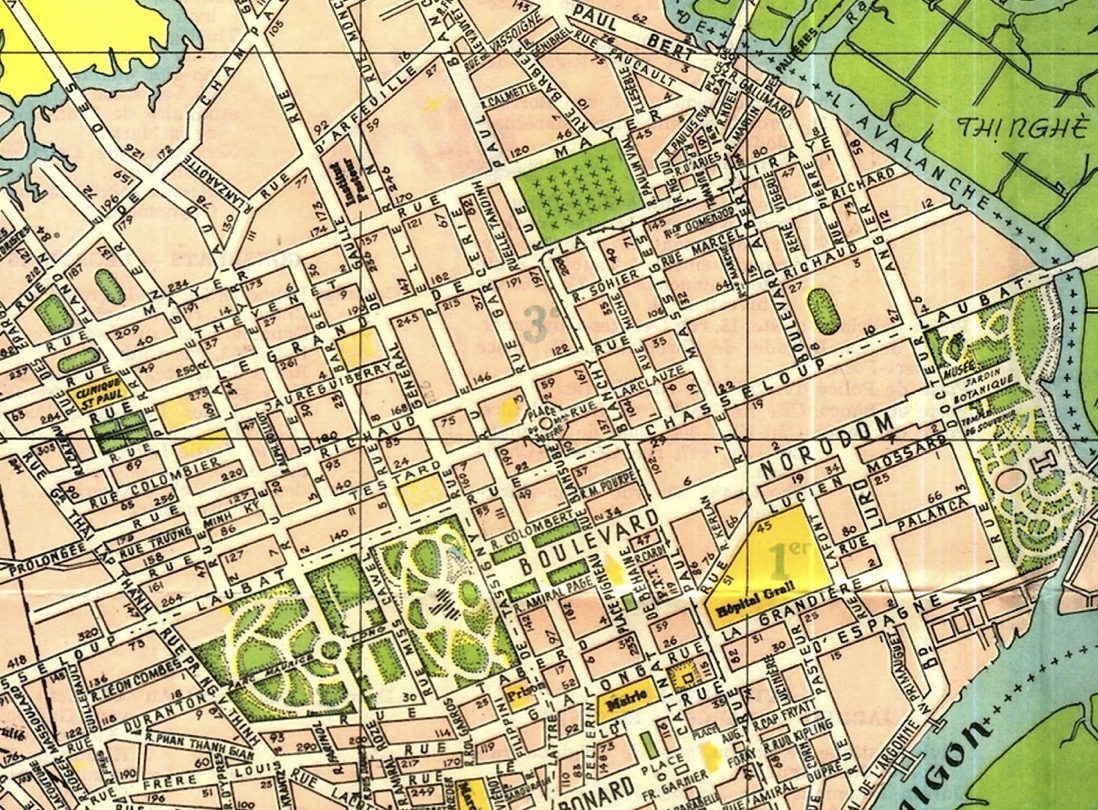
Once in Saigon, the family clearly decided not to return to Cholon. Their new address became 12 rue Paulin Vial in Saigon (middle-upper box), now called Phan Liêm, Đa Kao, Quận 1, Thành phố Hồ Chí Minh.
Paulin Vial was résident général of French Indochina between 1886-1887. A résident général was the official representative of a colonial power practicing indirect rule. Despite the role being a political adviser seconded to a local sovereign, the reality often made them the real head of state.
Despite Paris being "still proud of their colonial domains" in the period 1938 to 1944, Vietnam, like many other southeast Asian countries, was seeing one of modern history's deepest macroeconomic crisis. Real per capital income fell by nearly 50%. Japan as an occupier only used a fraction of the rice, rubber, tin and sugar produced, and at the same time it monopolised local transport (add to that the bombing of bridges, rail lines, etc. by the Allies). Vietnam found itself a net importer of textiles, shoes, sandals, matches, paper, batteries, light bulbs, medicines, etc. And in Saigon-Cholon the population rose from 256,000 in 1936 to 500,000 in 1945 (by 1949 it would be 1.2 million). The net result would be the Vietnamese famine from October 1944.
The cost of living increased substantially in the period 1941-43, even for the French living in Indochina, but above all it hit the local working population the hardest. For them the cost of living rose by a factor of four from 1939 to 1943, with the Japanese stockpiling matches, sugar, soap, cigarettes, chickens, etc. and then selling them locally at excessive prices. From 1942 butchers were closing at least one day per week, and there were no chickens or fish for one-two days per week. The local government forced merchants to indicate their stocks of essentials such a paper, alcohol, etc., and they tried to limit price increases (but were not very successful). Also in 1942 the local government had to increased wages of the military by 42% and civil servants by 13%. Rents increased by 250% in the first 6 months of 1941, in part because the Japanese were commandeering buildings. After 1944 rationing was introduced for milk, bread, rice, medicines, etc. Everyone was complaining, the French were accusing locals for preferring the Japanese, locals were accusing the military because they had a right to more rations, and the French civil servants were complaining because they had nothing but their wages to live on. In a report from 1944 the lowly civil servant had become the new poor of Indochina, whereas the once modest Indochinese artisans were the new rich. A more realistic analysis noted that many complaints were more about the loss of past privileges, and others also noted that conditions in occupied France were far worse.
One analysis looked at the increase in the cost of living from 1932 to 1943. It noted that the cost of living increased by around a factor of three for Europeans and the local middle class, whereas for the local worker it rose by nearly a factor of five. As a point of comparison the cost of living increased by 'only' about 60% in the forty years preceding the French Revolution, and the true turning point came with the second poor harvest of 1789, with real wages falling by another 25% and the price of bread nearly doubling.
During WW II the French in Indochina were still better paid than the local community, but they were now obliged to present a "Déclaration de non-appartenance" to les francs-maçons (freemasons), and denouncing a Gaullist was worth 10 to 200 piastres, and even more if it involved someone trying to cross the Chinese boarder to join the movement Gaullist. The press was obliged to print the declarations of Pétain, and his bust or photograph was an obligation in every shop. French civil servants that were non coopératif were mutated to Hanoi. The Vichy ideology was intense and oppressive, and the French anti-Jewish law was also introduced in Indochina in early 1942. Evidently all would change with the fall of the Vichy regime, Pétains' busts disappeared, and Radio-Saigon started to qualify the Germans as the enemy.
So it's not surprising that sometime after December 1943, despite being highly integrated into the local environment in Cholon, the family felt increasingly unsafe, and moved to Saigon.
My wife's father, Paul Car…, after completing his military service, joined the Service techniques de la Ville de Saigon, where he rose to being Contrôleur du Service des Eaux. The Service des eaux et assainissement de la Cochinchine was created in 1931 with the task to monitor and control existing facilities, study the construction of new facilities, develop water purification, and study projects for deep catchments. I'm guessing that as a civil servant he was responsible for controlling water distribution and sanitation, so both the provision of water and the treatment of wastewater, presumably by service companies such as Compagnie des Eaux et d'Electricité de l'Indochine.
I've seen a few figures concerning salaries for posts in Hanoi, and I understand salaries were higher in Saigon. In 1918 a contrôleur de l'Eclairage et des Eaux in Hanoi could earn 3,500 and 10,000 francs per year depending on time in the service.
So lets' look at the water situation in both Cholon and Saigon. The common feature was that both were conditioned by the rise and fall of the tide (more or less 2 metres), and the water in the river was still salty. The countryside was flat and both Cholon and Saigon were (and still are) only a metre or two above the level of the river and the sea. The general approach was that both urban areas had a central pumping station connected to wells both within the city limit and outside (the first collectors for drinking water were completed in Saigon in 1897). Each had large cistern at the pumping station and water was pumped into sheet-iron reservoirs set at about 20 metres above sea level. Distribution was then by gravity. Basically customers had to pay for the installation and maintenance of their connection, as well as for the water consumed according to a meter. The only difference between Cholon and Saigon, was that Saigon had more wells and reservoirs. According to a report for 1915, in neither case was the water filtered. The water from the wells passed through a layer of sand at the bottom of the well before entering the network, so the water was unsafe unless boiled. In fact a different report concluded that "The water of the Saigon river is obviously unfit for consumption, in its raw state. To become drinkable, it must be clarified, filtered and sterilised, however, after this treatment, it would remain of mediocre quality. This water, like all the waters of the other rivers of Cochin China, is, in fact, endowed with a corrosive action due to its acid reaction and has no nutritive power because of its lack of mineral salts".
Almost everywhere you looked there was advice concerning water. It was even noted that boiling the water was not enough to kill all the germs, and the "filtre Chamberland á bougies a été reconnu particuliérement efficáce", which is a treatment using "alun" or potassium alum. We must remember that the list of potential illnesses, some fatal, was long, including choléra, dysenterie, fiévre bilieuse hématurique, fiévre paludéenne, lépre, morsure de serpent, peste (cholera, dysentery, blackwater fever, malarial fever, leprosy, snakebite, plague).
In 1923 one author noted that it was too expensive to hide reinforced concrete, or the skeleton of a metal frame, "under the rich clothes of cut stone, the draperies of mouldings and astragals", and that people had to accept hideous reservoirs which were popping up almost everywhere, "like gigantic mushrooms and which, despite all my efforts to try to hide their natural ugliness a little, always look like big toads perched on stilts".
This same author was able to describe an example of one installation in Saigon. The hydrostatic well was 2.80 metres inside diameter and 20 metres deep, made with masonry rings resting on a cast iron wheel. The filter basin was a huge vaulted underground room of 120 metres long by 12 metres wide and 9.50 metres high, divided in the middle by the hydrostatic well. The walls were made of pillars supporting the vault and dry stone walls down to the ground. The floor was about 12 metres below the roadway. The pillars supporting the vault were connected at about 4 metres in height by "arched spacers forming a stop against the thrust of the earth". This room was accessed by two traps located on either side of the hydrostatic well, and whose covers were surmounted by two small kiosks.
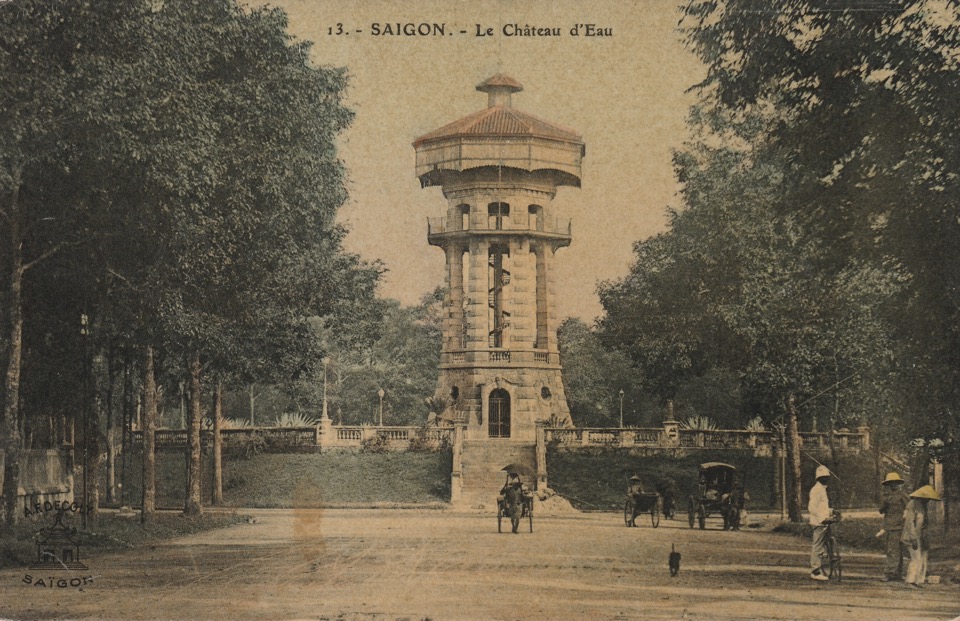
The water tower was a sheet metal tank of 100 cubic metres supported at 20 metres height by eight masonry pillars constituting an octagonal tower, rising above a base covering the pump room. The cover was a kind of Chinese hat in tiles, on a wooden frame surrounded by a canopy also in wood. A revolving metal staircase, located in the centre of the tower, provides access to the cellar.
Both water and electricity networks were run by Compagnie des Eaux et d'Electricité de l'Indochine, a French company based in Paris, who in 1900 had taken over the three principle concessions in Indochina (water in Cholon and Saigon, and water and electricity in Pnom-Penh). They took over the electricity concession in Cholon in 1909, having already bought the electricity concession in Saigon from Societé d'Electricité de Saigon. They then constantly renewed the concussions, with increased tariffs. However, the installations belonged to the cities, so for example, it was Saigon that had to drill and equip new wells, etc.
In 1932 Saigon-Cholon approved a new concession for Compagnie des Eaux et d'Electricité de l'Indochine for 35 years. This covered the distribution of electricity, including for lighting and ventilation, in the cities of Saigon and Cholon. Under the terms of this contract, the Compagnie bought the electricity plant from the city of Cholon, which was then placed outside the concession, thus allowing the Compagnie to produce or acquire energy as it saw fit (naturally it had already built a new plant). In addition they agreed to gradually transform the central part of the city of Saigon to alternating current. Its interesting to see the extent of the concessions accorded to Compagnie des Eaux et d'Electricité de l'Indochine, for example, the concession for water and electricity in Saigon-Cholon and Pnom-Penh was extended to 1967, already in 1952. For 1954 the Compagnie declared a net profit in excess of 1 billion French francs. In 1958 the electrical installations of the Compagnie were sold to the son of the reigning monarch of Cambodia, remembering that the Compagnie was already a major distributor of electricity in that country.
It must be said that an analysis performed in 1937 showed that the price of electricity in France, even in the largest cities, whose consumption easily exceeded that of Hanoi, was generally more expensive. The same analysis showed that electricity was also less expensive in Hanoi than in Alger, Dakar, and Fort de France.
It was interesting to note that the Compagnie was legally obliged from 1st January 1937 to introduce an 8-hour day, and from 1st January 1938, paid holidays.
In May 1949 my wife's father became Contrôleur hors classe des Service Technique de la Region Saigon-Cholon, and Contrôleur Principal hors classe des Service Regionaux.
I have almost no idea what a Contrôleur hors classe des Service Technique did, but I'm certain in the 1940's in Saigon it did not include "piloting the management team", "implementing the service's mission", "studying the continuous improvement of business processes", "representing the region vis-à-vis a large number of interlocutors", or "participating in the transversal and structuring actions of the management". But I guess it might have involved managing a group of people doing maintenance work and repairs, so man-management, respect of rules and regulations, logistics, control, help and training, administration, management of crises, etc. Who knows?
I've seen that in some modern administrations there are Contrôleur hors classe 1er up to 11éme échelon, so it looks as it the scales have been inverted, i.e. 1er is no longer the top, its at the bottom.
Scanning though the "past" I've seen that there were a multitude of 'lower' grades, e.g. contrôleur principal, contrôleur, commis, administrateur, etc. and that it's impossible to know the hierarchal relationship between Surveillant principal hors classe and Contrôleur 4e classe. I've no idea about the hierarchy, nor the way 'grades' progressed, nor the pay grades, etc. In the area of public works there was no mention of the contrôleure, so I presume that type of post was specific to the regional administrations.
I think it must have become evident in the years following WW II that French nationals living in Vietnam would have had to start considering how best to return to France. I would have thought the massacre of dozens of French and French-Vietnamese men, women and children on 24-25 September 1945 and the subsequent fighting, and later the Battle in Hanoi in December 1946, were sufficient to convince anyone that it was time to leave. However, I might add that my wife's uncle remained in Vietnam until he retired in the early 1980's, and upon returning to Nice bought an apartment in the same building as his brother.
Those final years were certain not all negative. My wife continued her schooling, and became a passionate netball player (she would end up finishing her schooling and taking her baccalauréat back in France). My wife's sister would celebrate her marriage in Saigon Cathedral. But, as far as I can tell, by mid-1951 the entire family had moved back to France.
The sinking of the MS Georges Phillippar
I mentioned earlier that my wife's older sister had had a lucky escape, but what could that be? My wife was not even a glimmer of a thought in the minds of her parents, however her older sister was a very real bouncing baby.
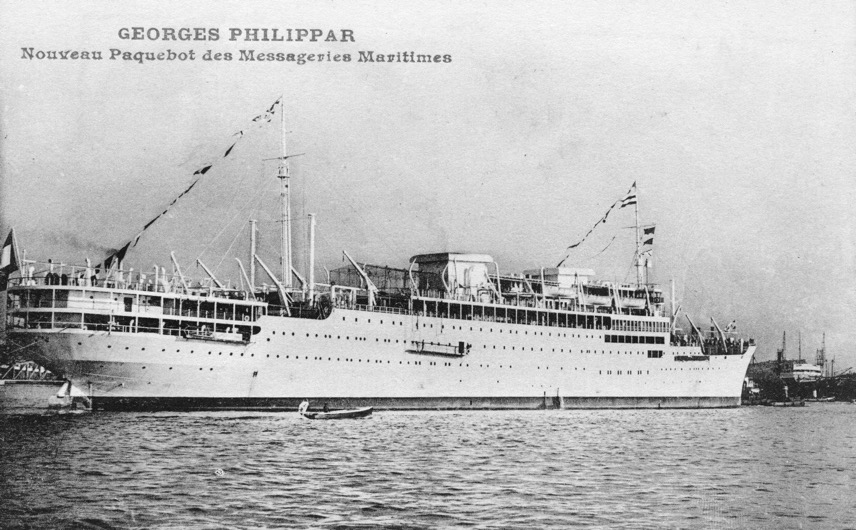
In 1932 the family were travelling back to France on the MS Georges Philippar, a brand new ocean liner. An ocean liner that was sold as being the best in safety and luxury fittings, and as unsinkable as the … Titanic.
The ship caught fire and sank in the Gulf of Aden. My wife's parents were (I think) enjoying a late night, when the fire alarms went off. They were more or less pushed into a lifeboat, and fortunately (so the story goes), my future wife's little sister was passed through a porthole. In any case all three were picked up and landed safe and sound.
My wife's maternal grandparents, had retired, and were also taking their last trip back to France. They also survived, but their entire collection of (uninsured) possessions, etc. were lost.
Whilst my wife's sister had the good fortune to be saved in 1932, she was less fortunate when later her husband was killed in a crash whilst flying for Air France.
References
There are a number of websites that were extremely valuable, namely:-
The BnF has on Gallica a series of Annuaire général de l'Indo-Chine for the years 1900-1937. For example, for 1906 the annuaire contains an extensive description of all the treaties and agreements made in the region.
There is a website called Les entreprises coloniales françaises which has a section on Indochine with a massive collection of documents covering almost every imaginable subject under the sun, e.g. Guide Historique des Rues de Saigon, Société Française des Distilleries de l'Indochine, Port de Commerce de Saigon, etc.
To make an estimate of the purchasing power of some salaries from the early 1900's I have used this historical currency converter.
There is a Flickr maps collection for Saigon-Cholon which proved to be very useful in finding roads, and working our what they are called today. This just a small collection of someone called 'manhhai' who has a massive Flickr collection of historic photographs of topics such as the Vietnam War, and nearly 10,000 photographs pre-1975.
Check out the research blog at Mémoires d'Indochine.
Saigoneer is a very substantial collection of short articles on Saigon, Vietnam and more generally Asia. I've focused only on Saigon-Heritage, which is already a mine of information and photographs. For example, two webpages look at Saigon’s Famous Streets and Squares, Part One, Part Two. Other interesting webpages were:-
Trần Hưng Đạo Boulevard and the route Haute and route Basse between Saigon and Cholon
Hai Bà Trưng (rue Impériale) this long straight road passed near the European Cemetery, which was also near my wife's last address in Saigon
Lê Duản (Boulevard Norodom)
Quách Thị Trang (Place du Marché and from 1916 Place Eugène-Cuniac)
Hùng King Temple at 2 Nguyễn Bỉnh Khiêm (Temple du Souvenir Annamite)
Notre-Dame Cathedral where my wife's sister was married
Hôtel des Amiraux-Gouverneurs in Saigon (from 1862)
Saigon's Canal de Centure (from 1862)
École de Sainte-Enfance in 1864
Cercle des Officiers in 1876
Saigon Cathedral (1877-89)
Saigon's Tramway (from 1881)
Saigon–Mỹ Tho railway line (1885)
Hôtel and Café de la Musique in the mid-1880's
Société d’Électricité de Saigon from 1896
Grand-Théâtre de Saigon in 1900
Saigon's Pont Tournant (1902-03)
Huyen Sy Church in Saigon (built 1902-1905)
Casino de Saigon in 1910
Vietnam Railways Building in 1915
Cercle Sportif Saigonnais from 1925
Lycée Pétrus Ky in Saigon (1927-1945)
Grand-Hôtel de Saigon in 1930
Ernst Thälmann Secondary School (from 1931)
Pont Tripode in 1941
Japanese Surrender (1945)
Indochine cartes postales anciennes - many sights of old Saigon, etc. are known through postcards
Journal d'Indochine 1959-1951 - a photograph collection of gendarme Bernard Crombèke
Historic Vietnam - a substantial series of webpages posted by Tim Doling, a historian based in Vietnam
Saigon Modernist - about modern architecture in Asia (no longer updated from end-2021)
L'Indochine Coloniale - an informative amateur website focussed on Indochine before 1955
Vietnamnet (in Vietnamese), just use Google Translate
And here are some of the documents that I found interesting:-
Historical Dictionary of the Indochina War (1945-1954)
In the Year of the Tiger: the War for Cochinchina, 1945-1951
CIA and the Generals - Covert support to Military Government in South Vietnam
Impossible Indochina - Obstacles, Problems, and Failures of French Colonial Exploration in Southeast Asia (1862-1914)
The Lessons of the Vietnam War
Vietnam - a country study
Les Colonies Françaises (pages 95-116)
The Making of Saigon from the Nguyen Lords to 1954
Colonial Cholon and its 'Missing' Metisses (1859-1919)
Cholon’s urban evolution, 1879–1930: State, Locals, and Trans-locals
The Heaven and Earth Society Upsurge in Early 1880s French Cochinchina
Bonded Labour - Global and Comparative Perspectives (18th–21st Century)
The Joint Chiefs of Staff and The First Indochina War (1947-1954)
Cholon’s urban evolution, 1879–1930 - State, Locals, and Trans-locals
Exchange Rates and Exchange Rate Policies in Vietnam Under French Rule, 1878-1945